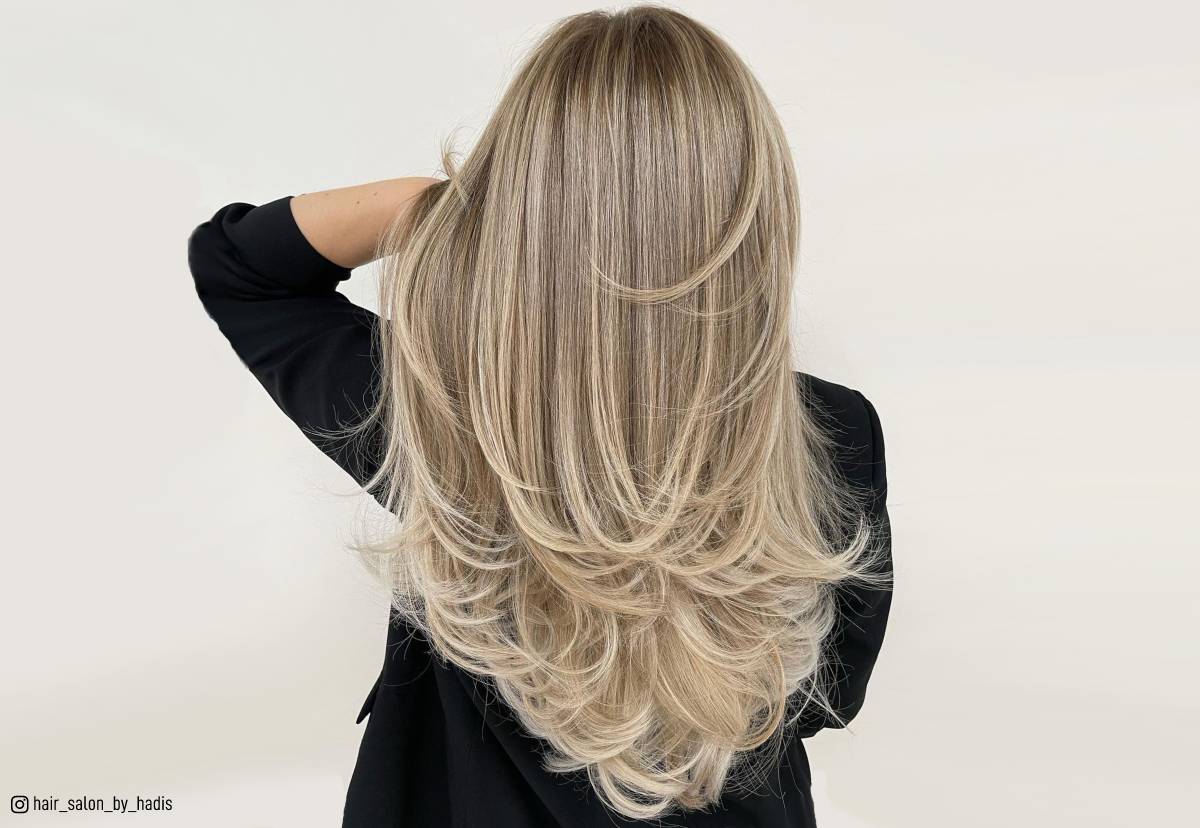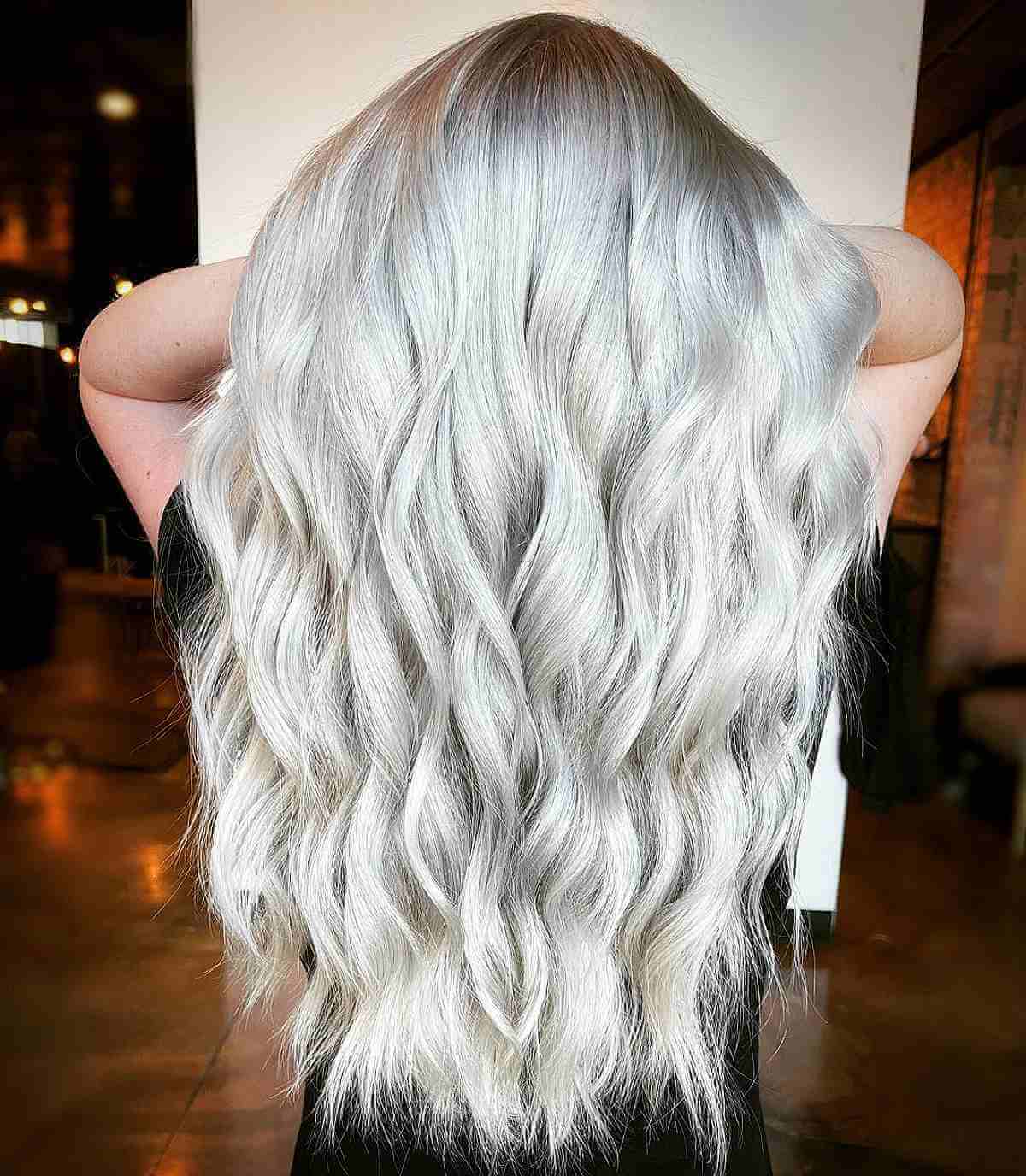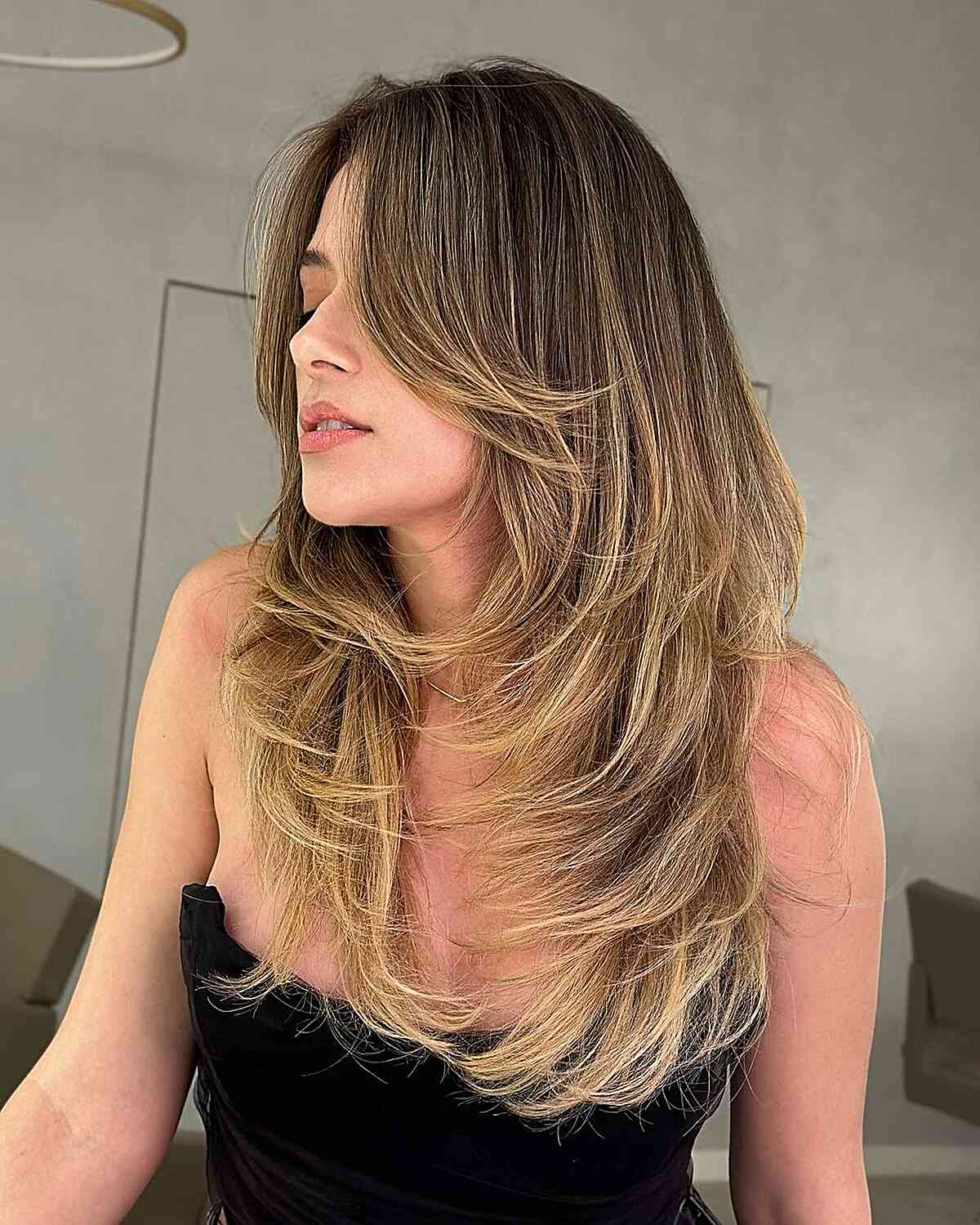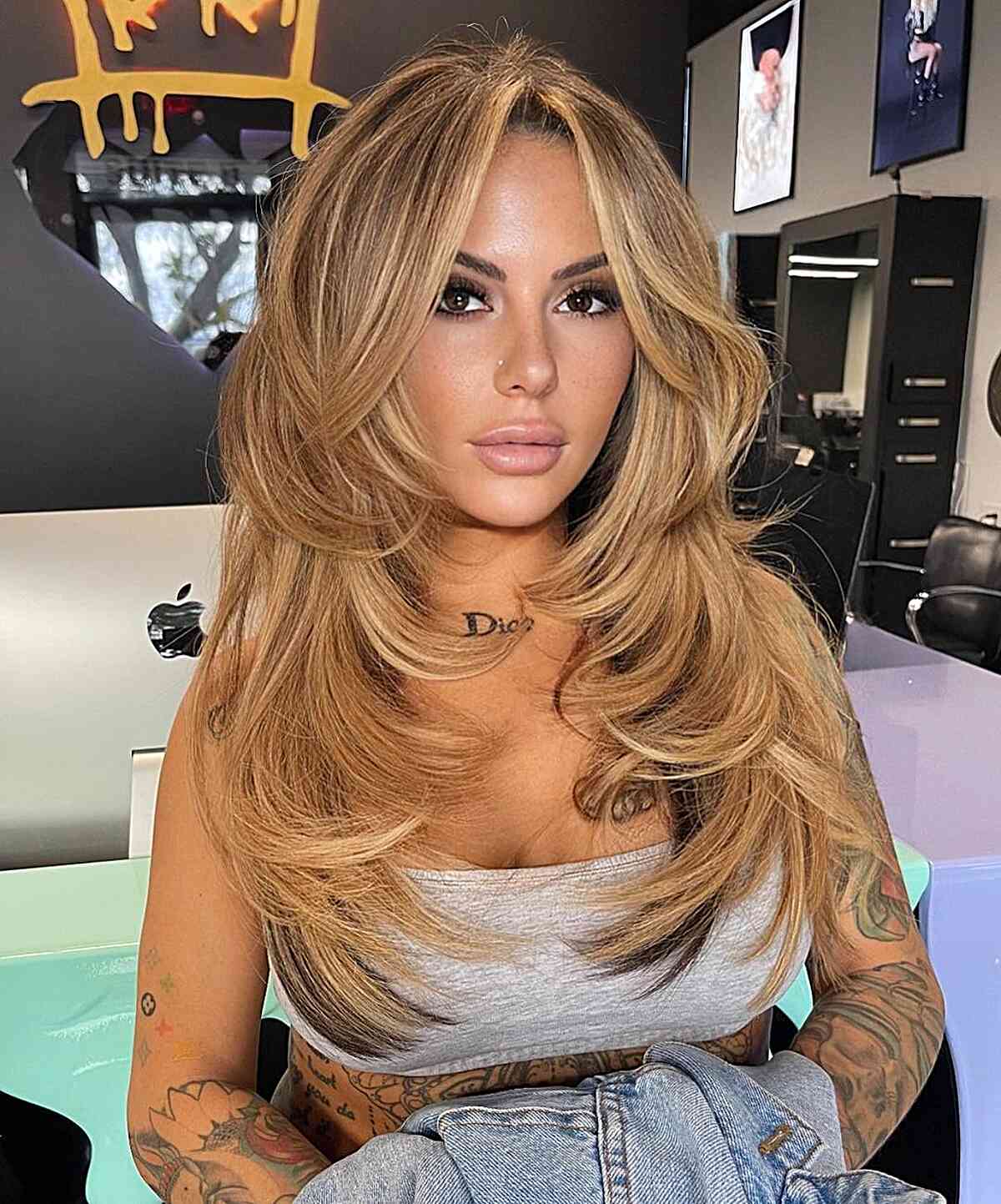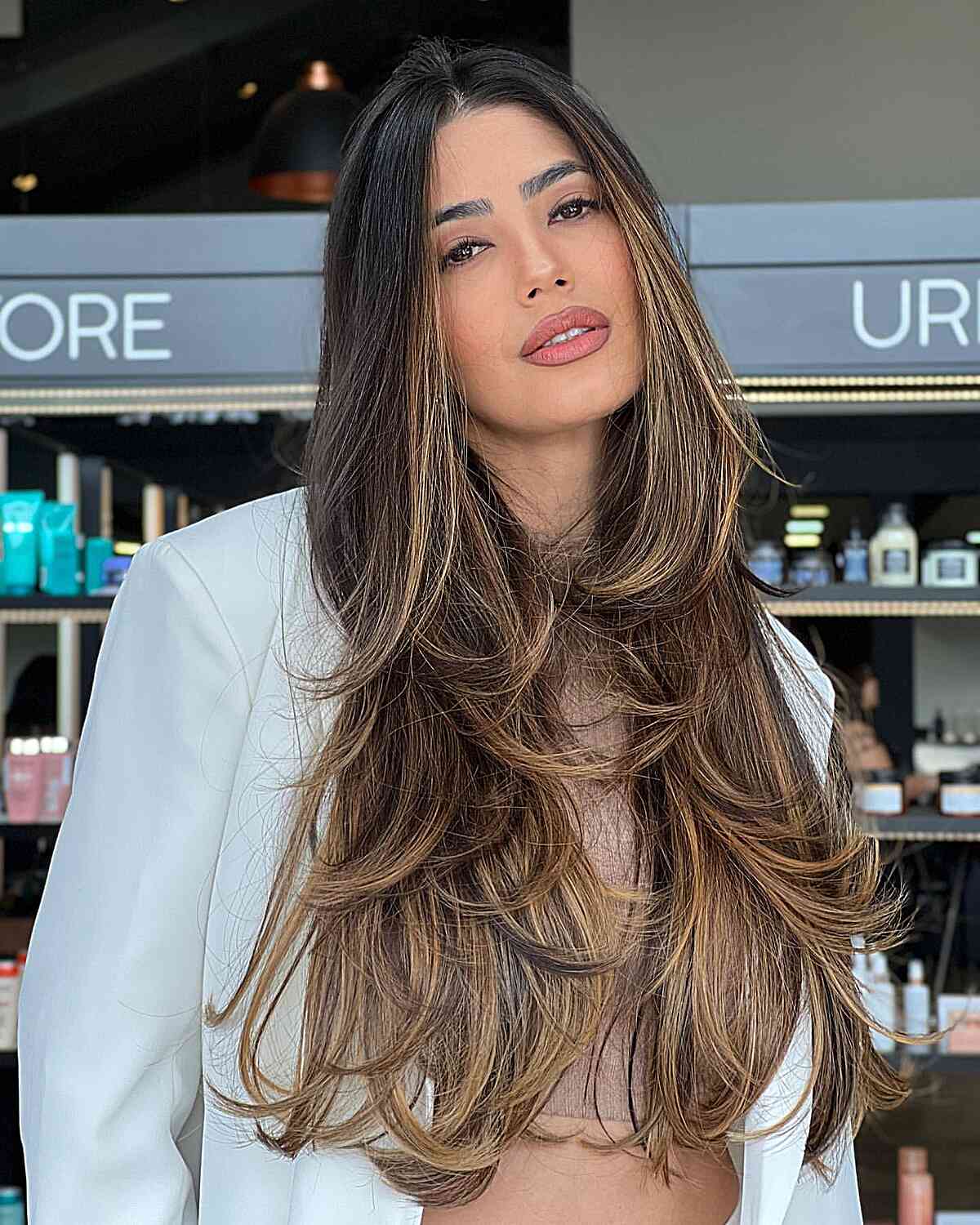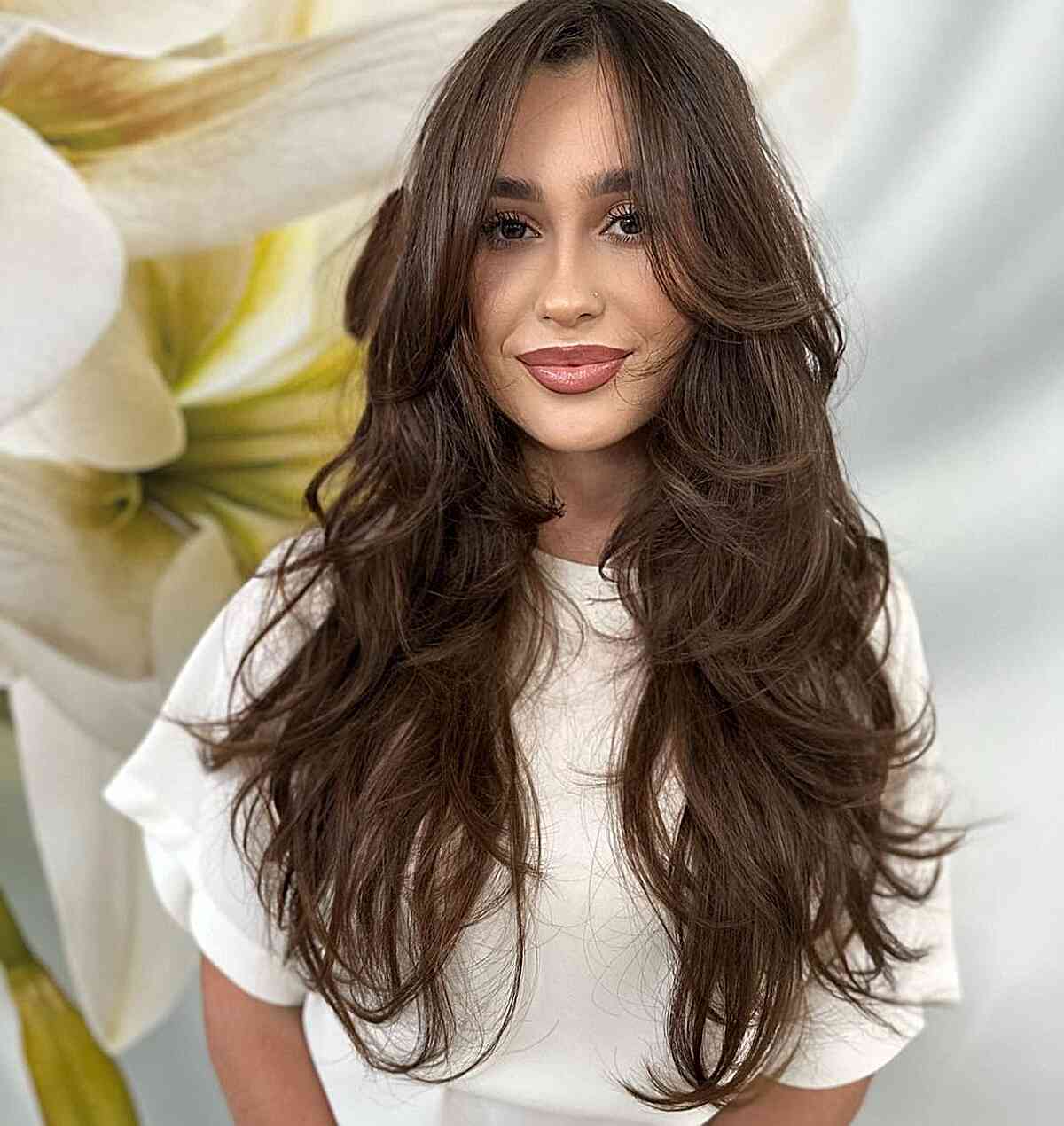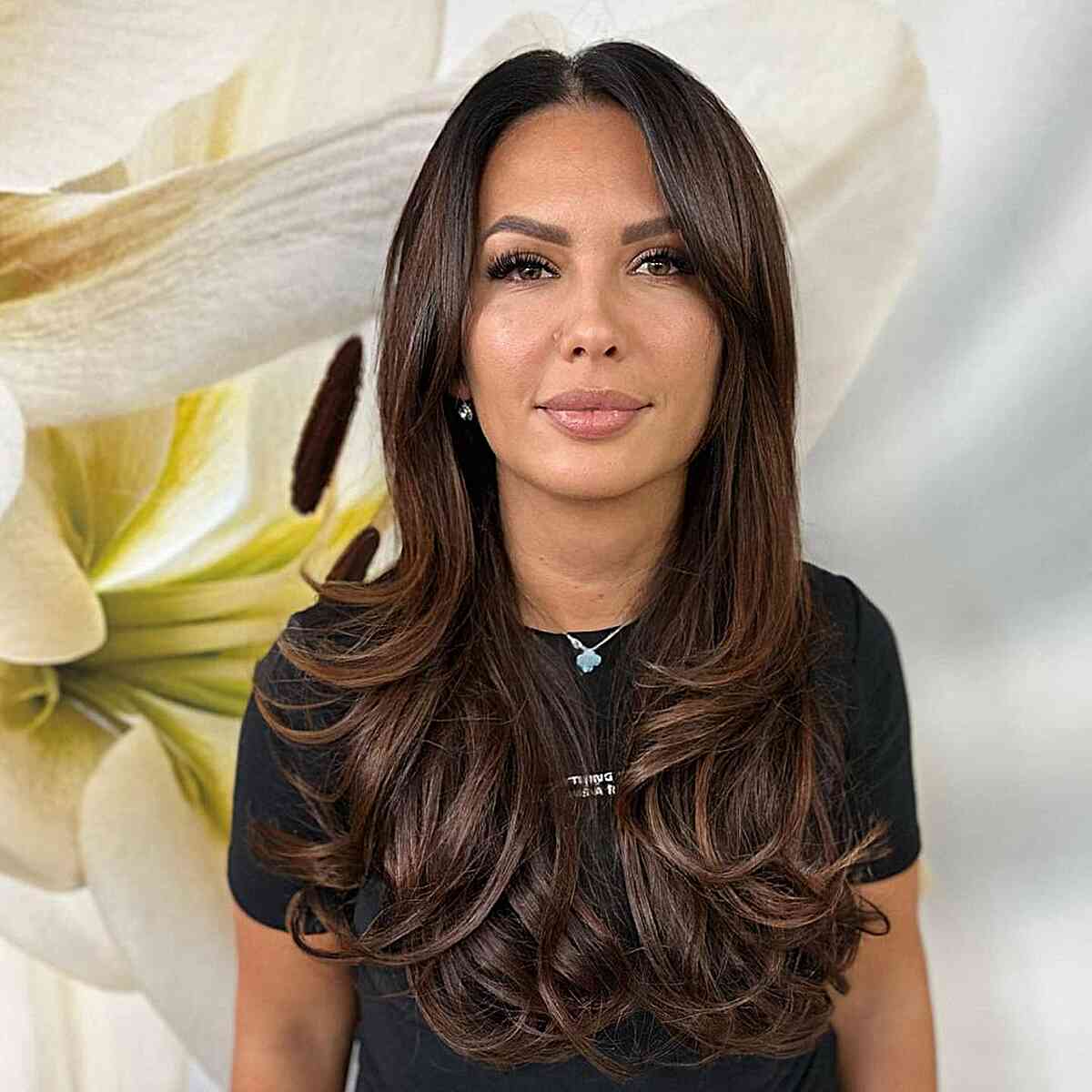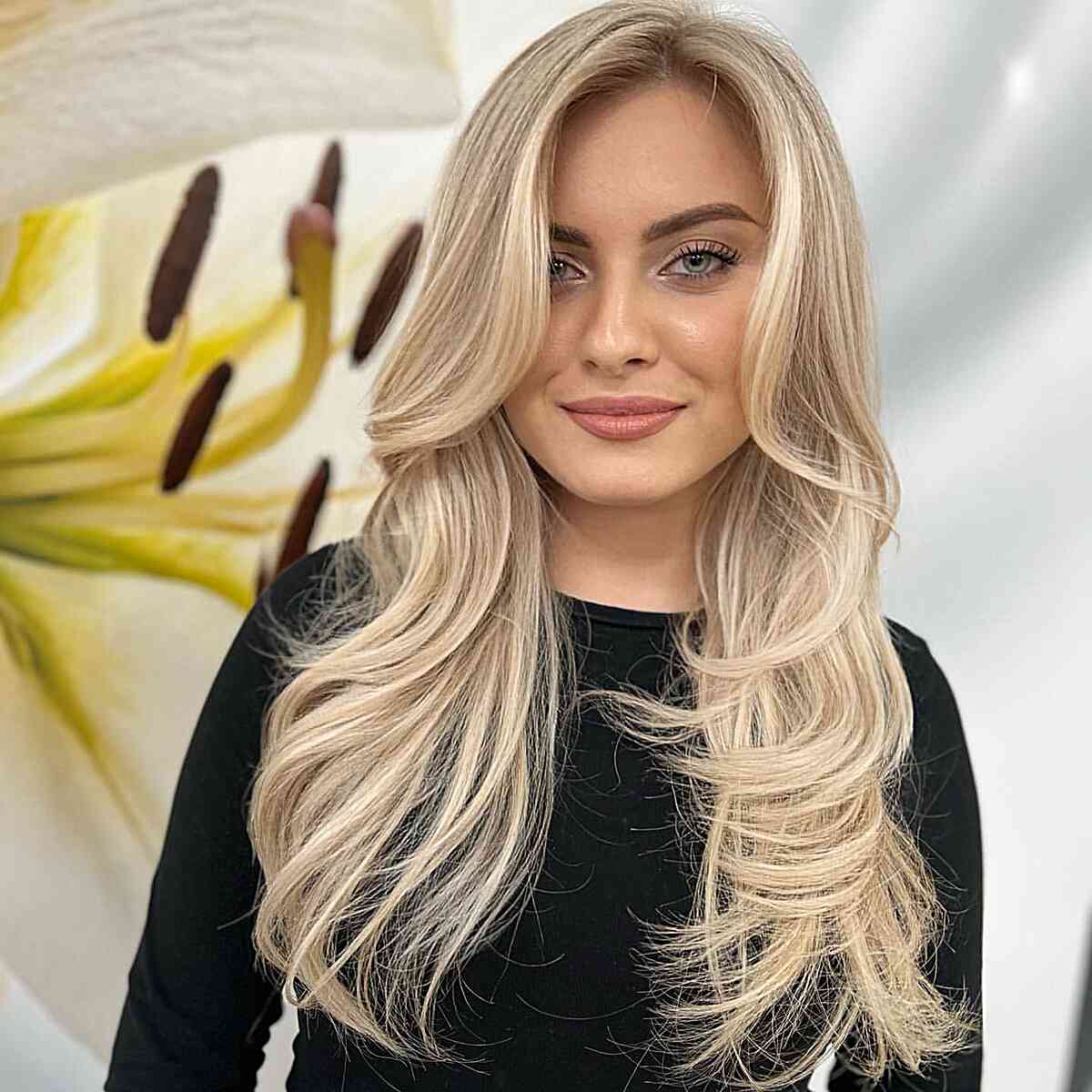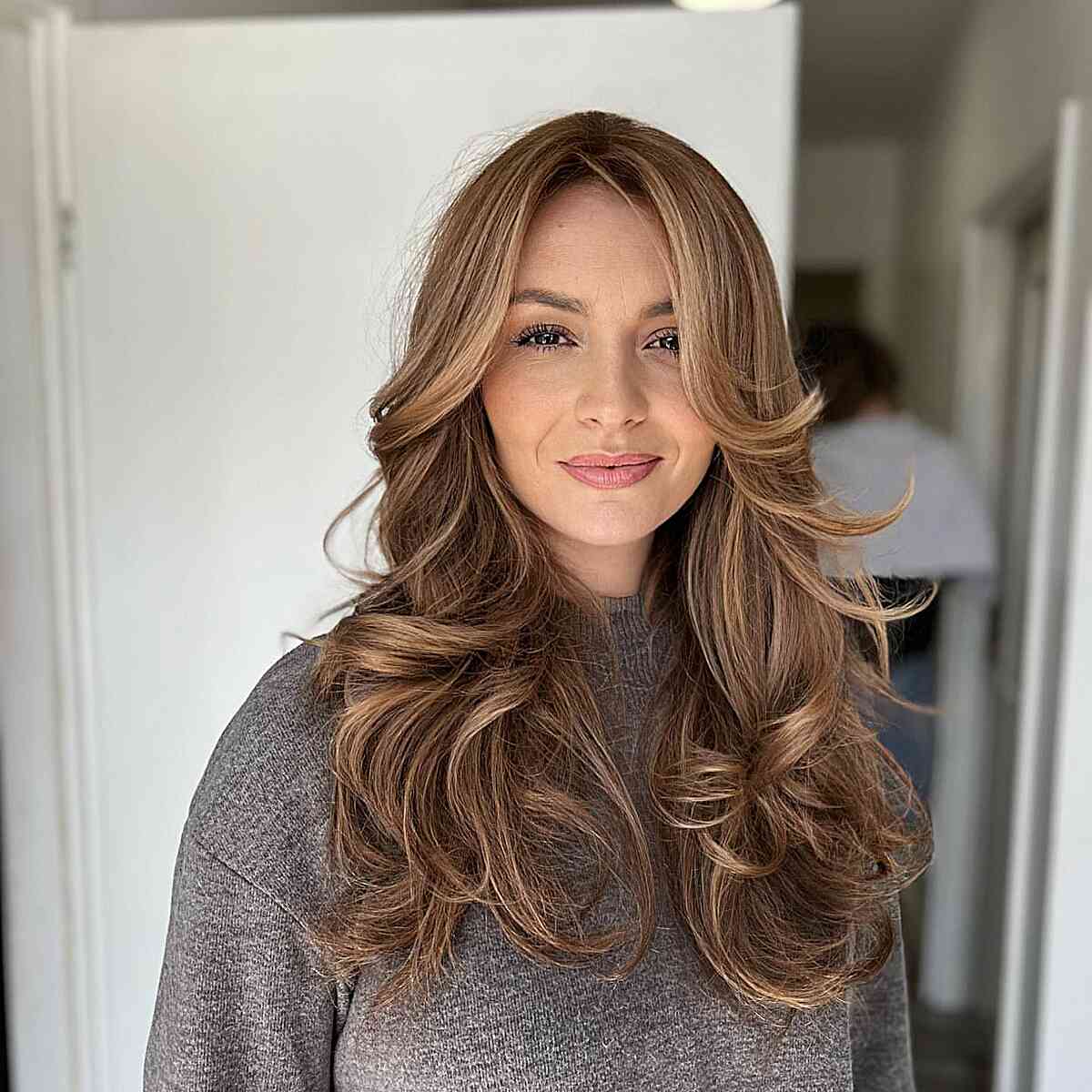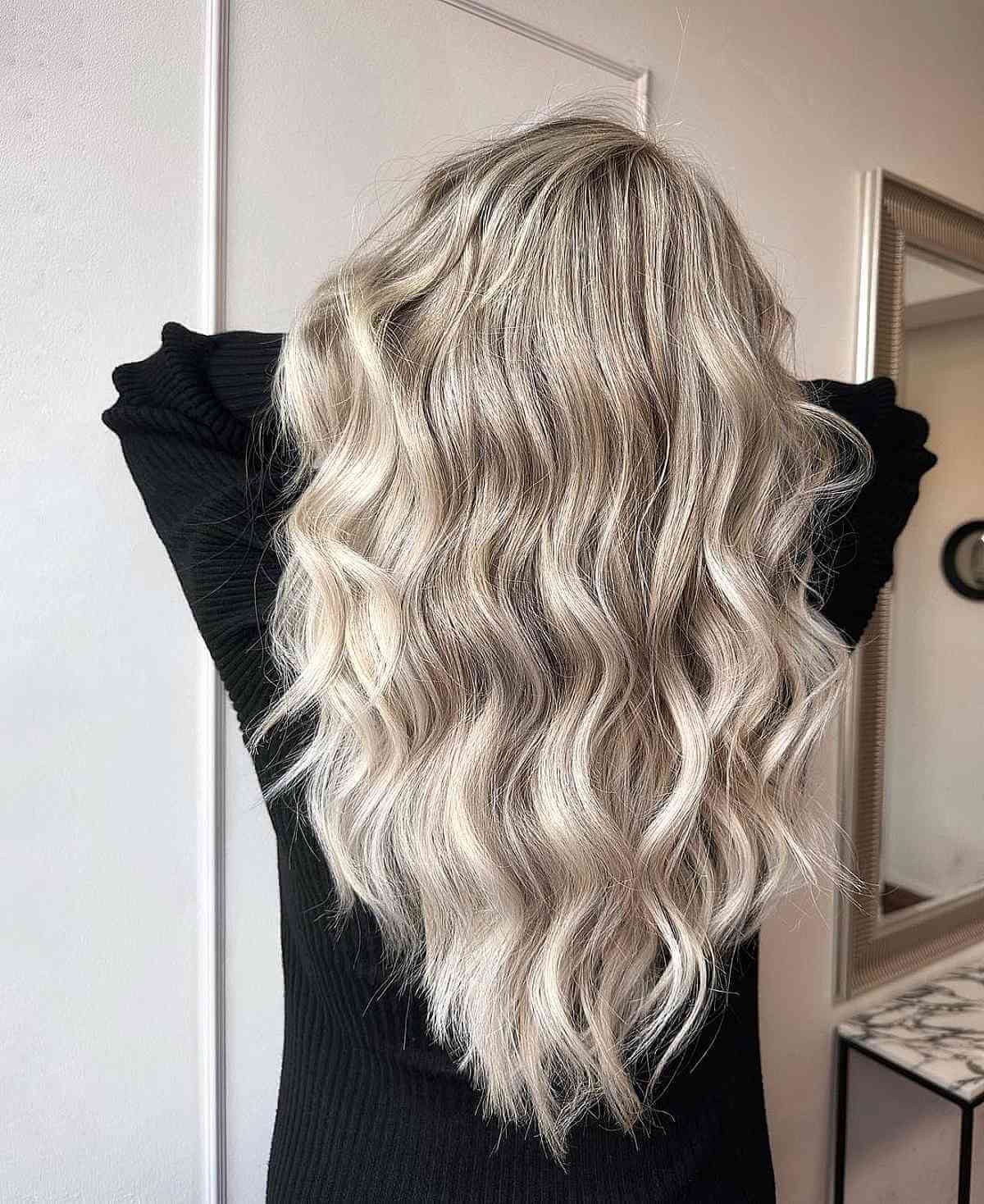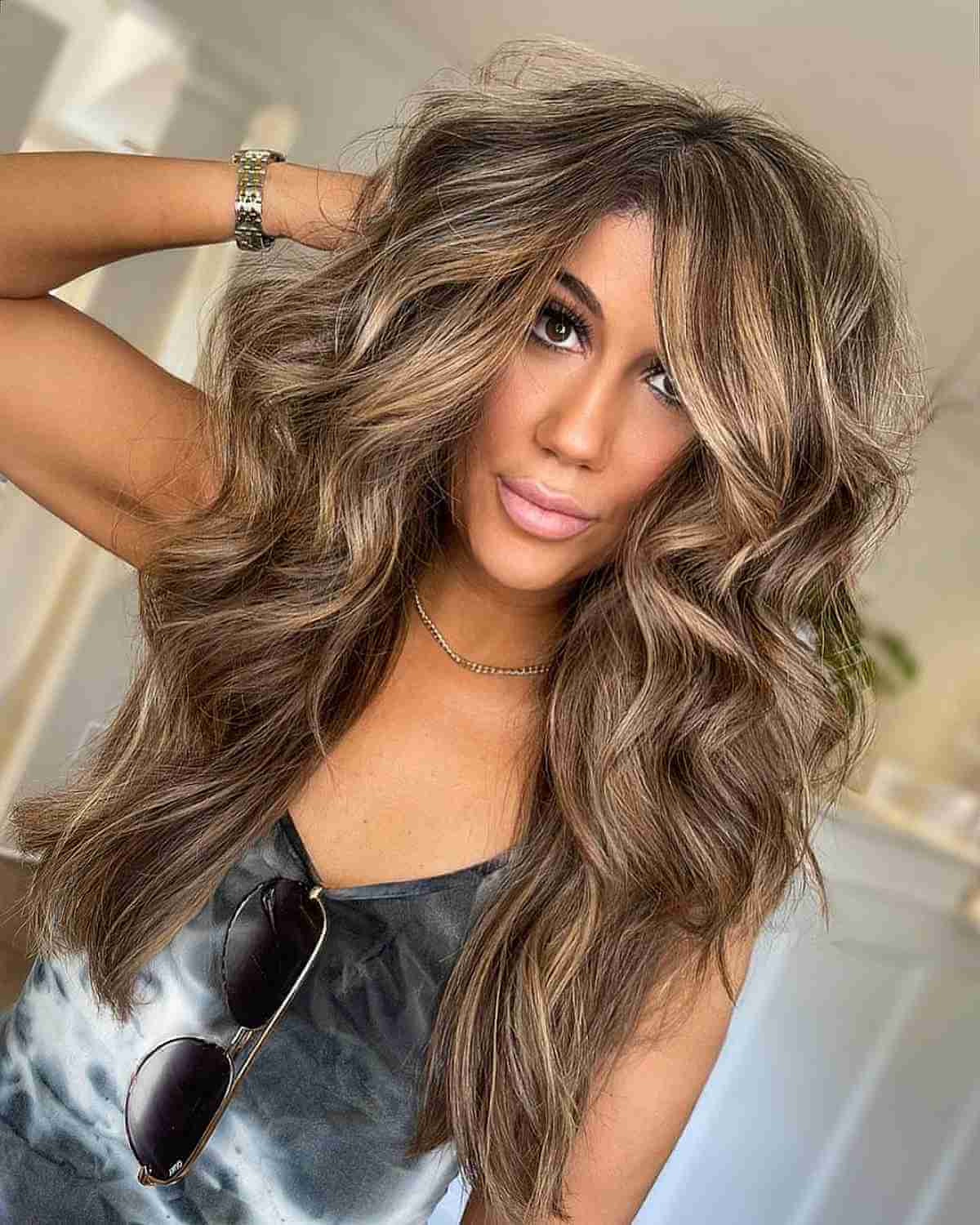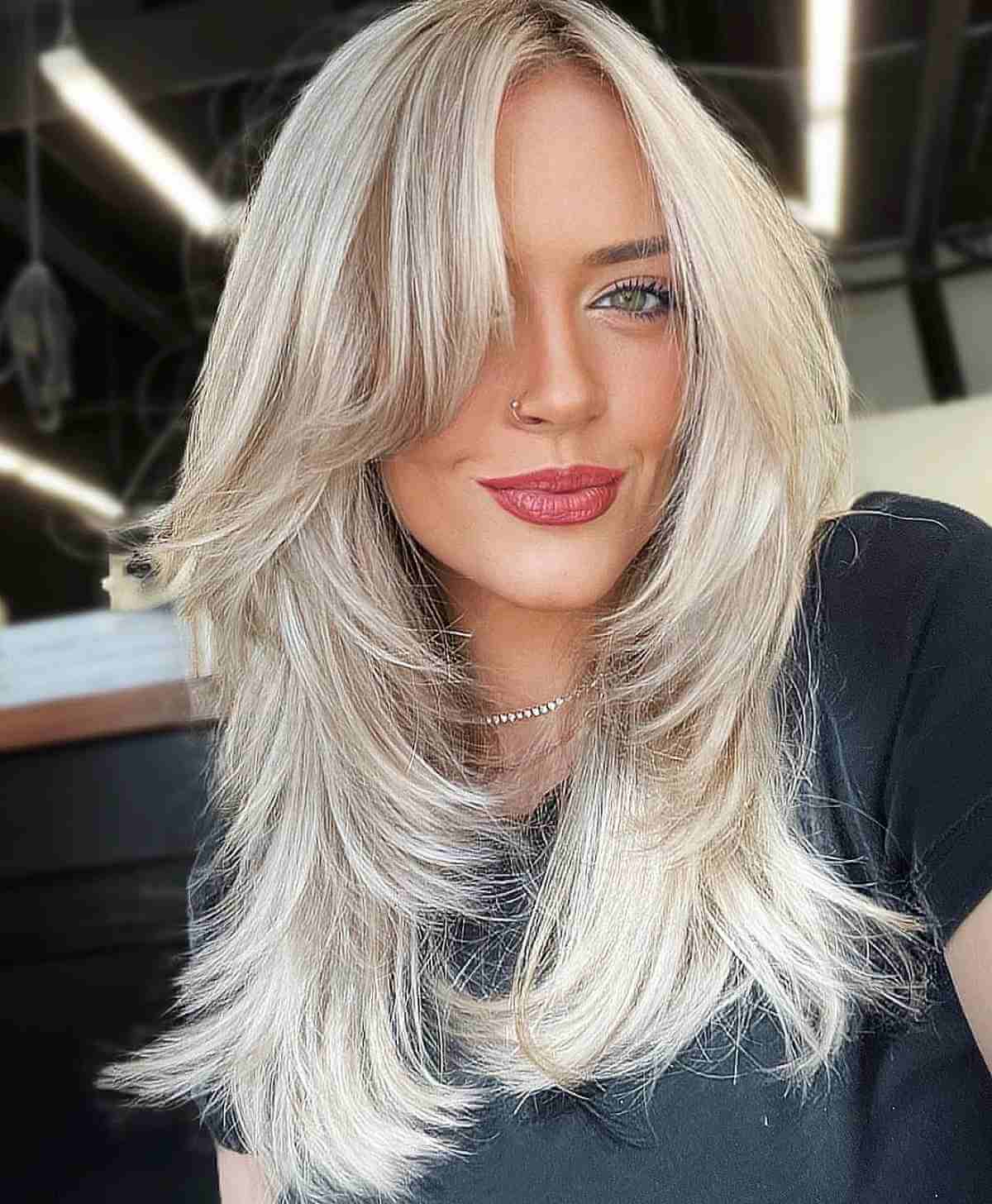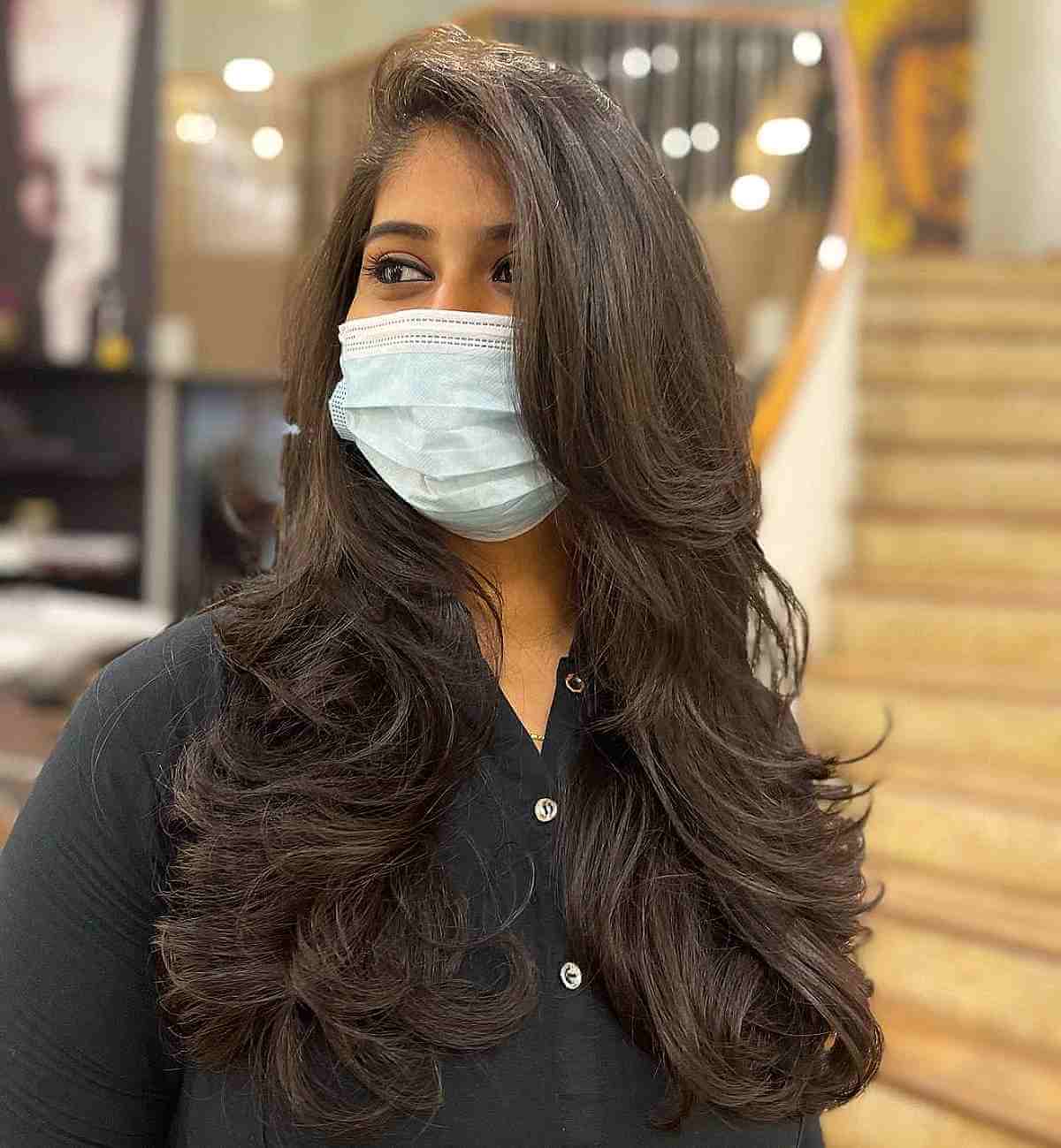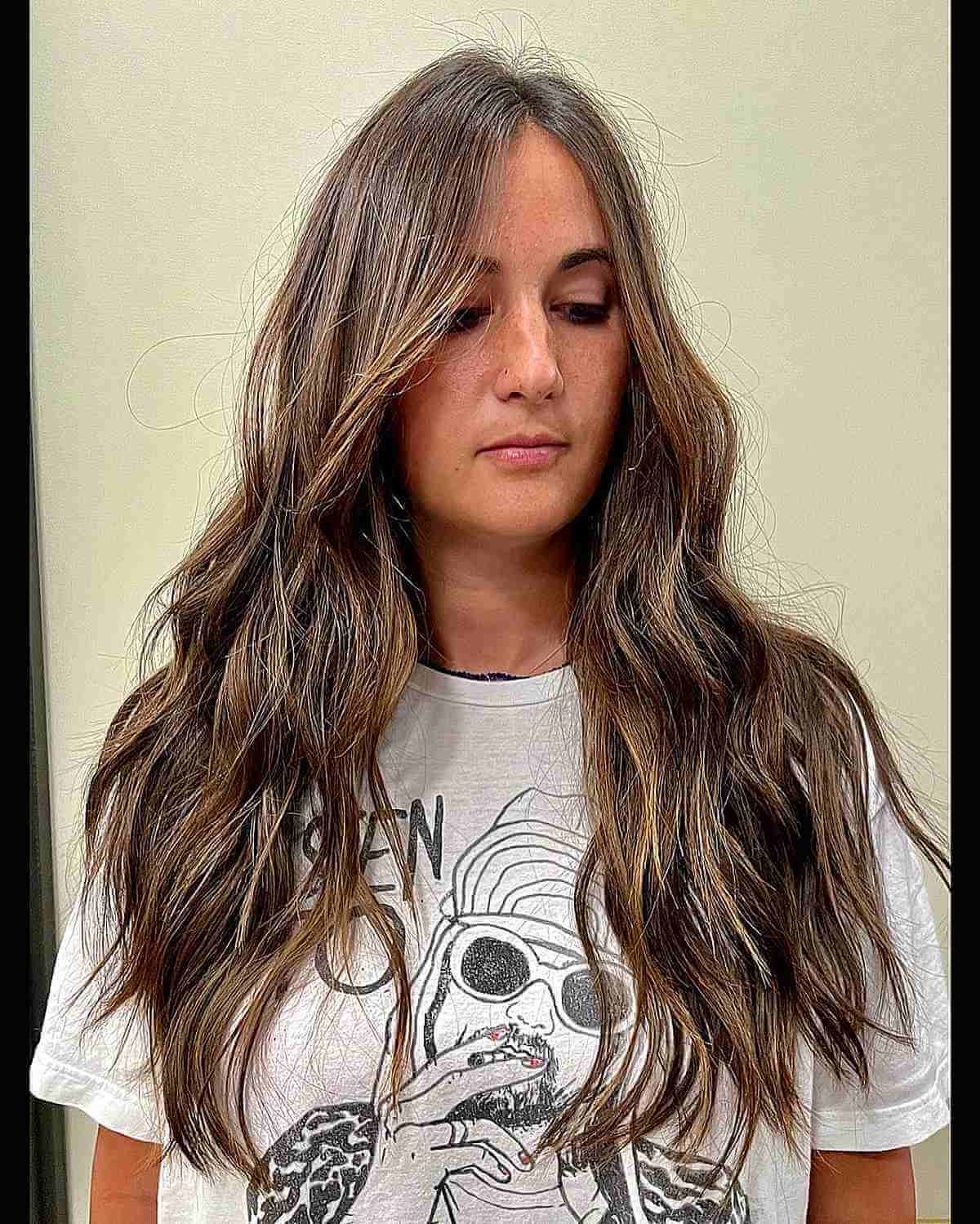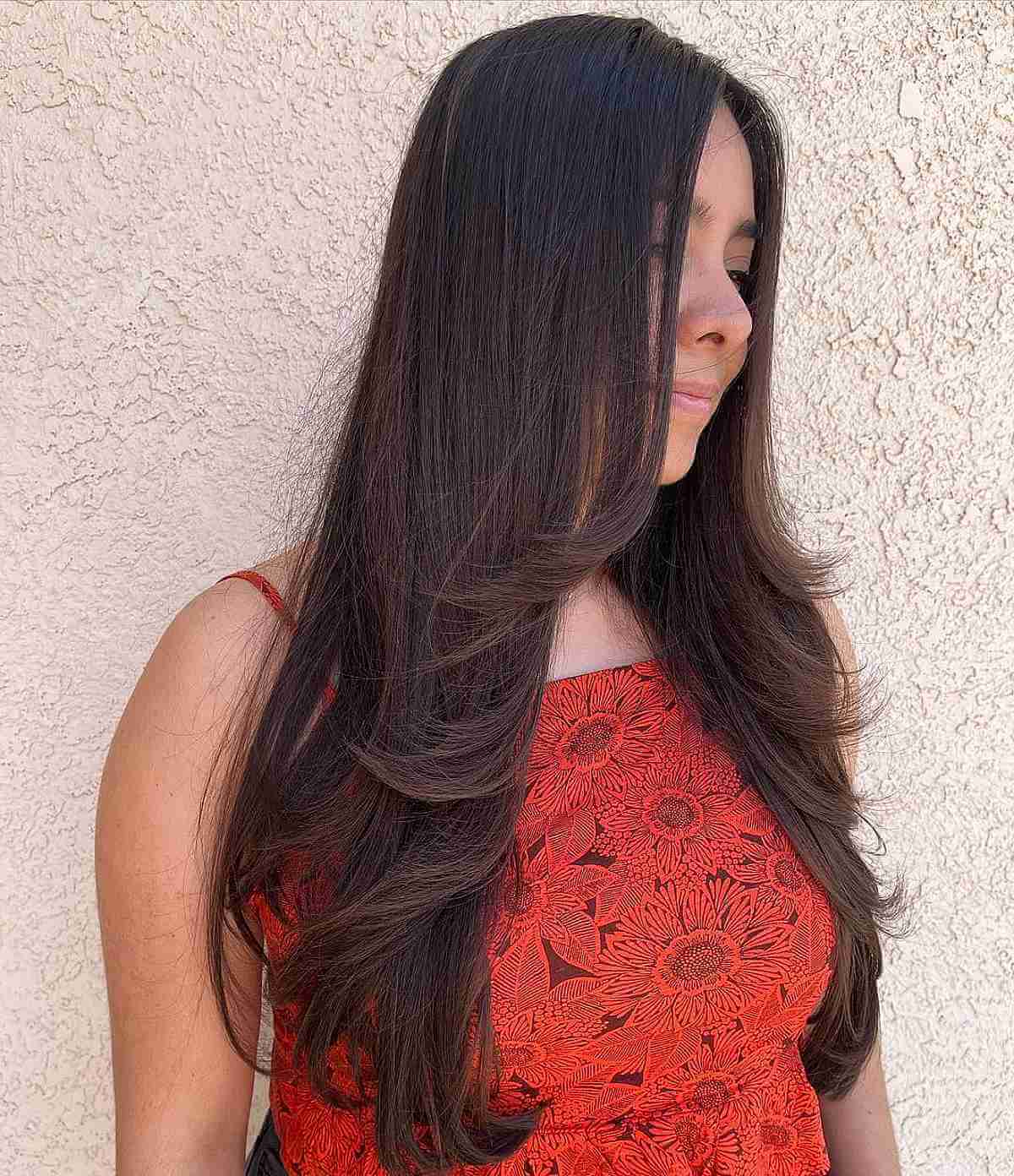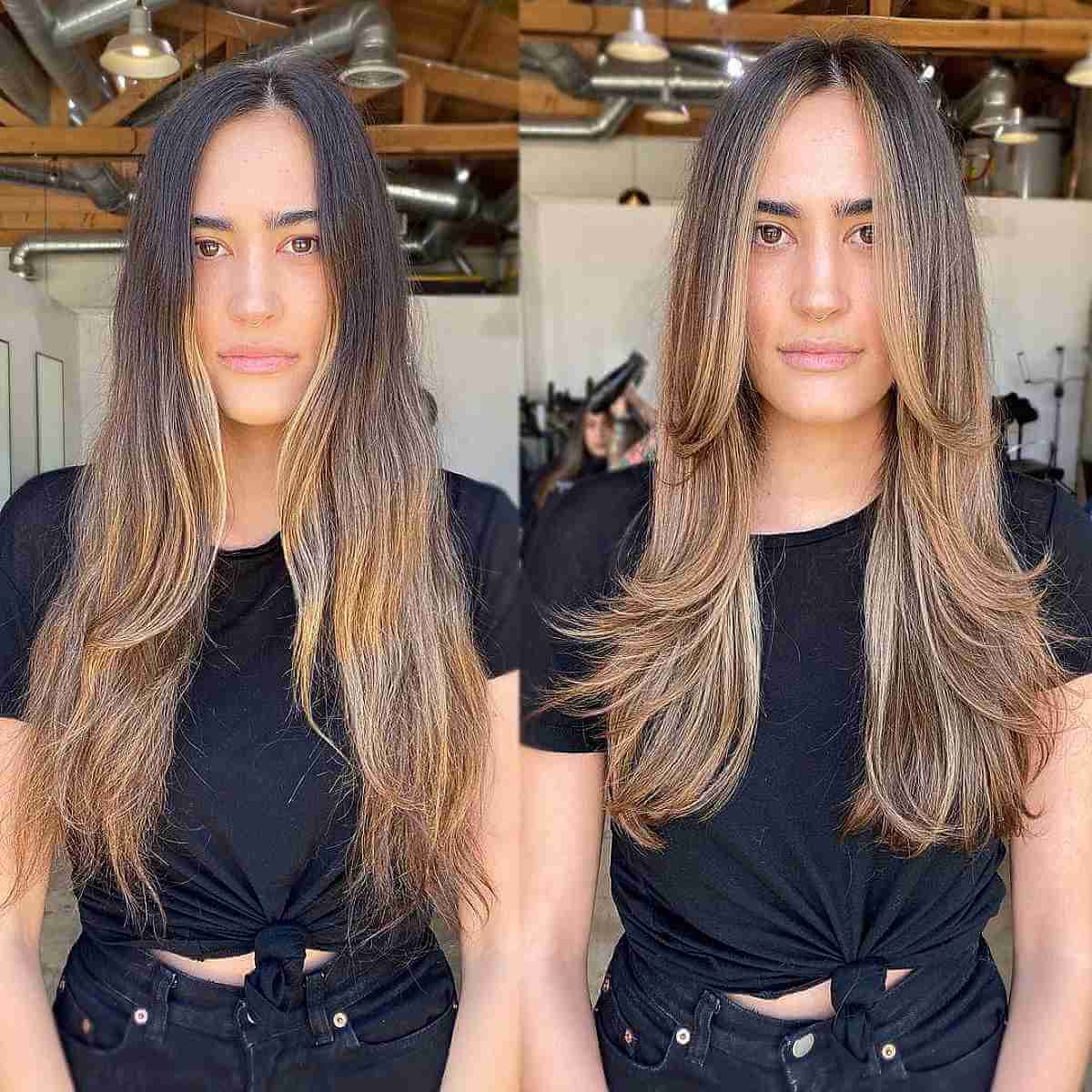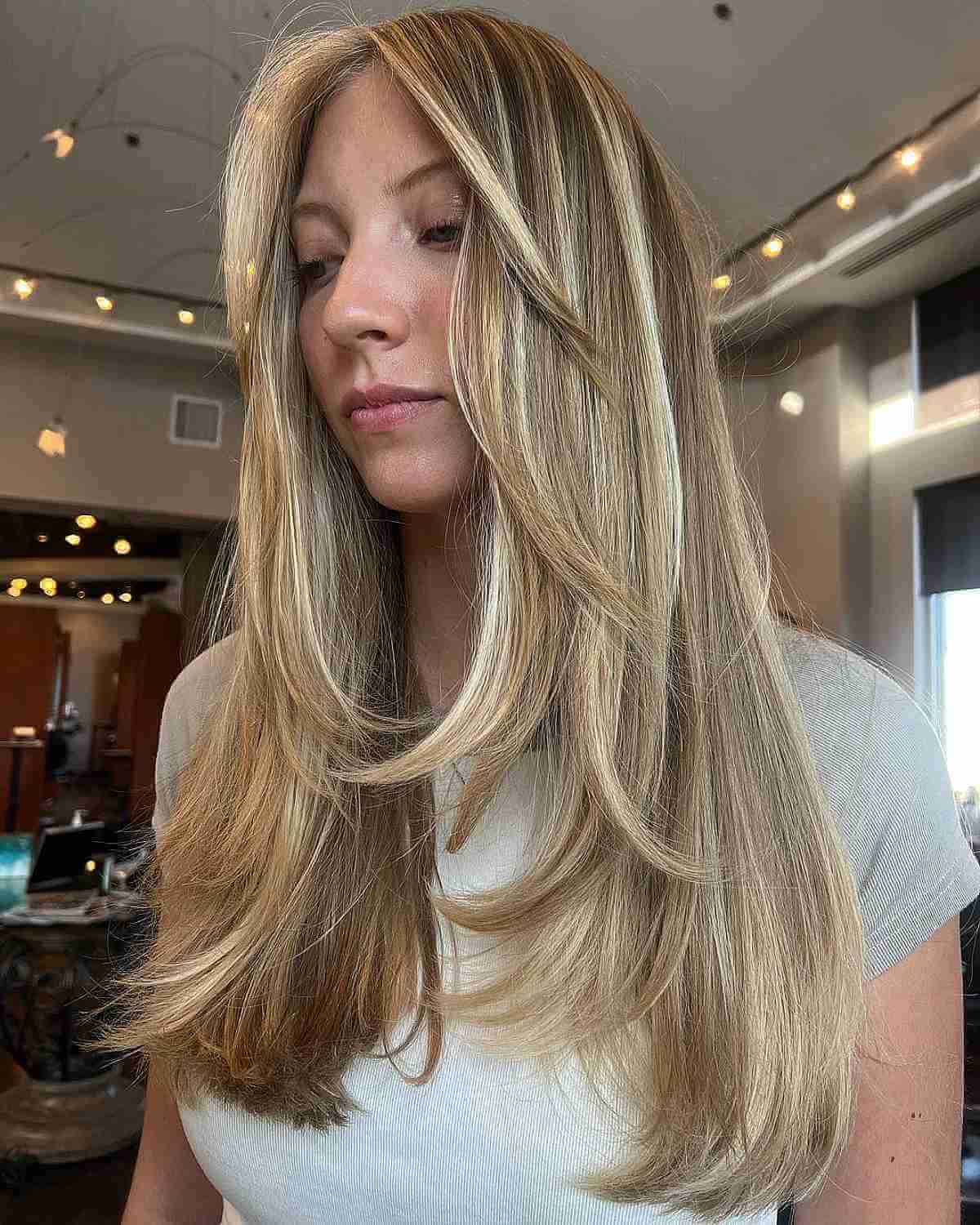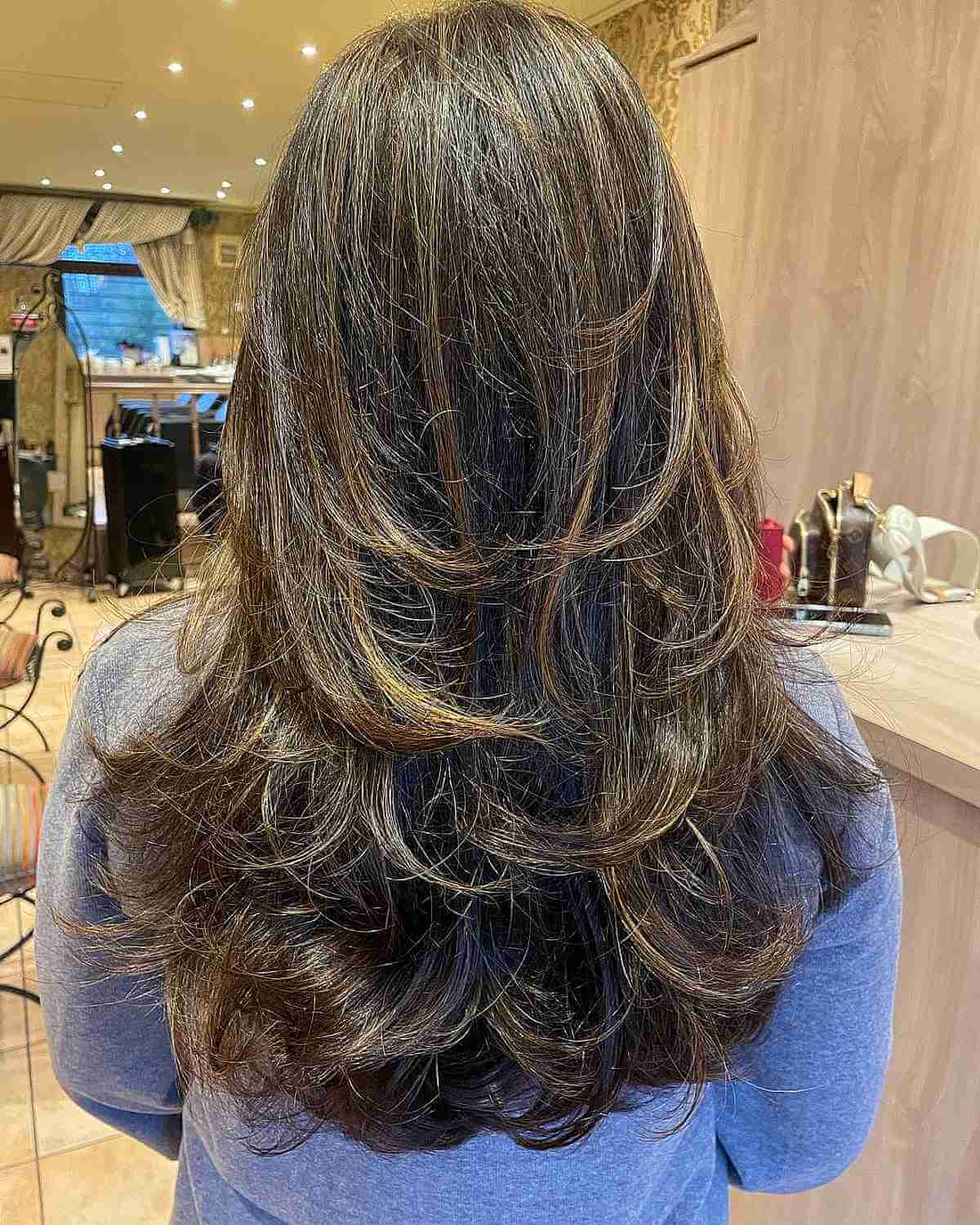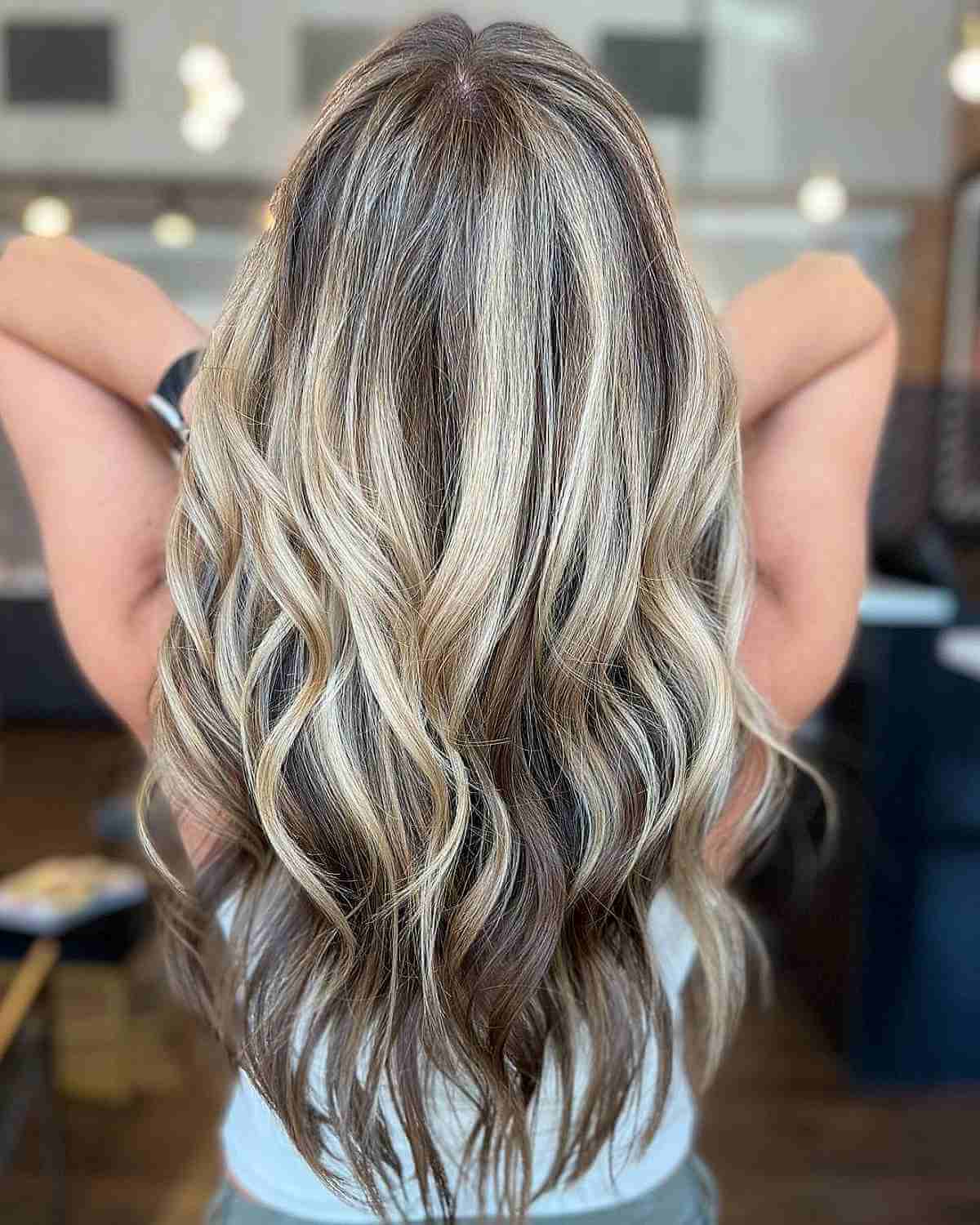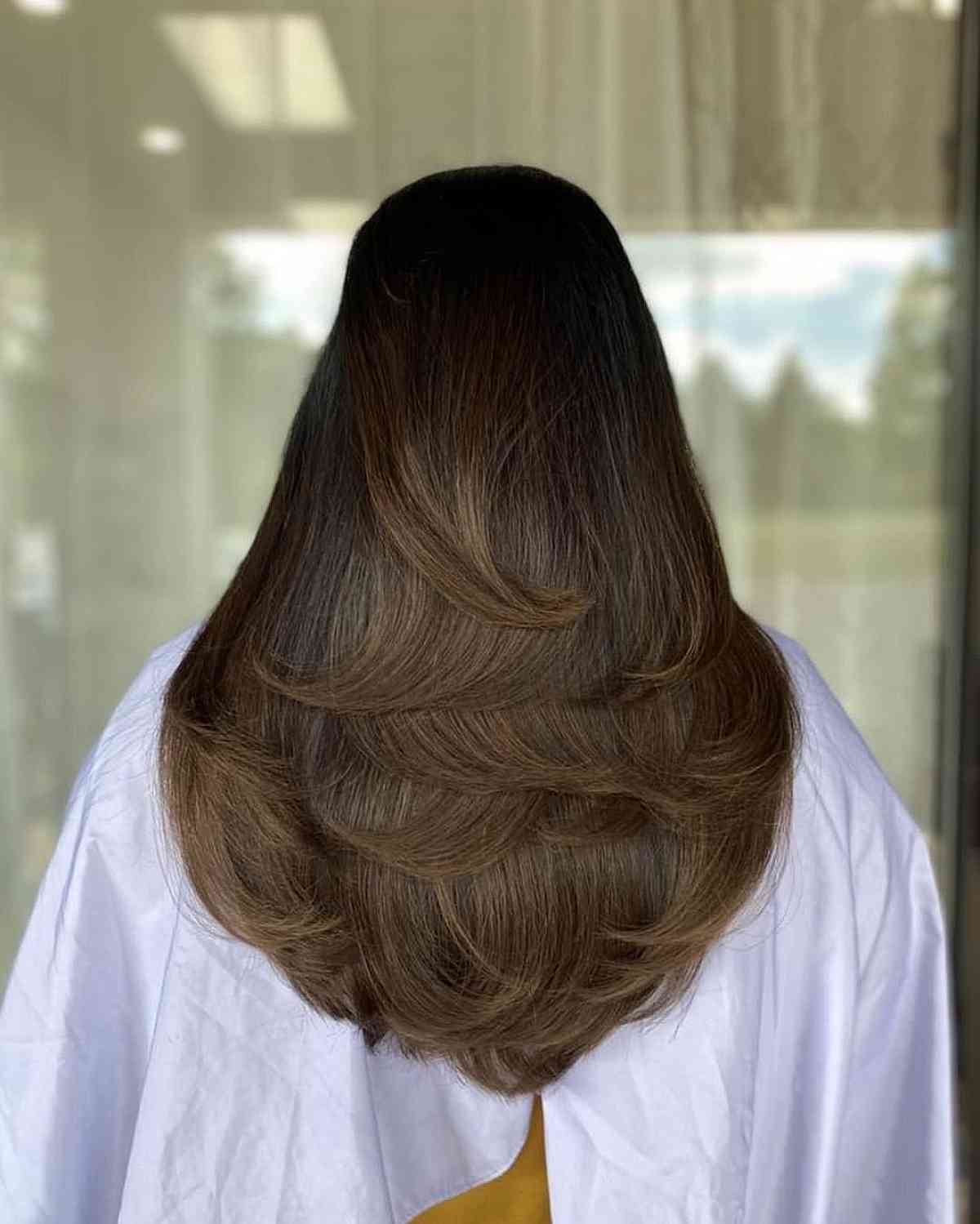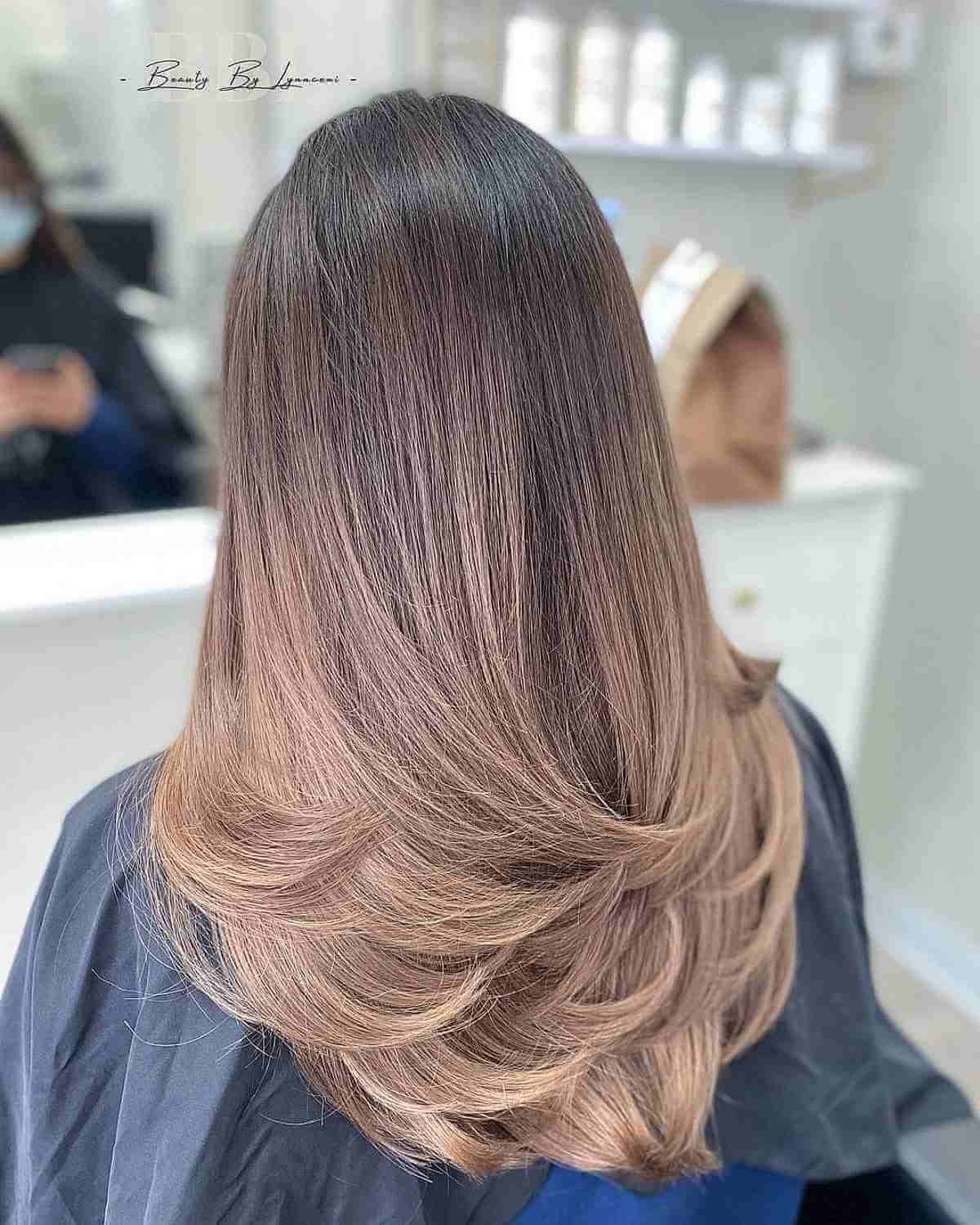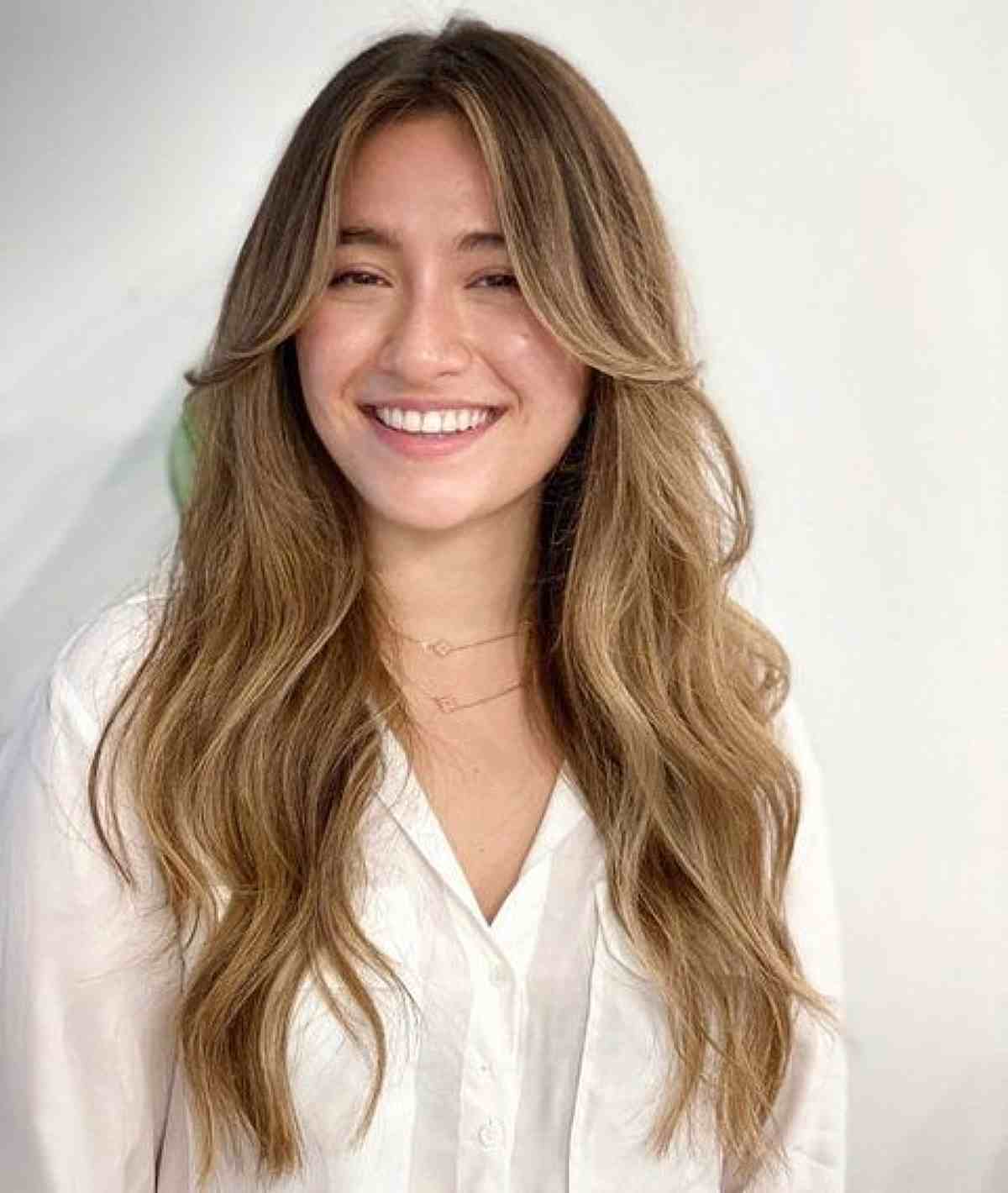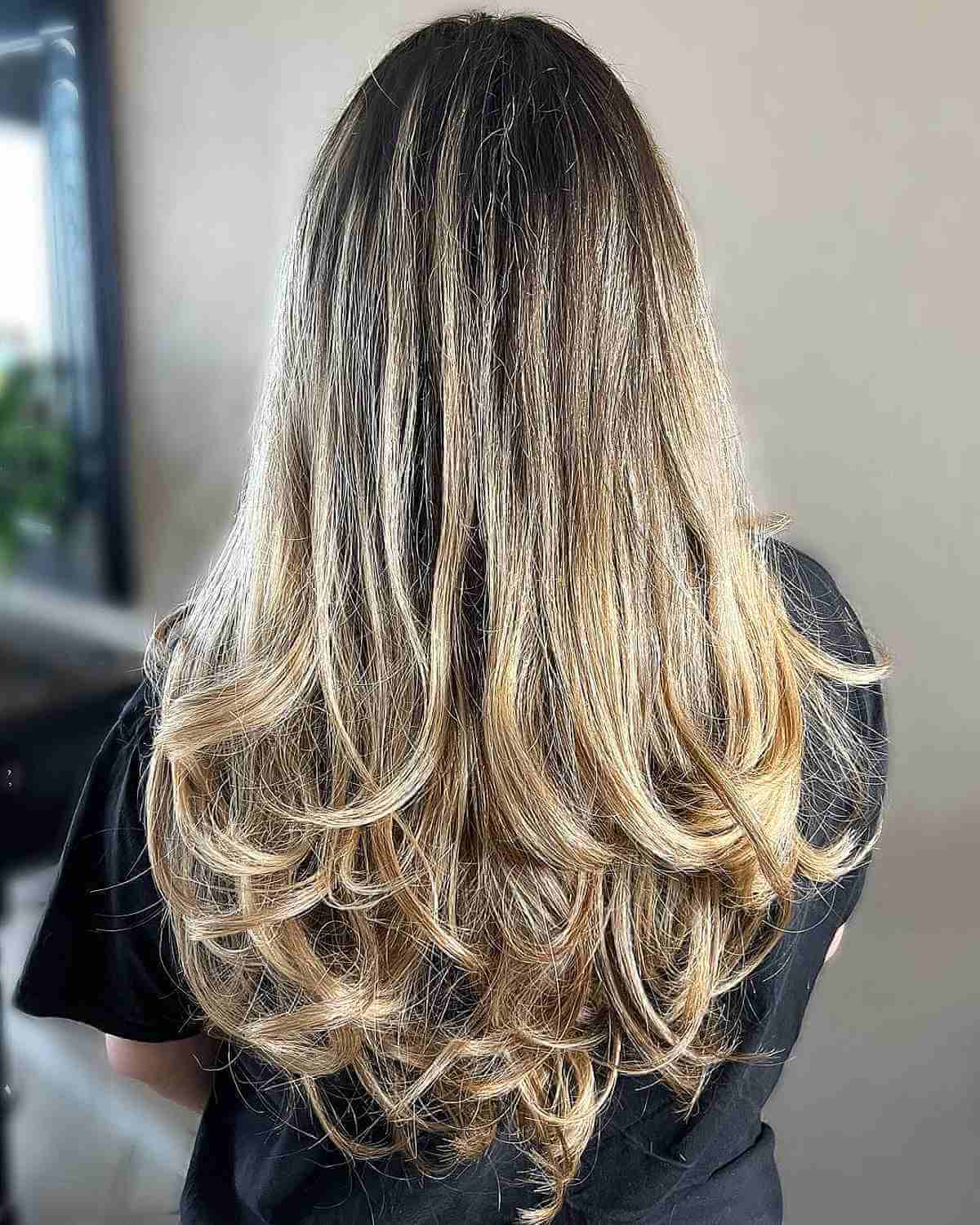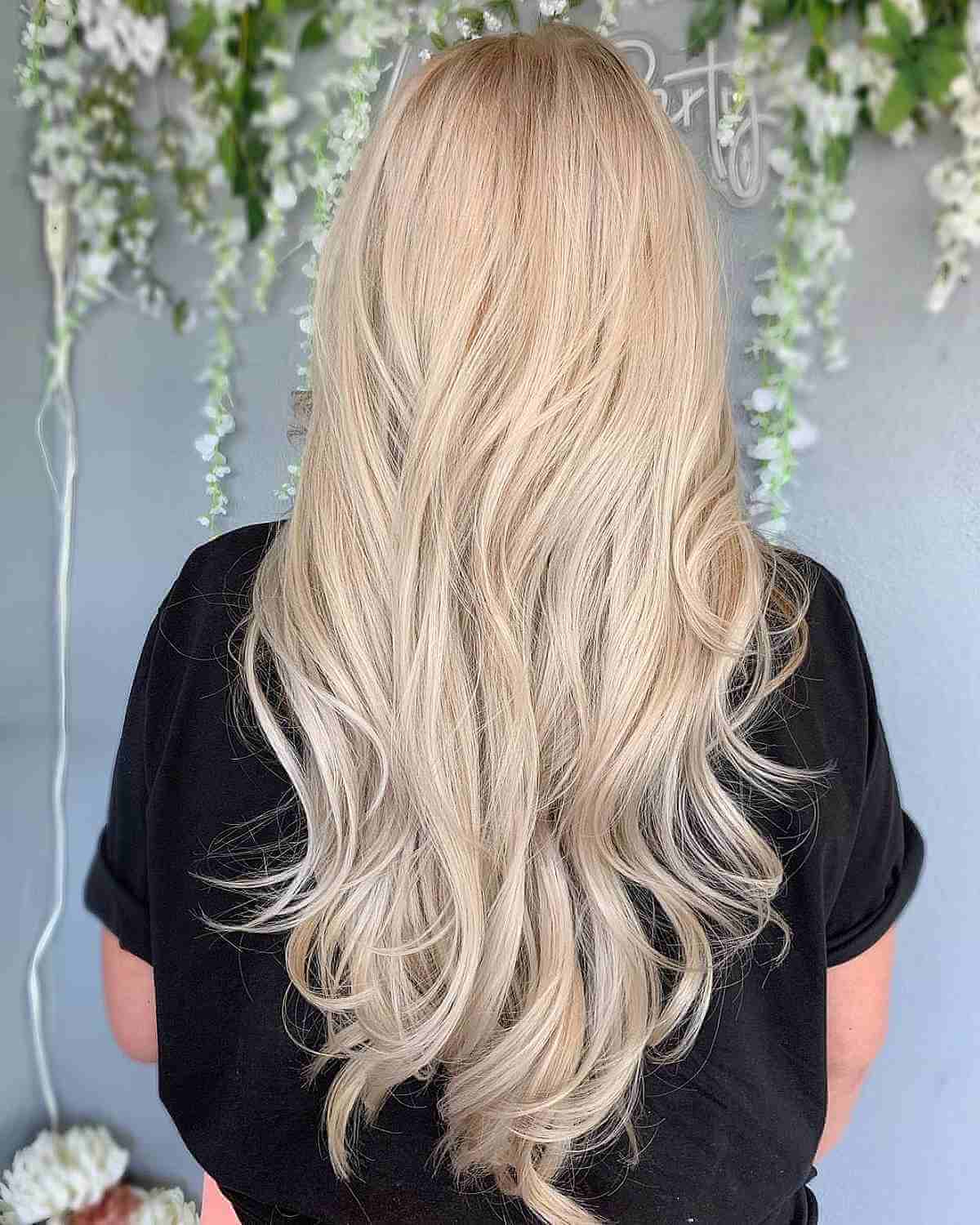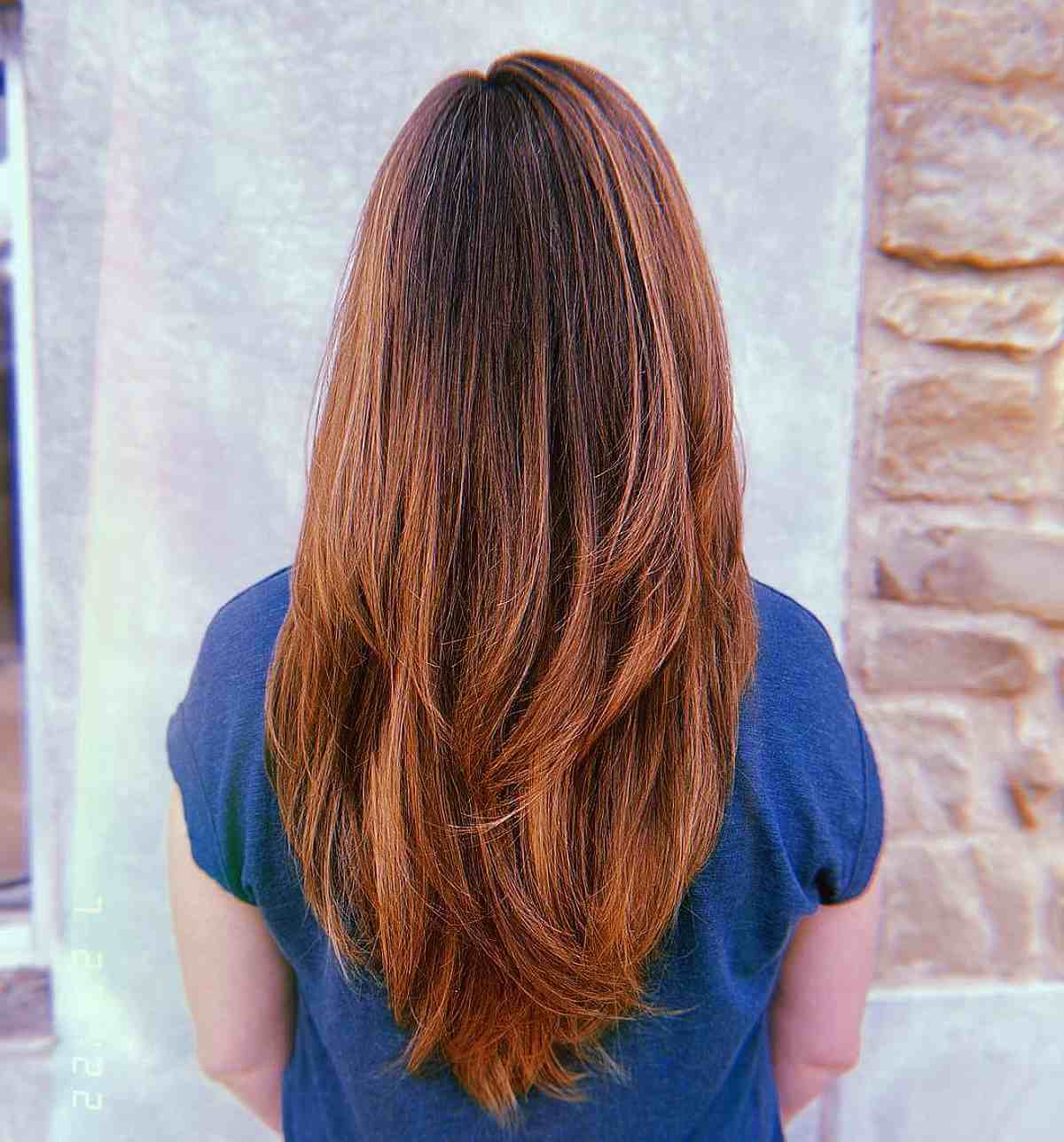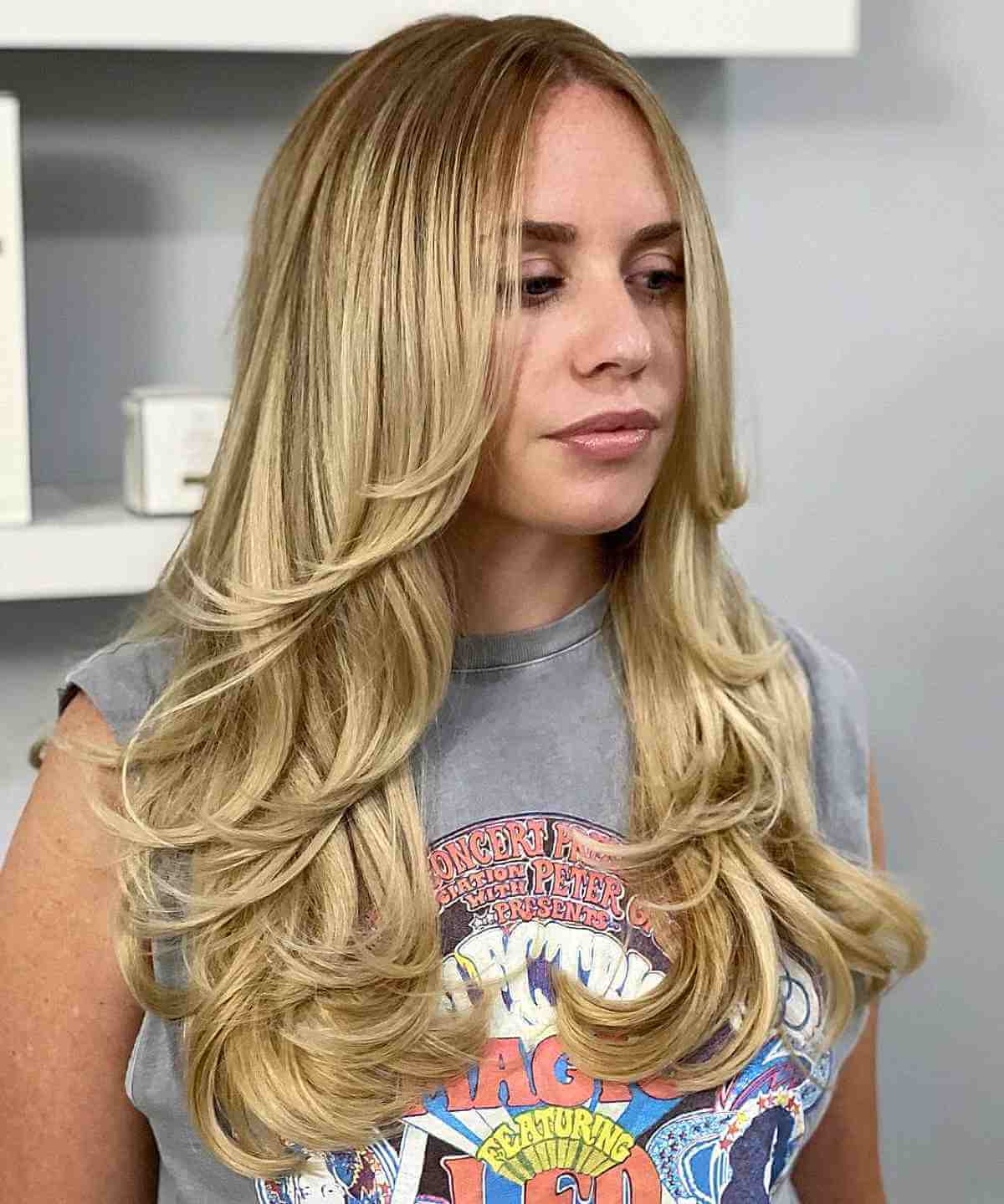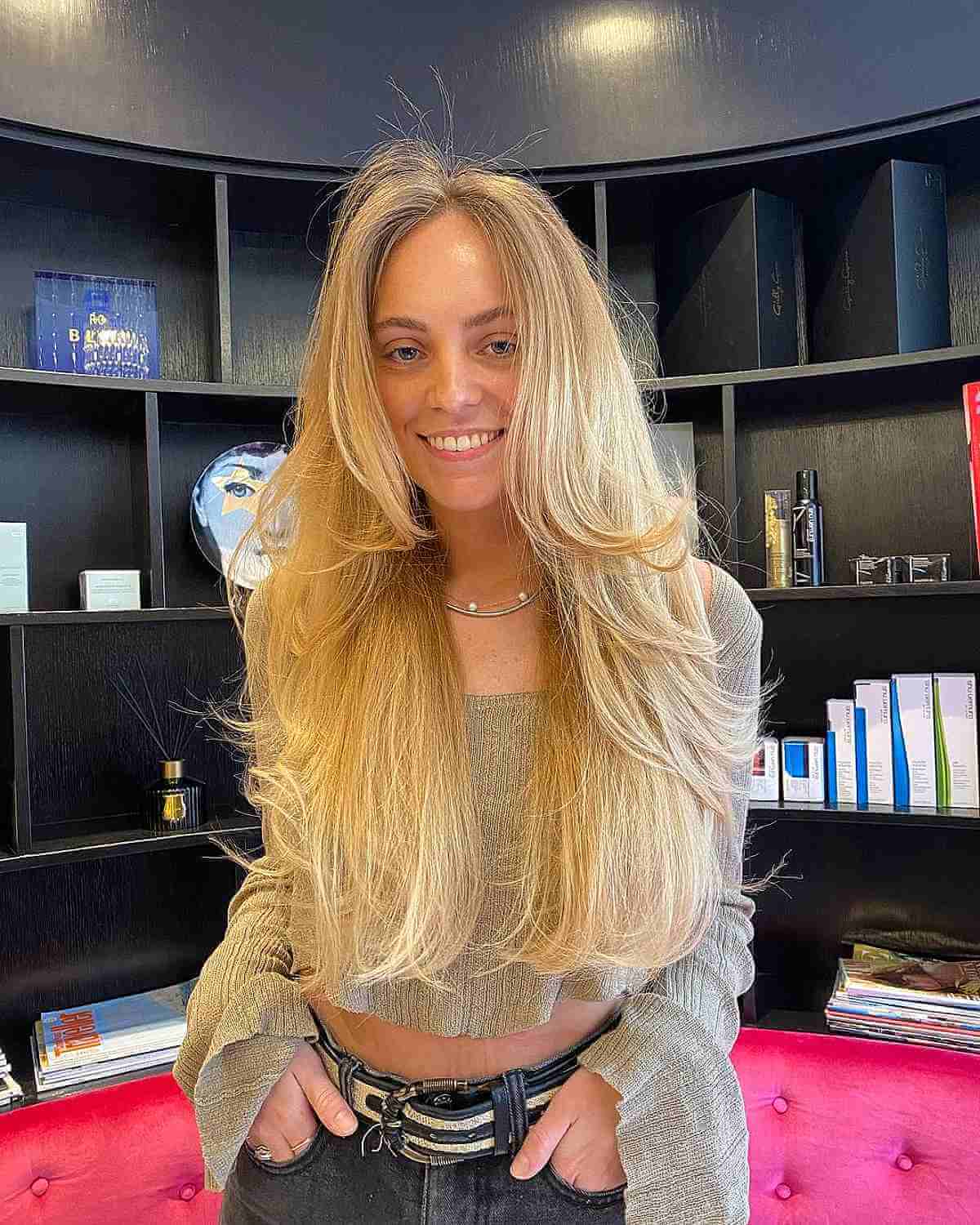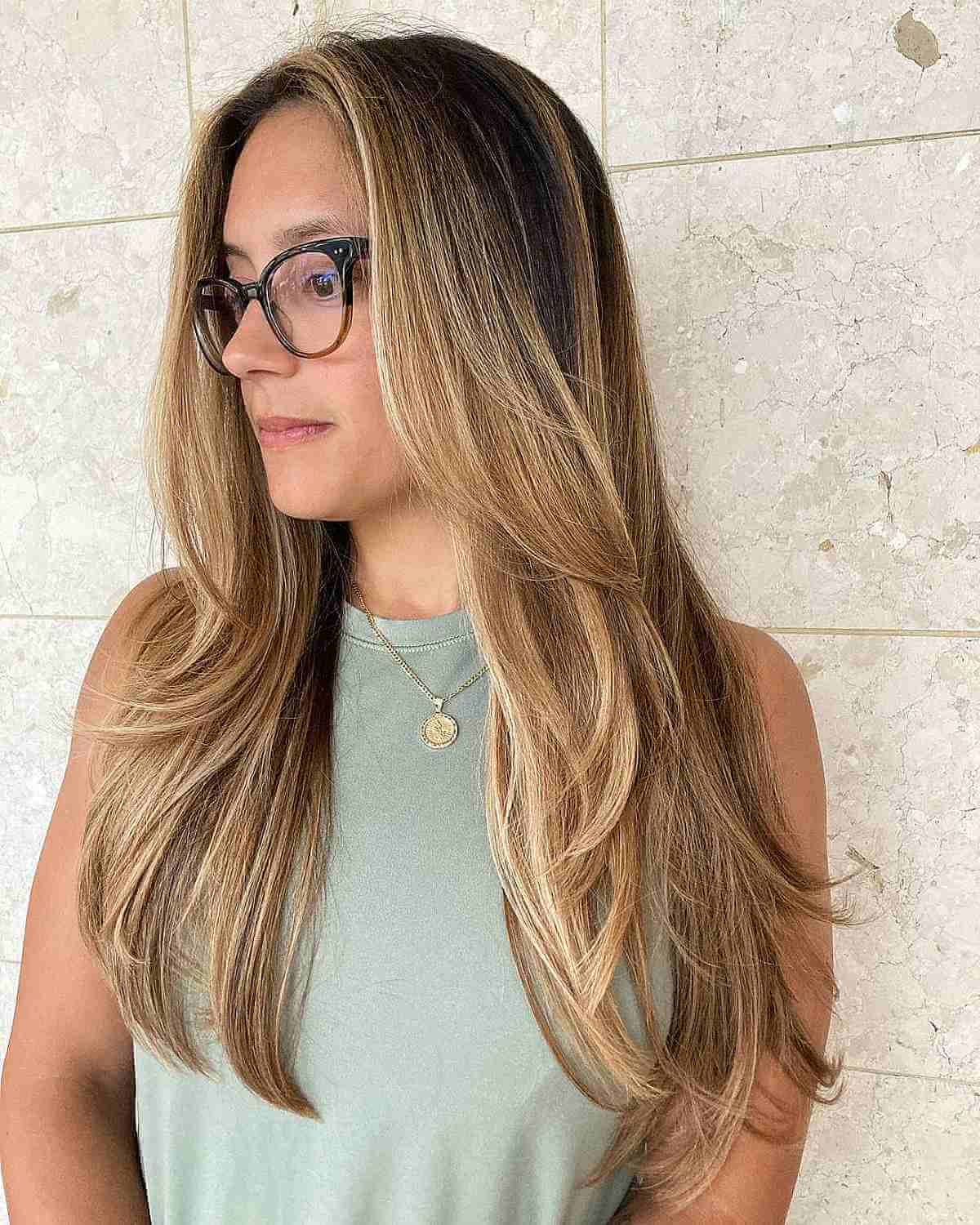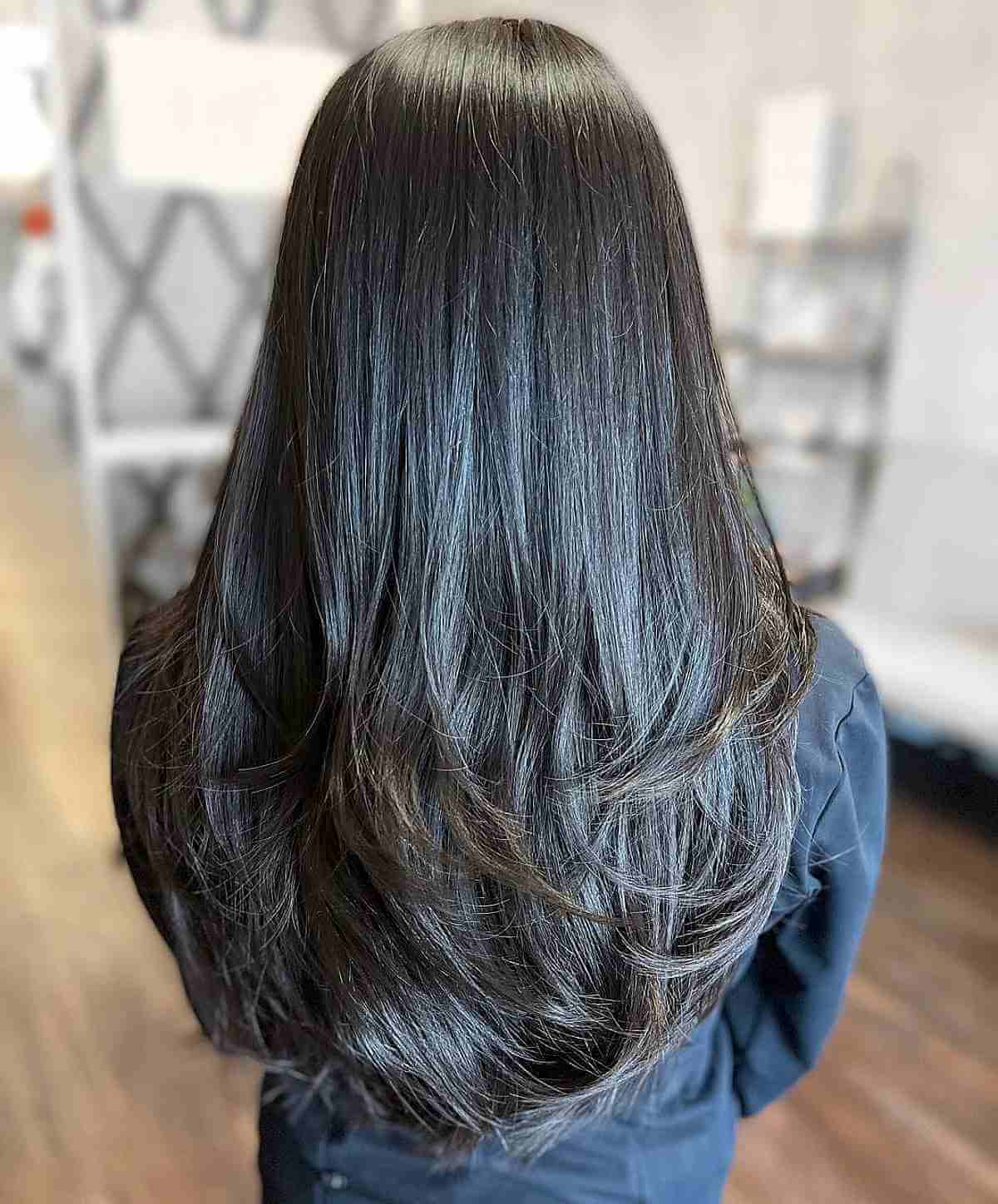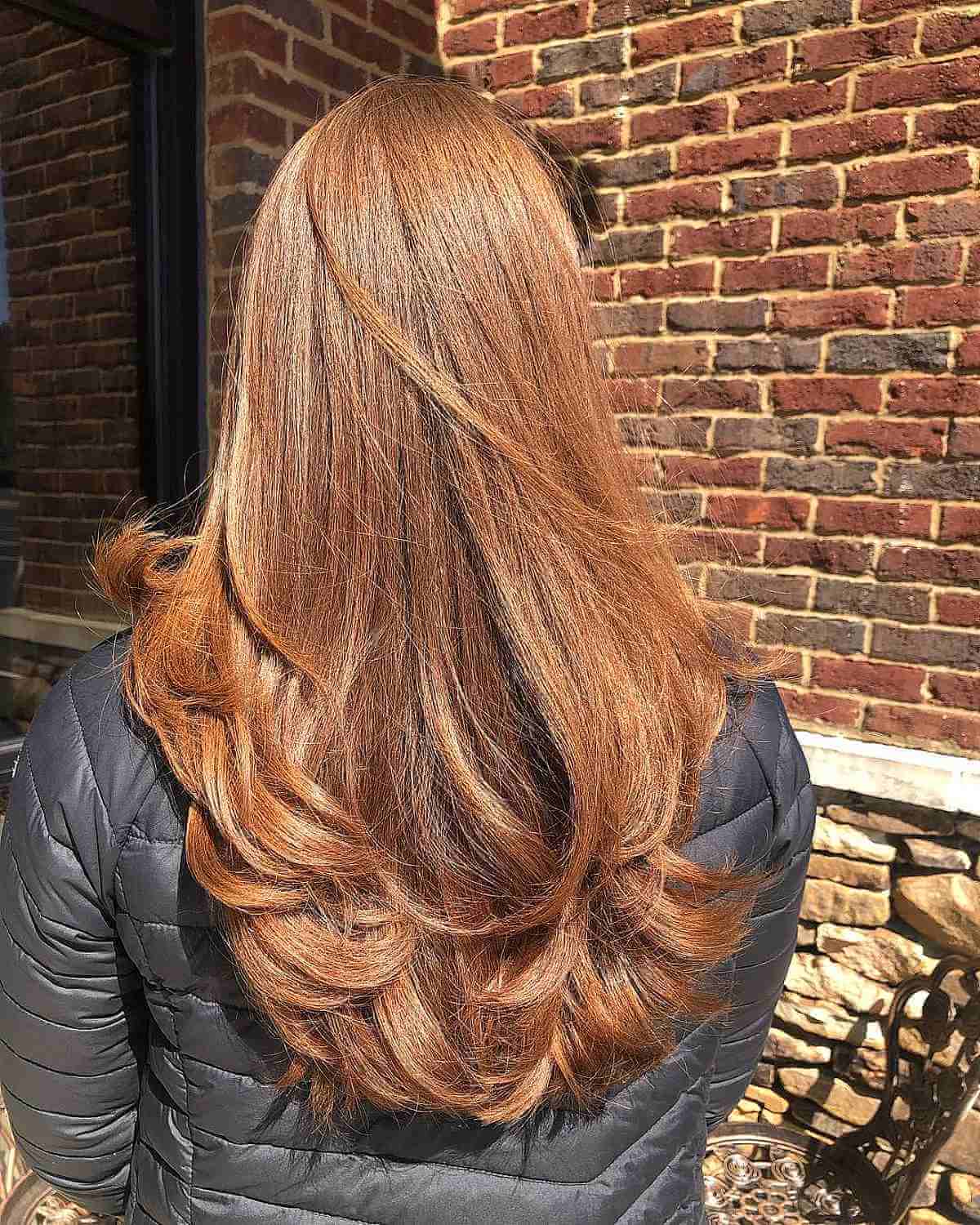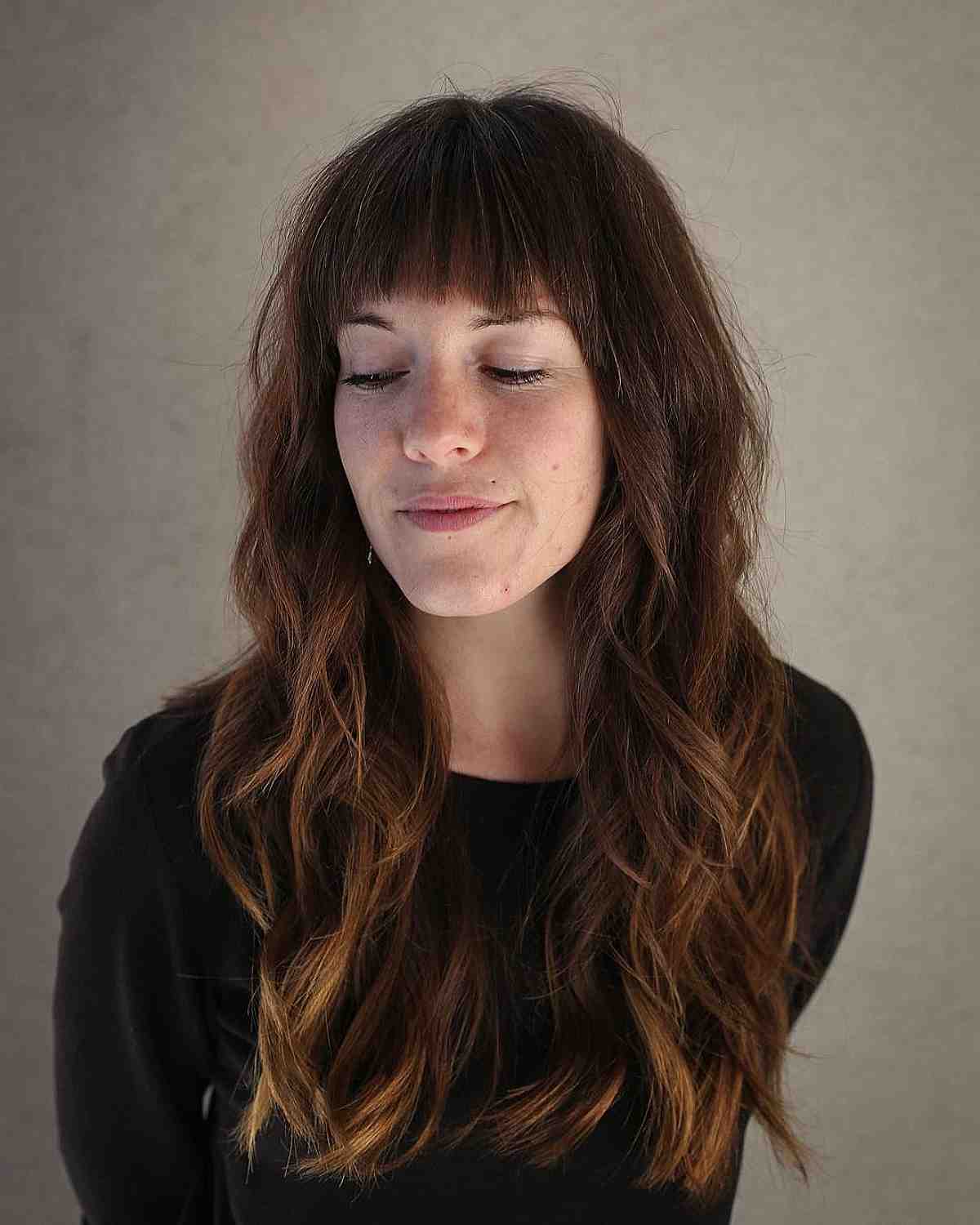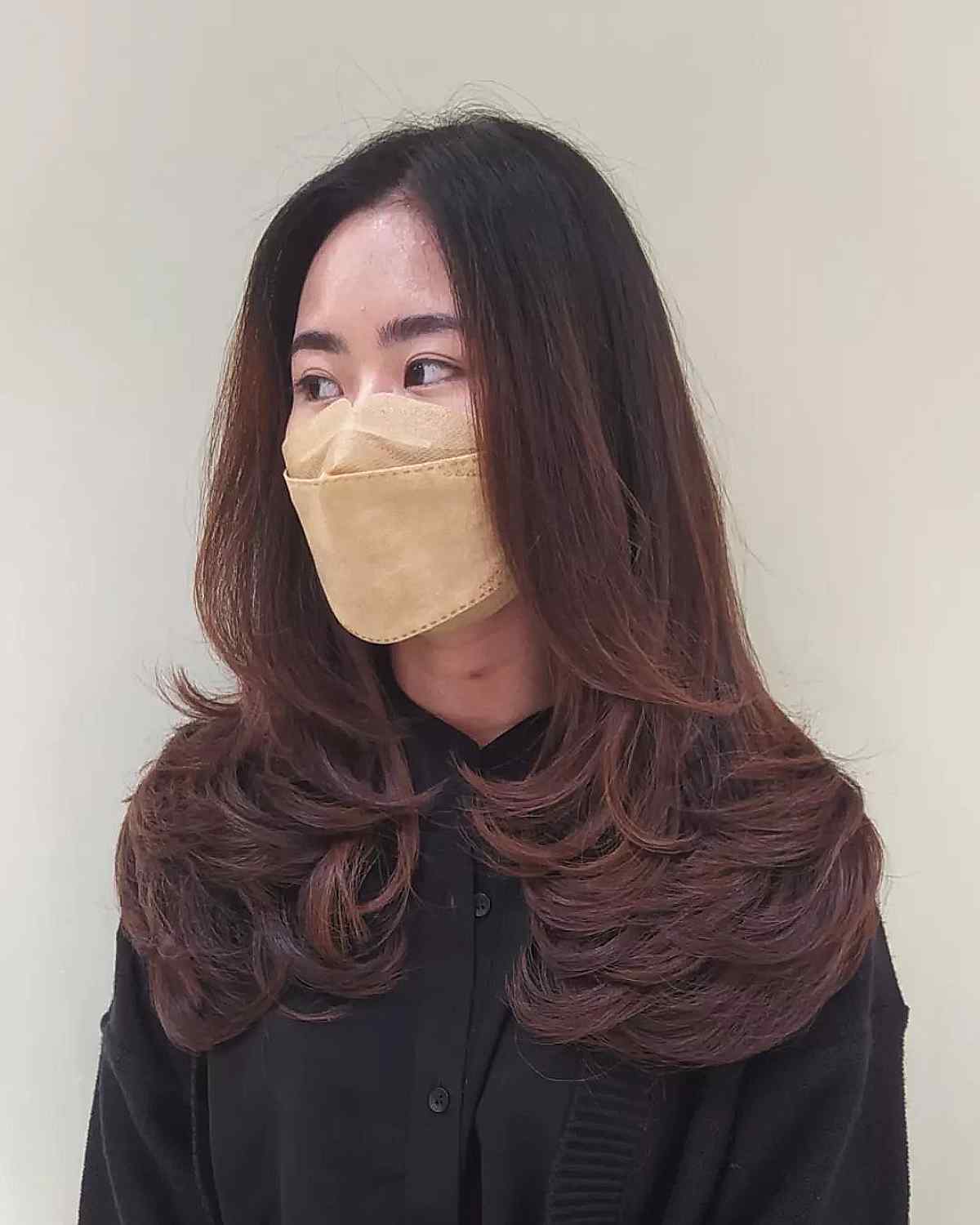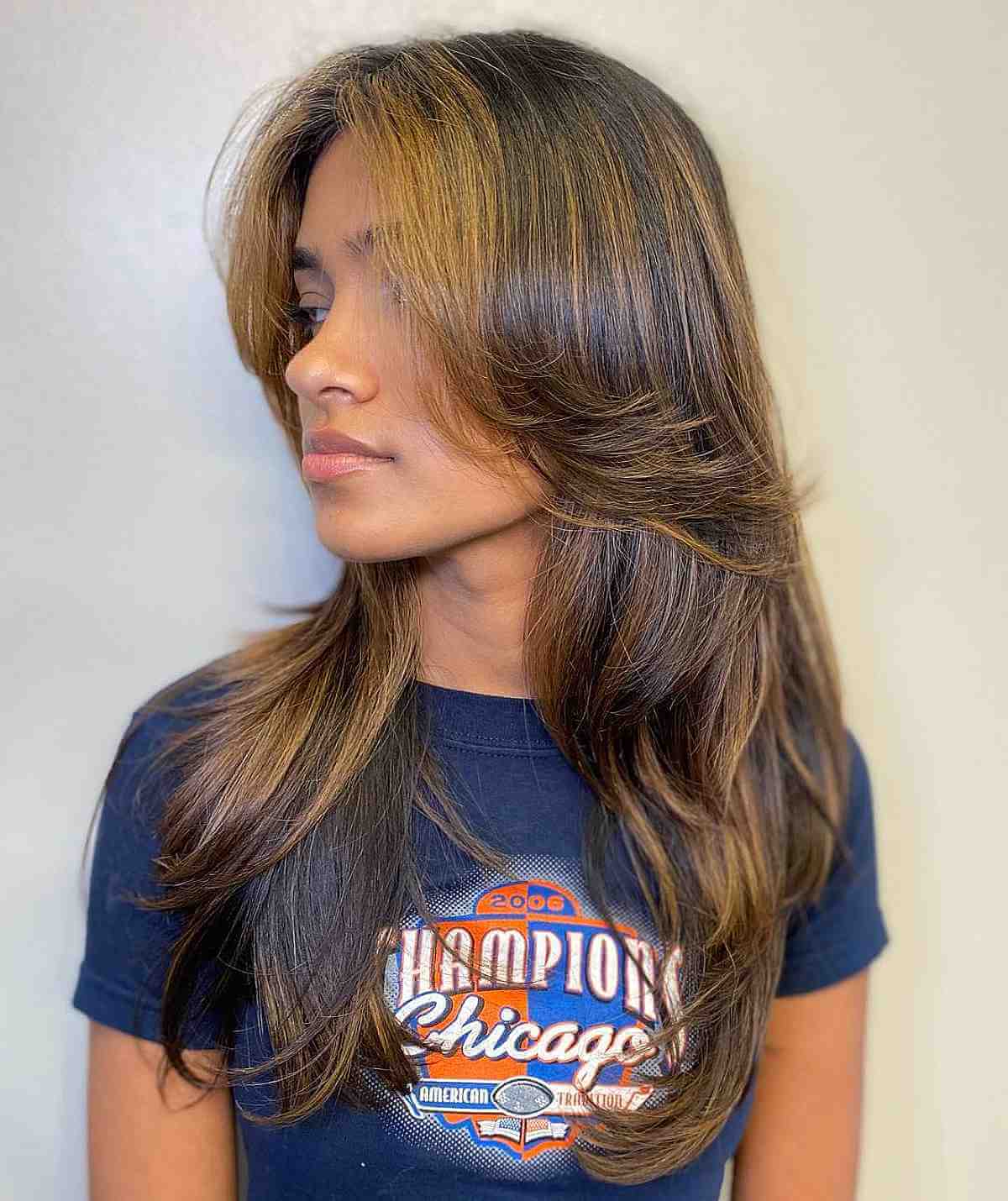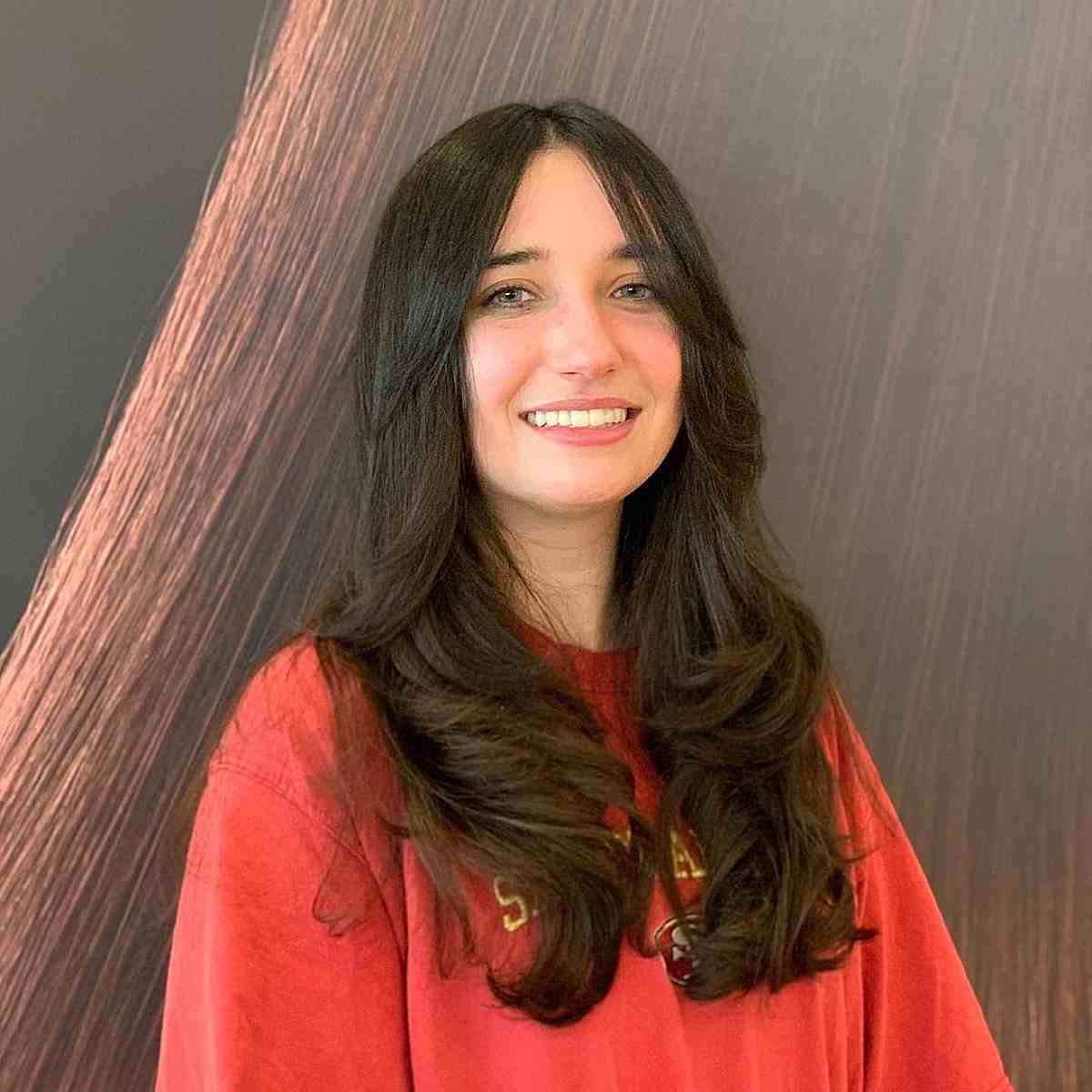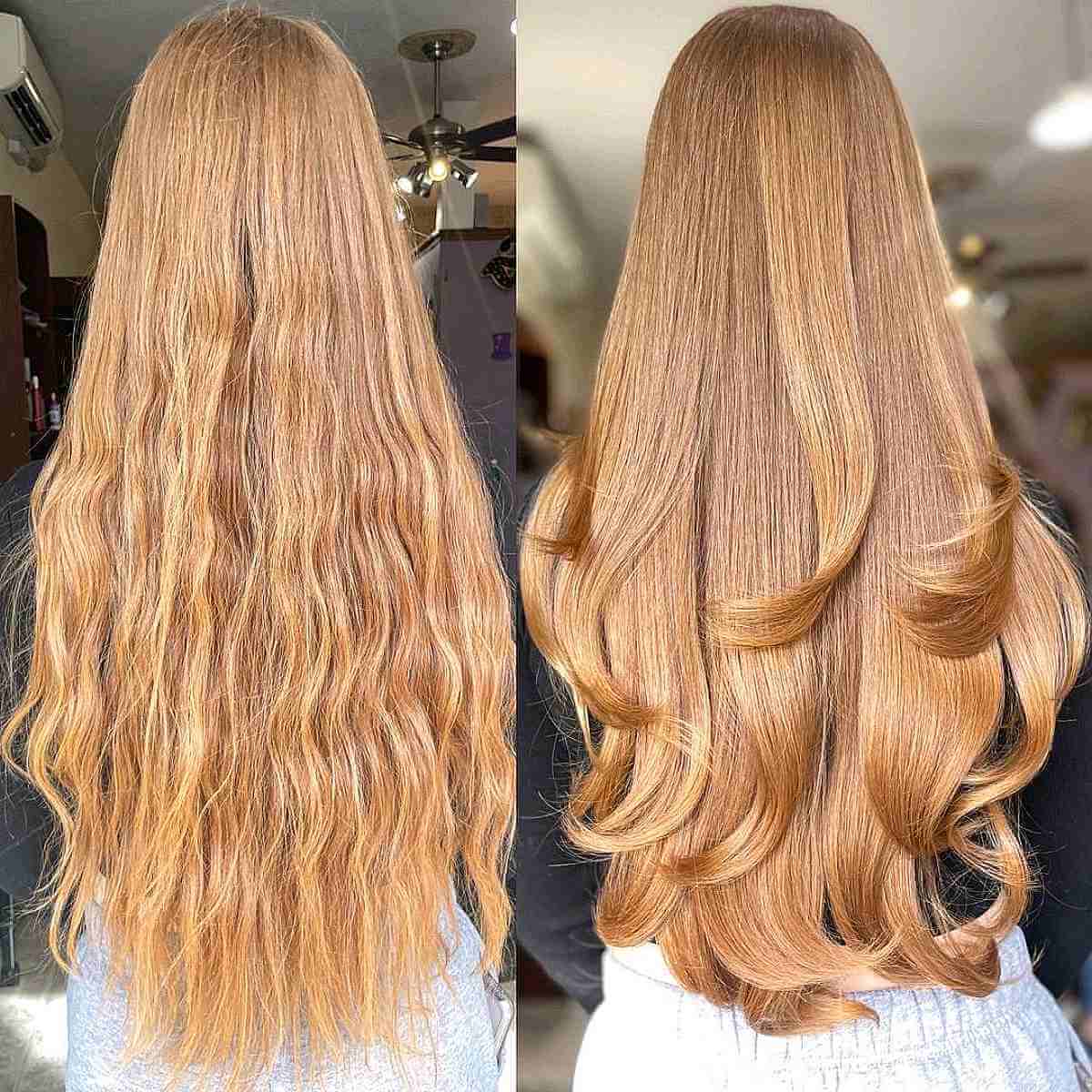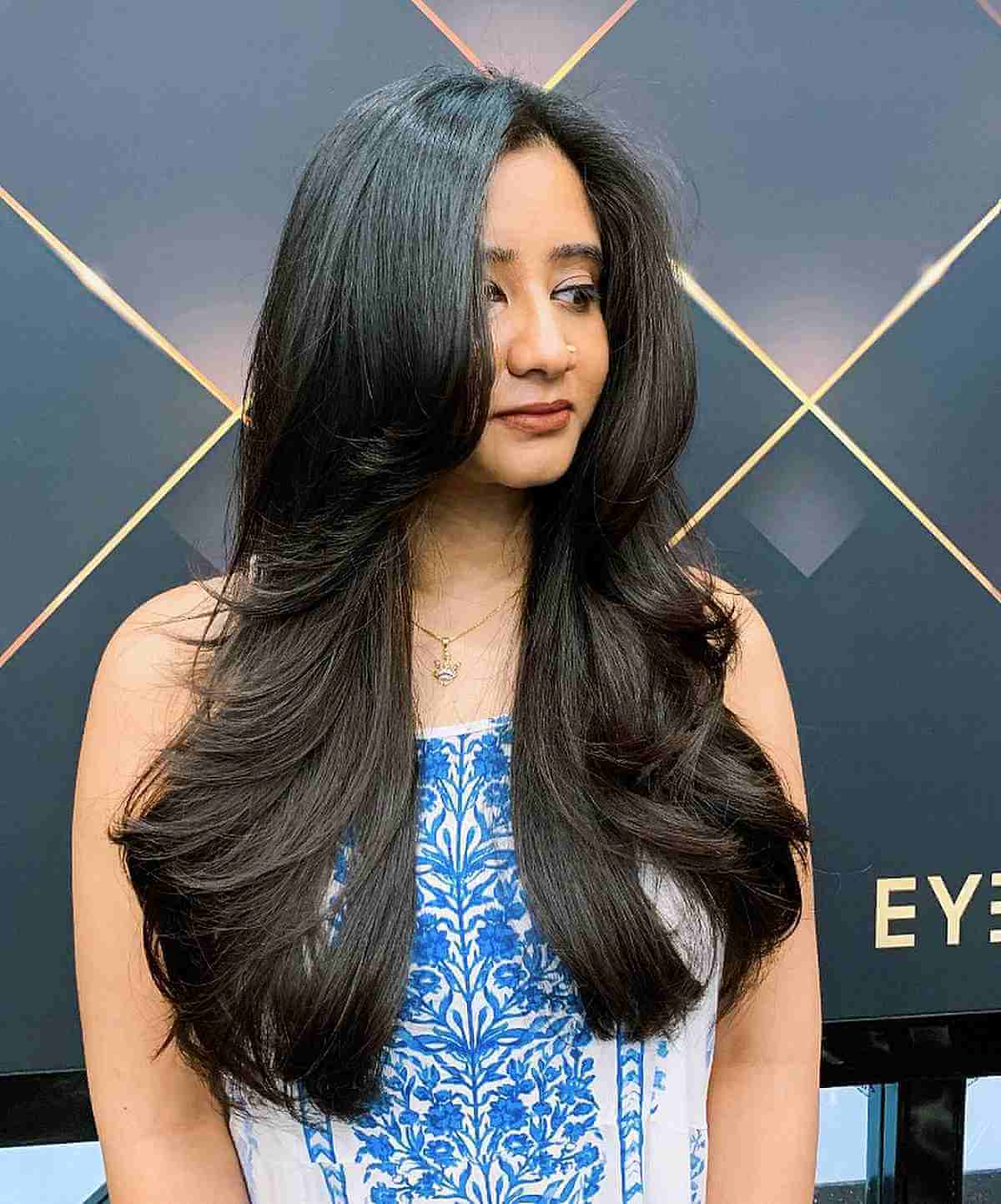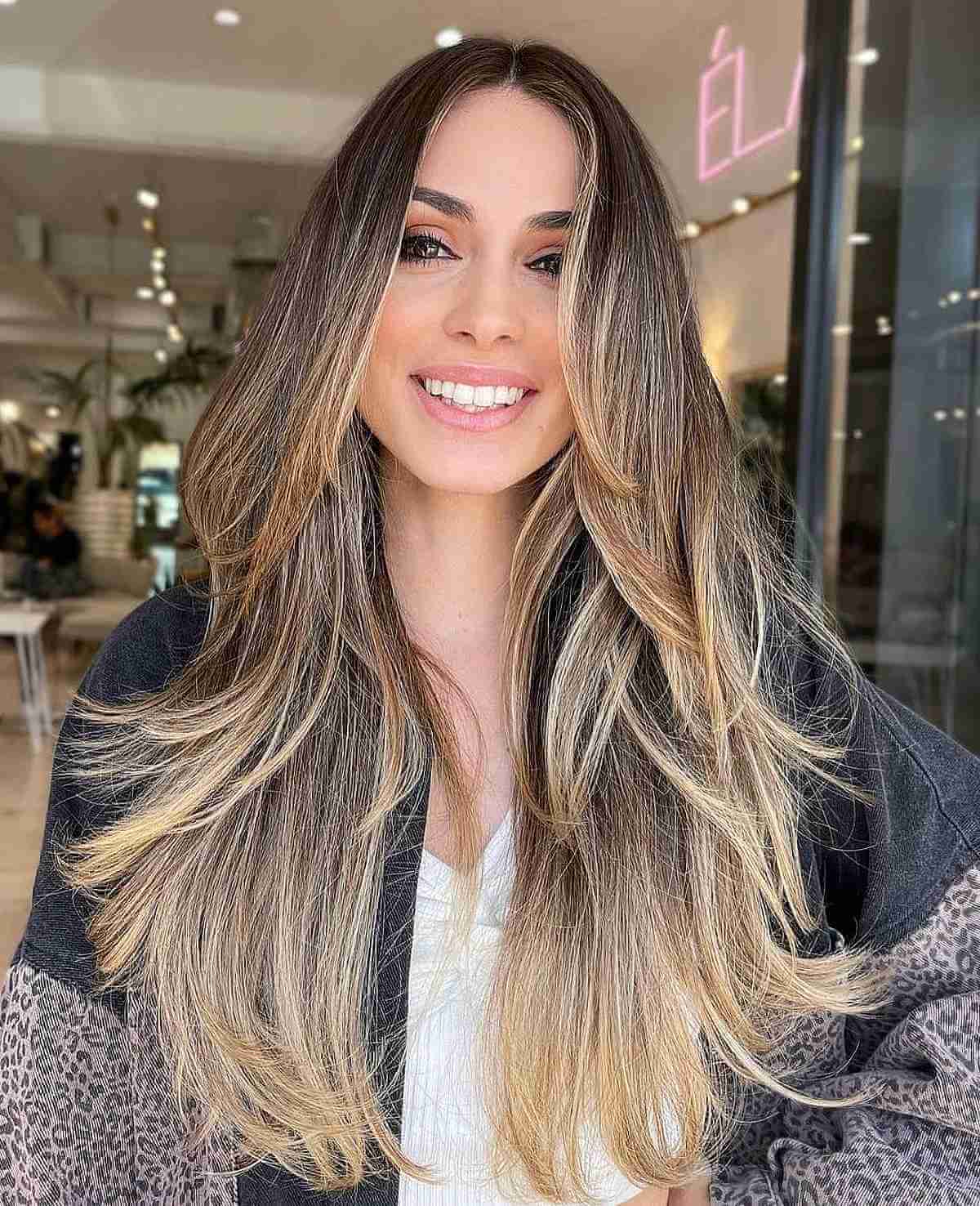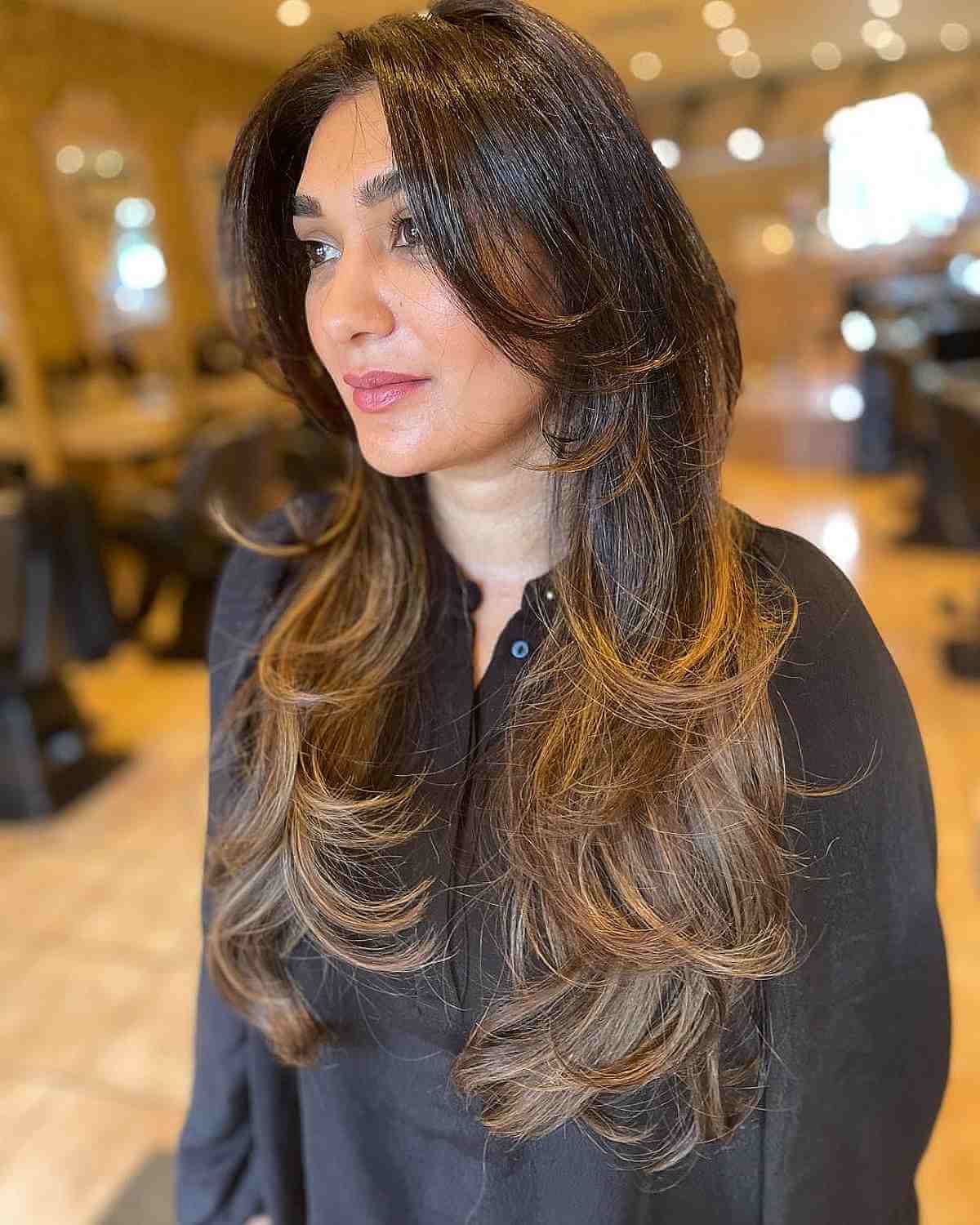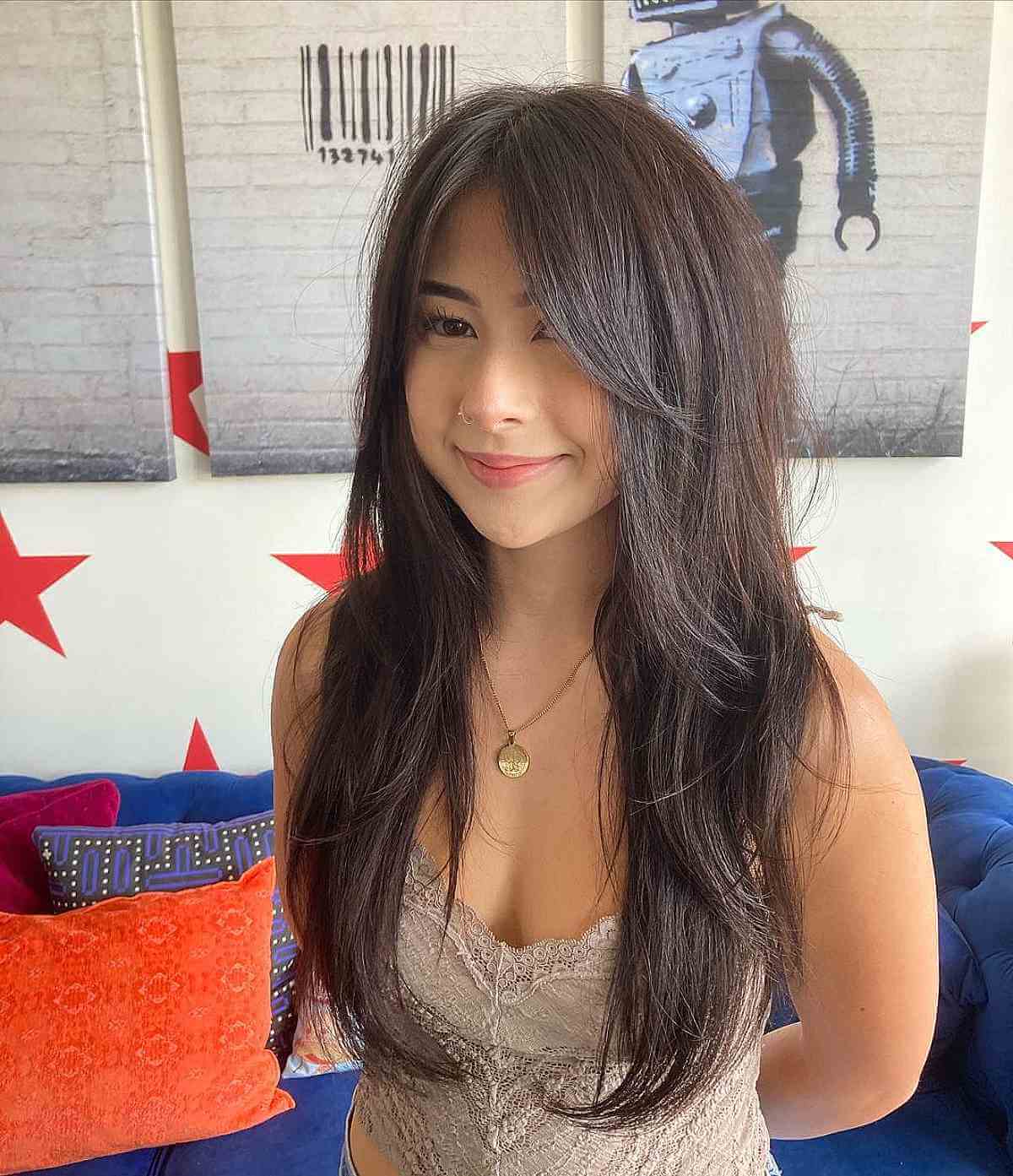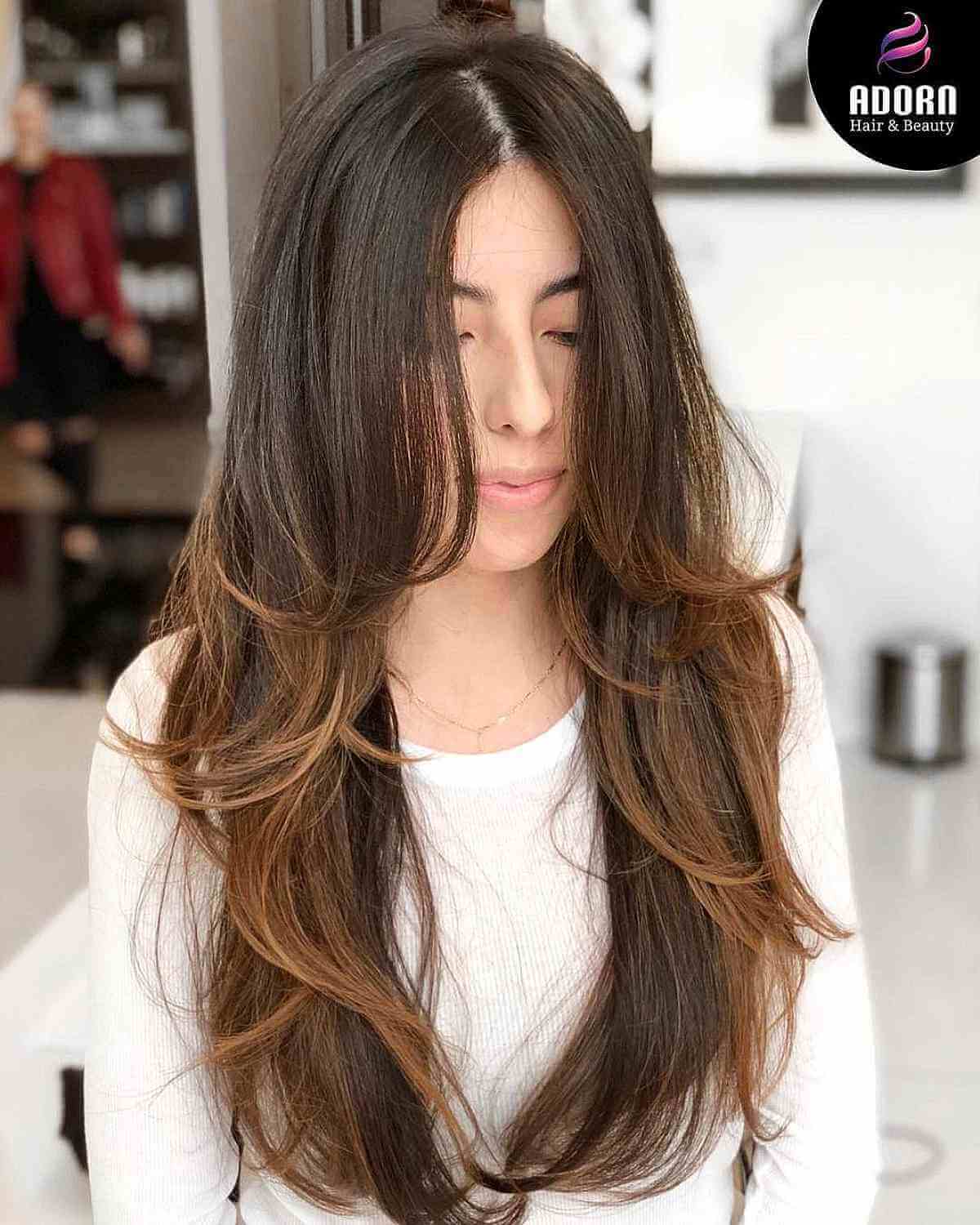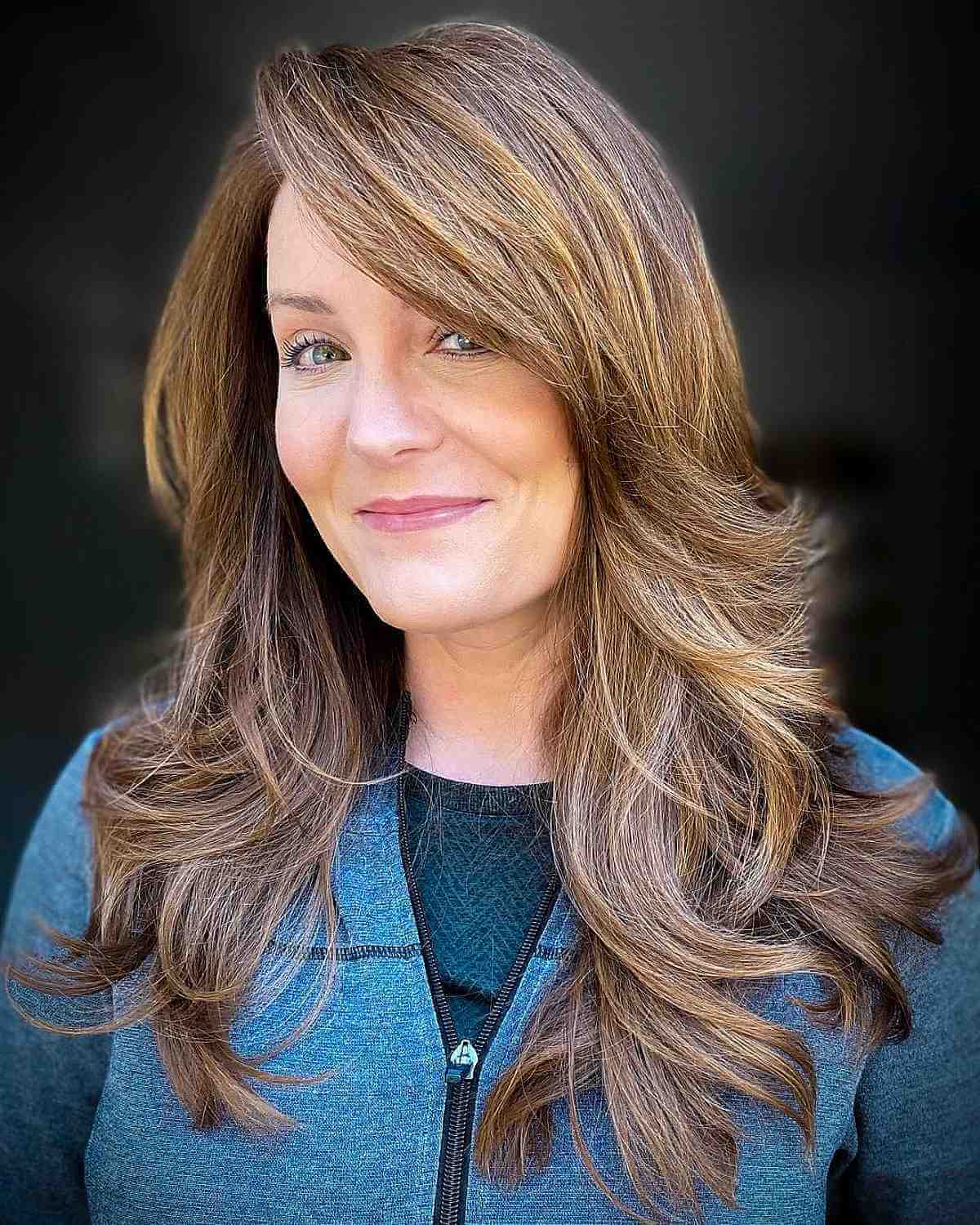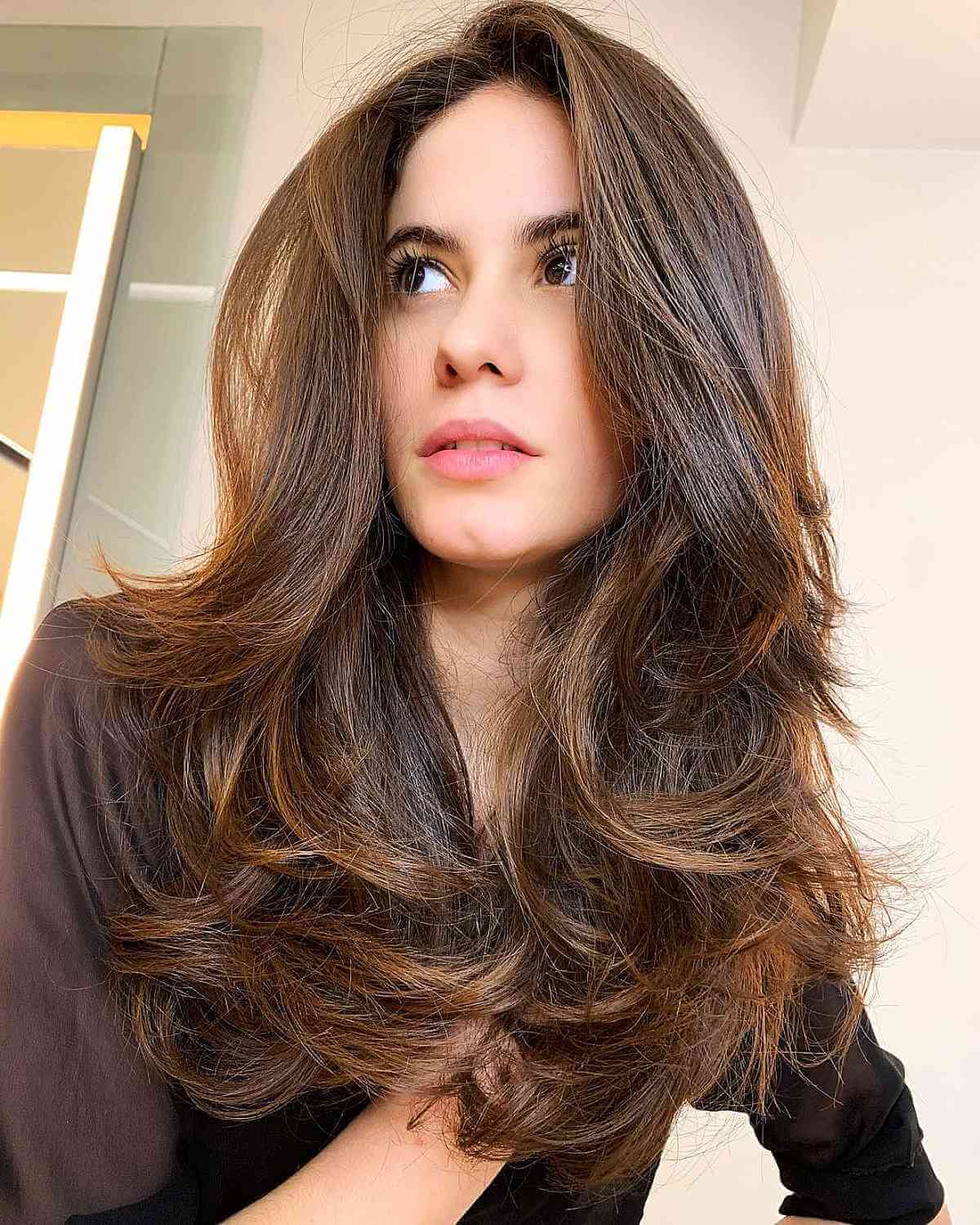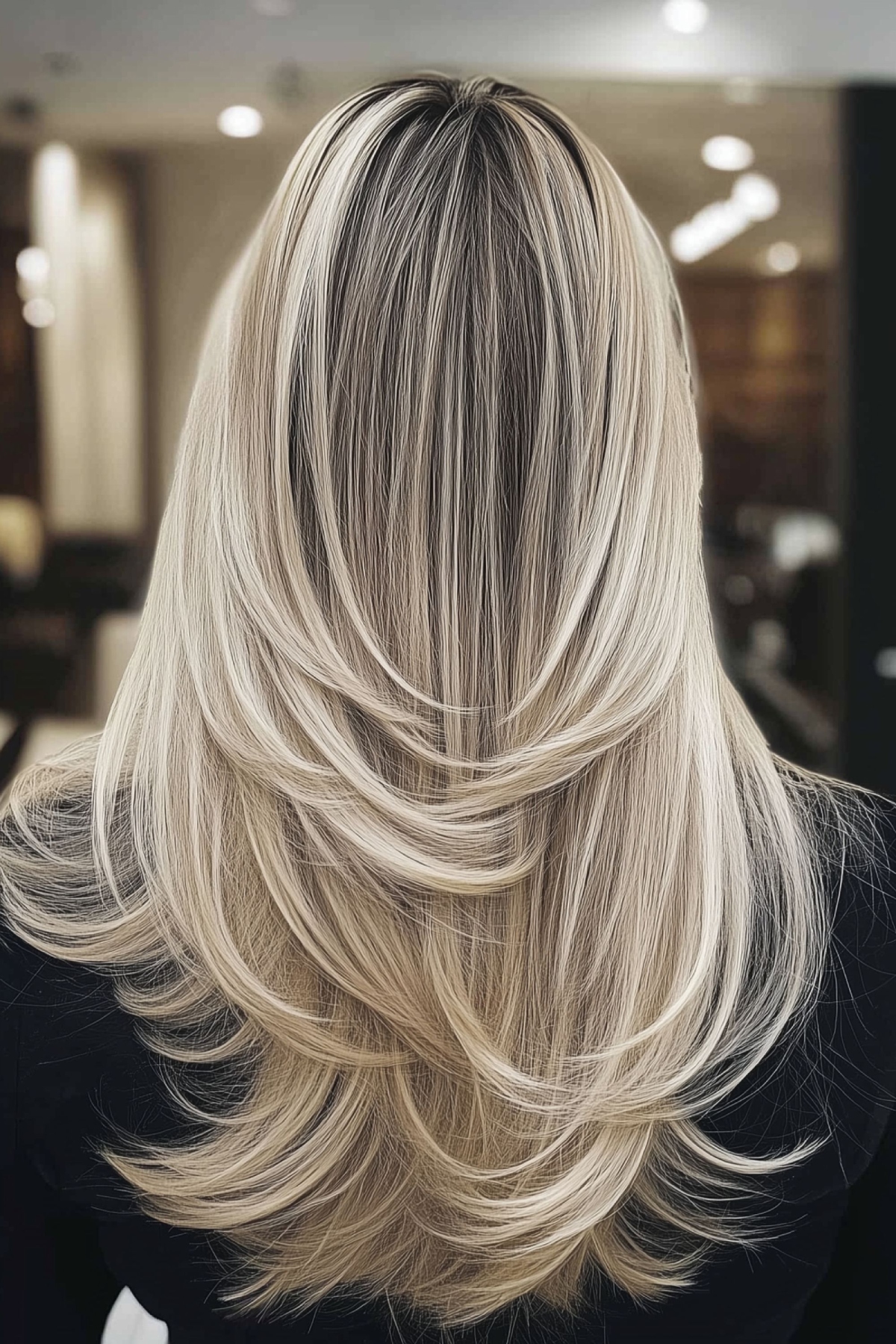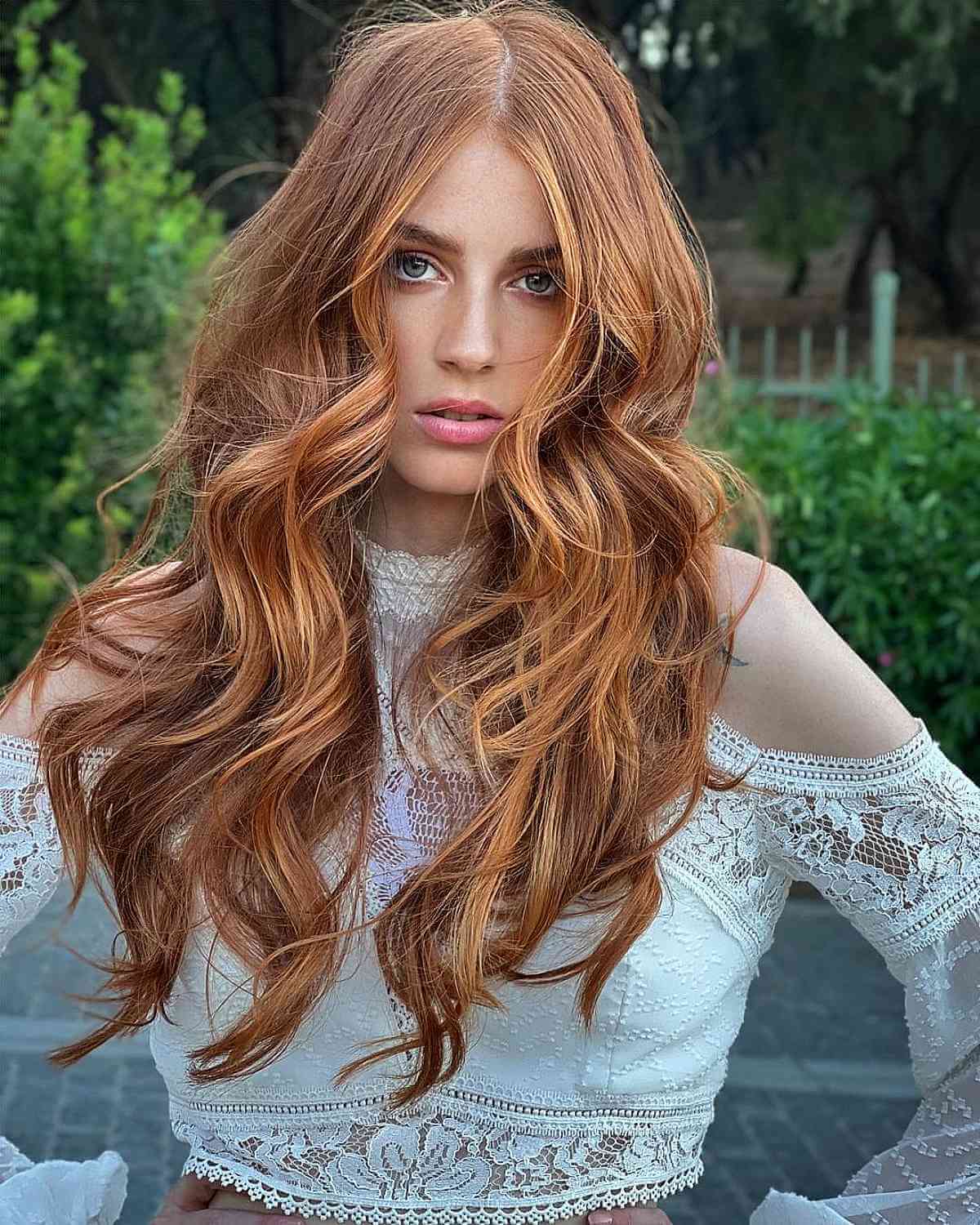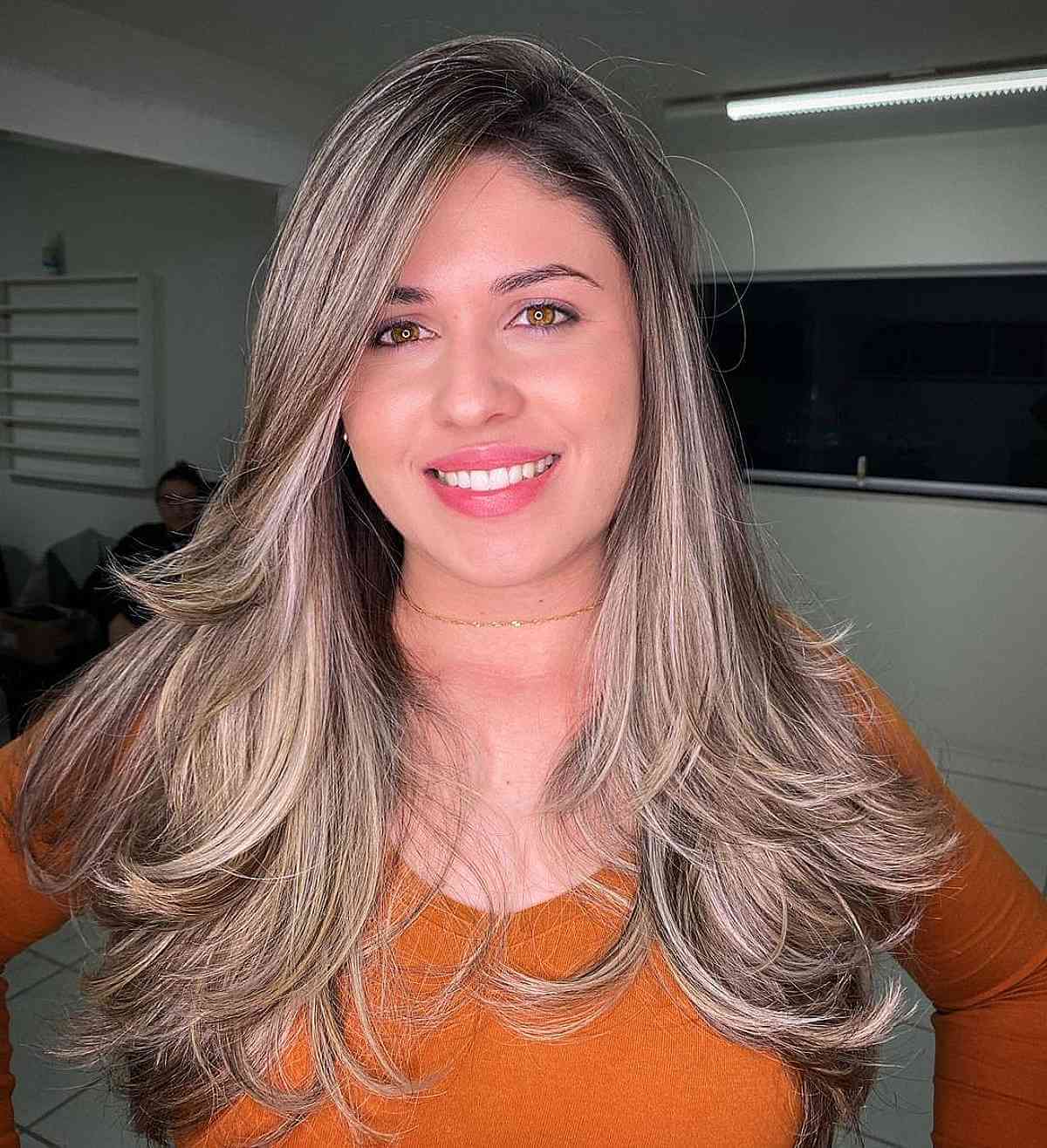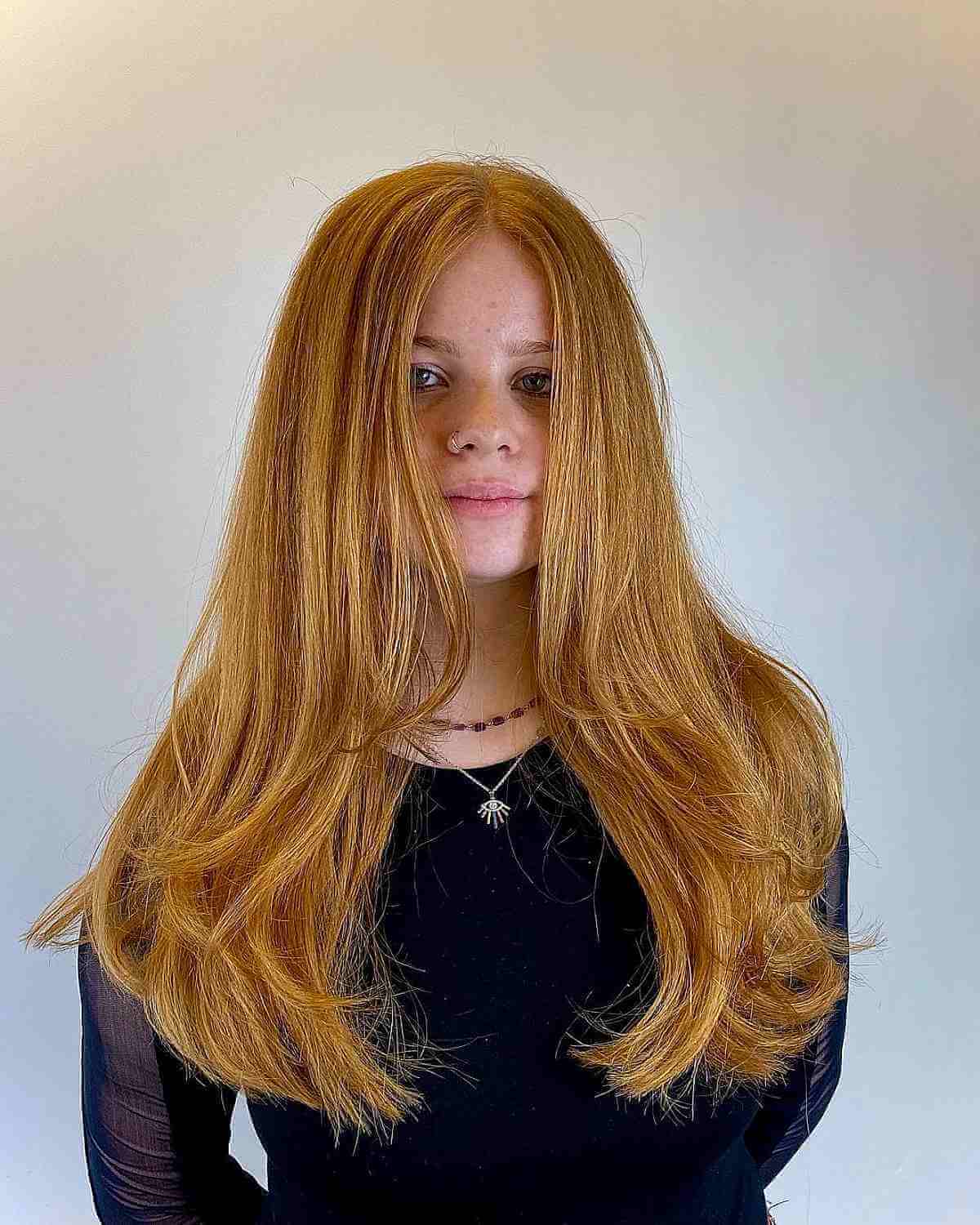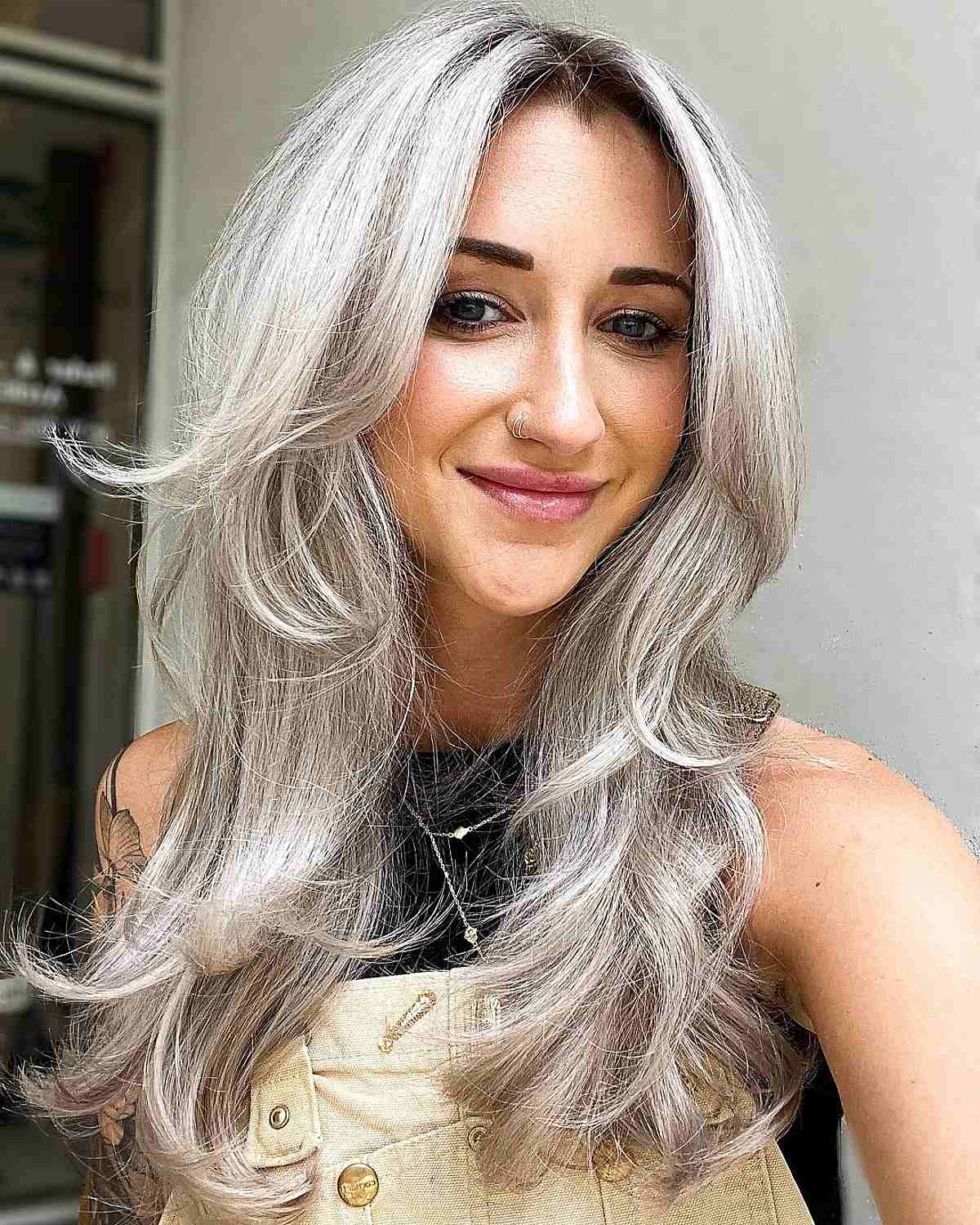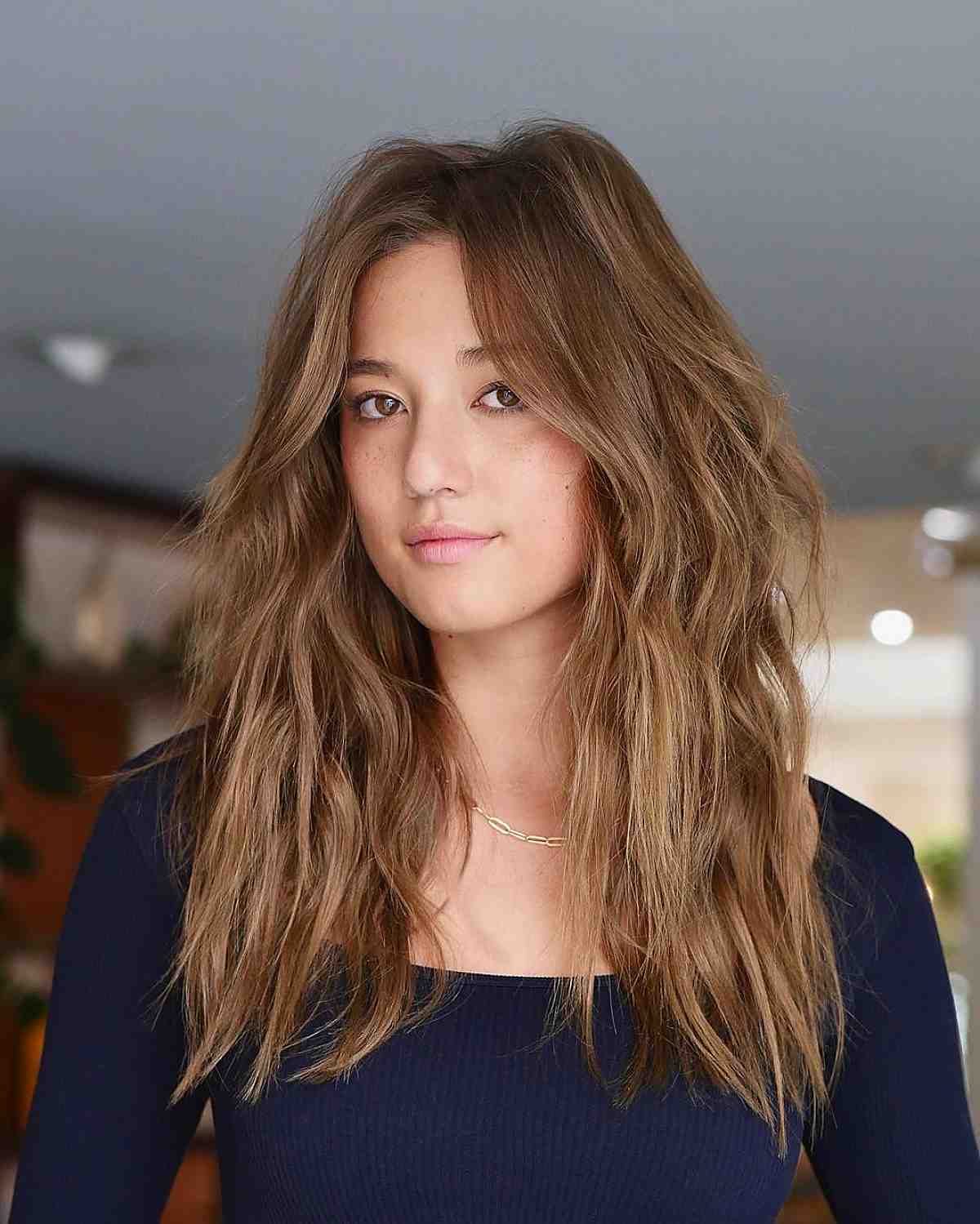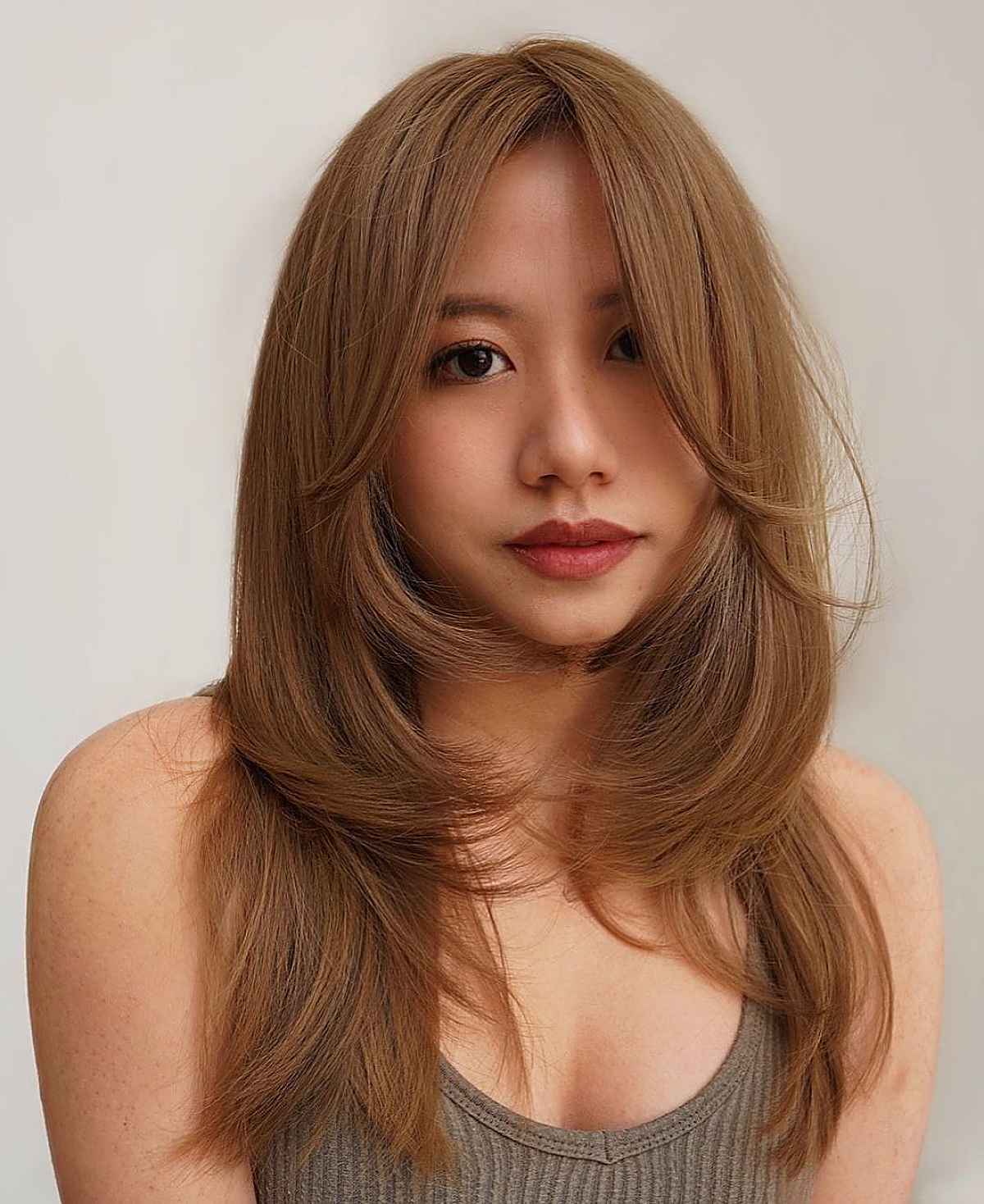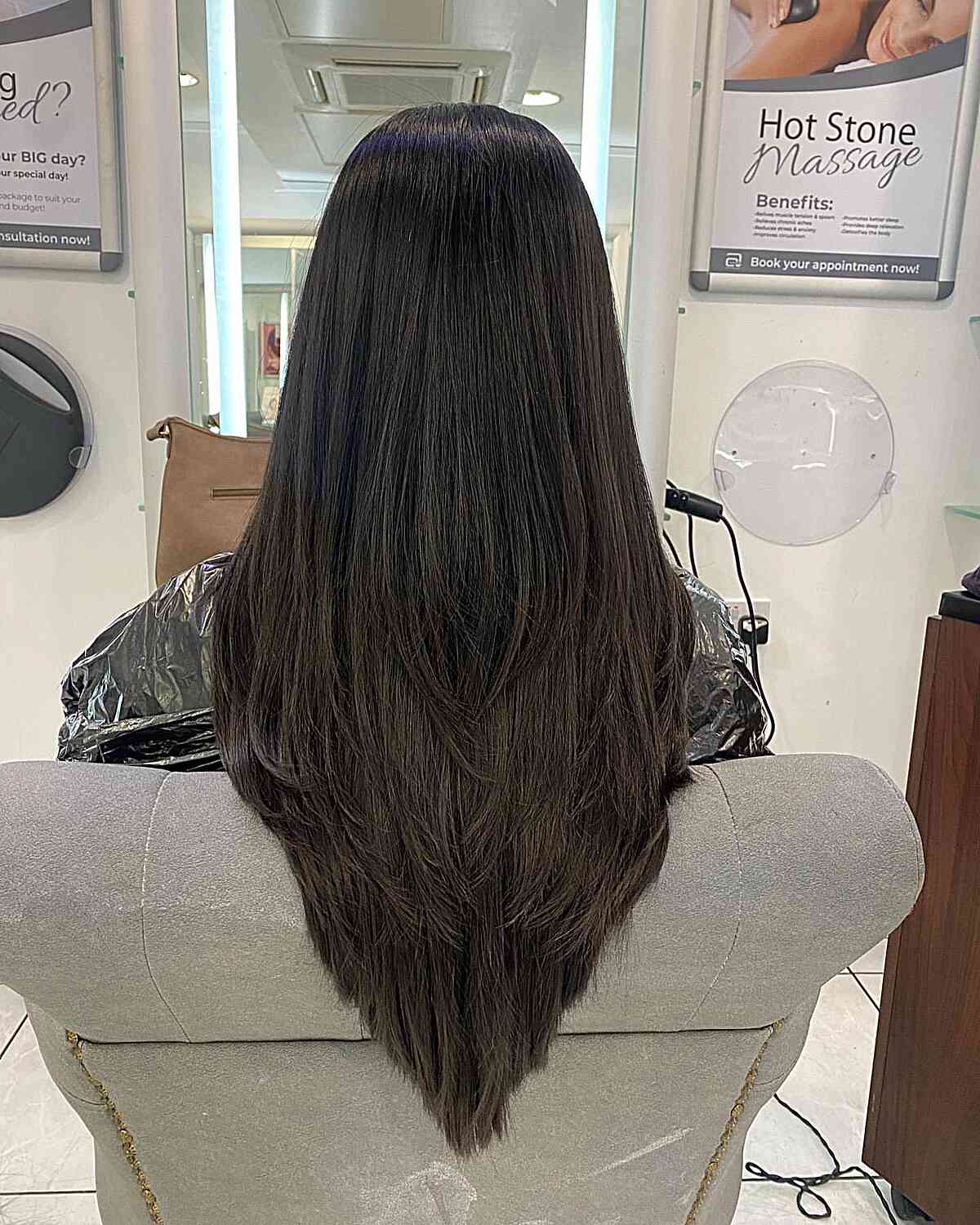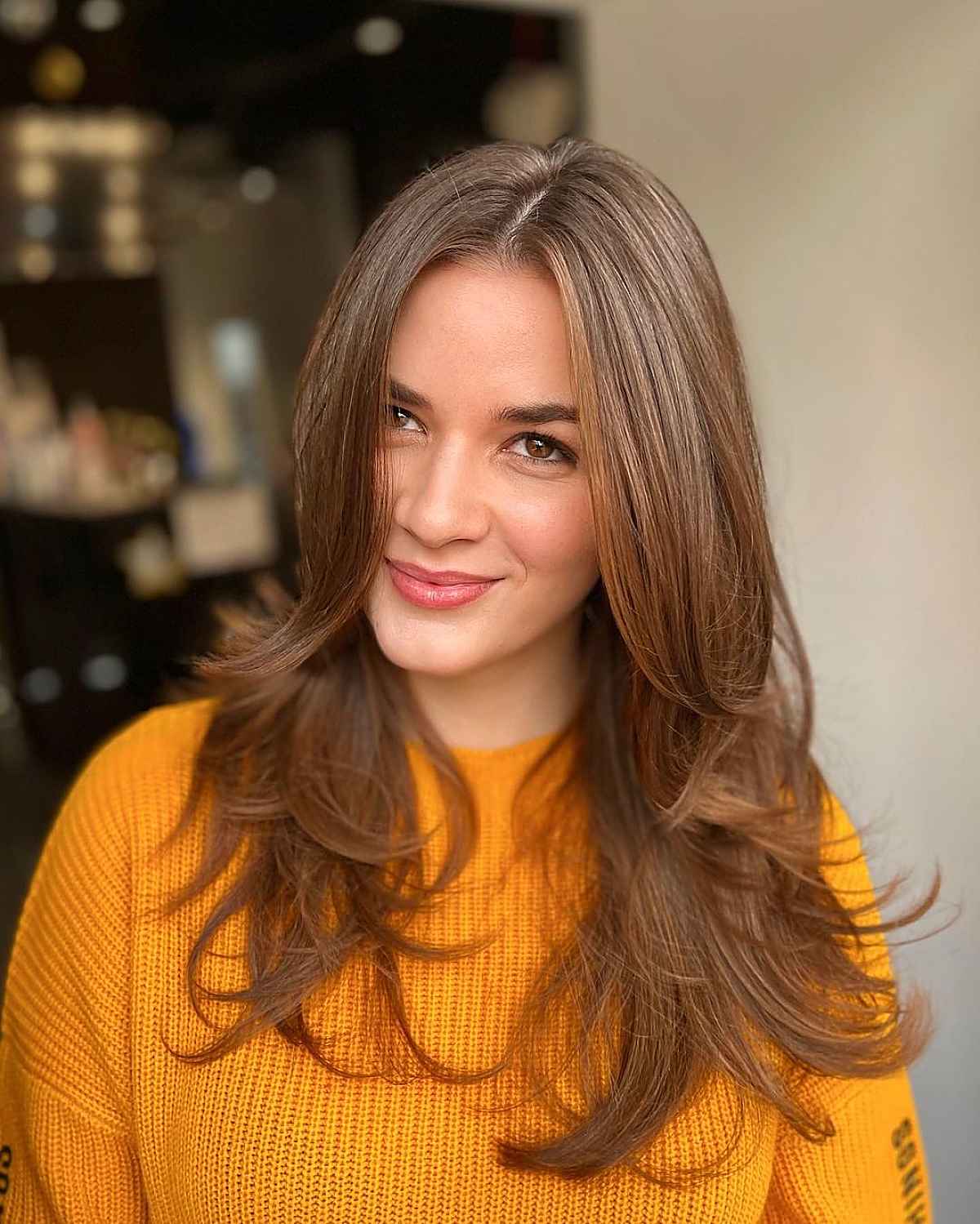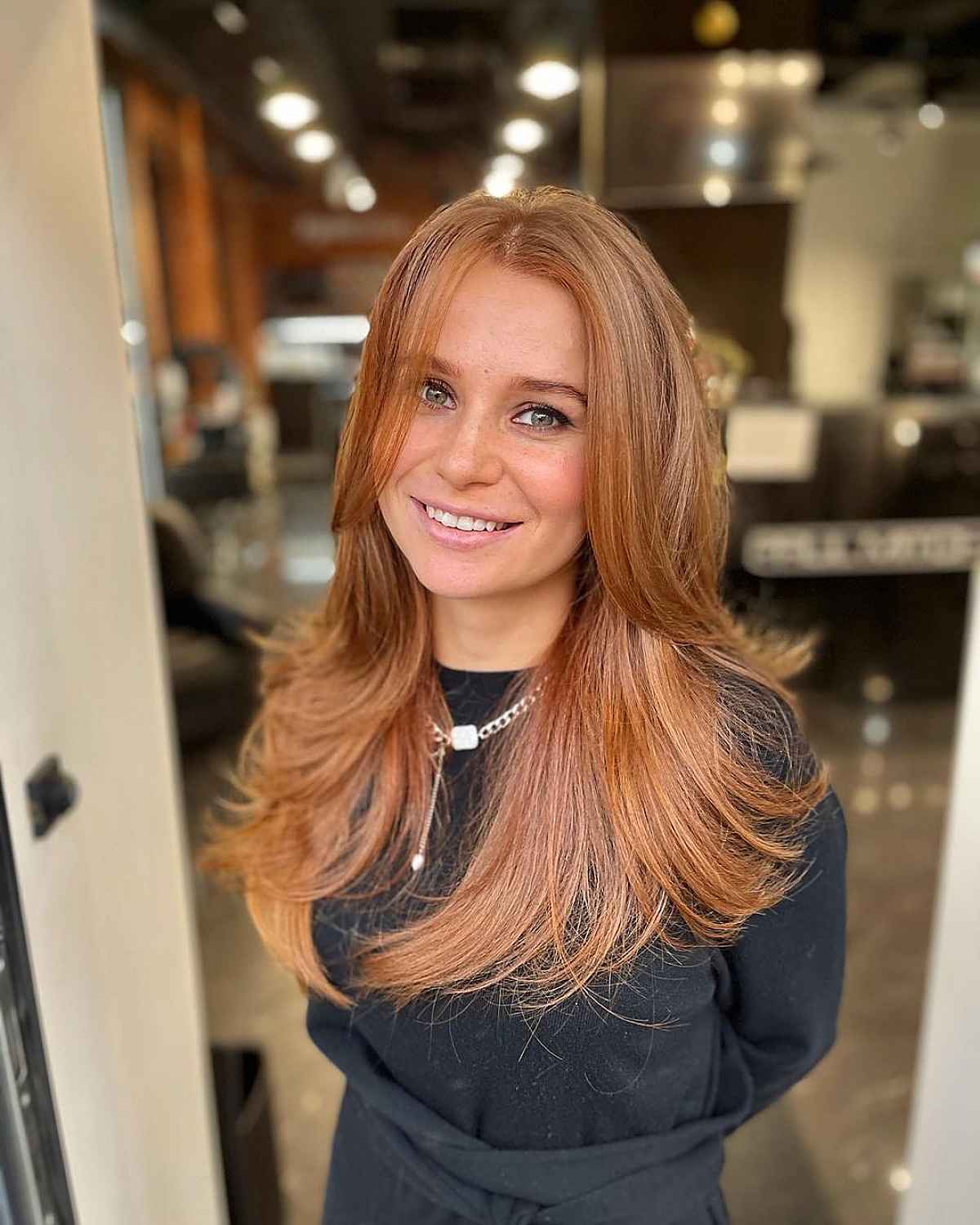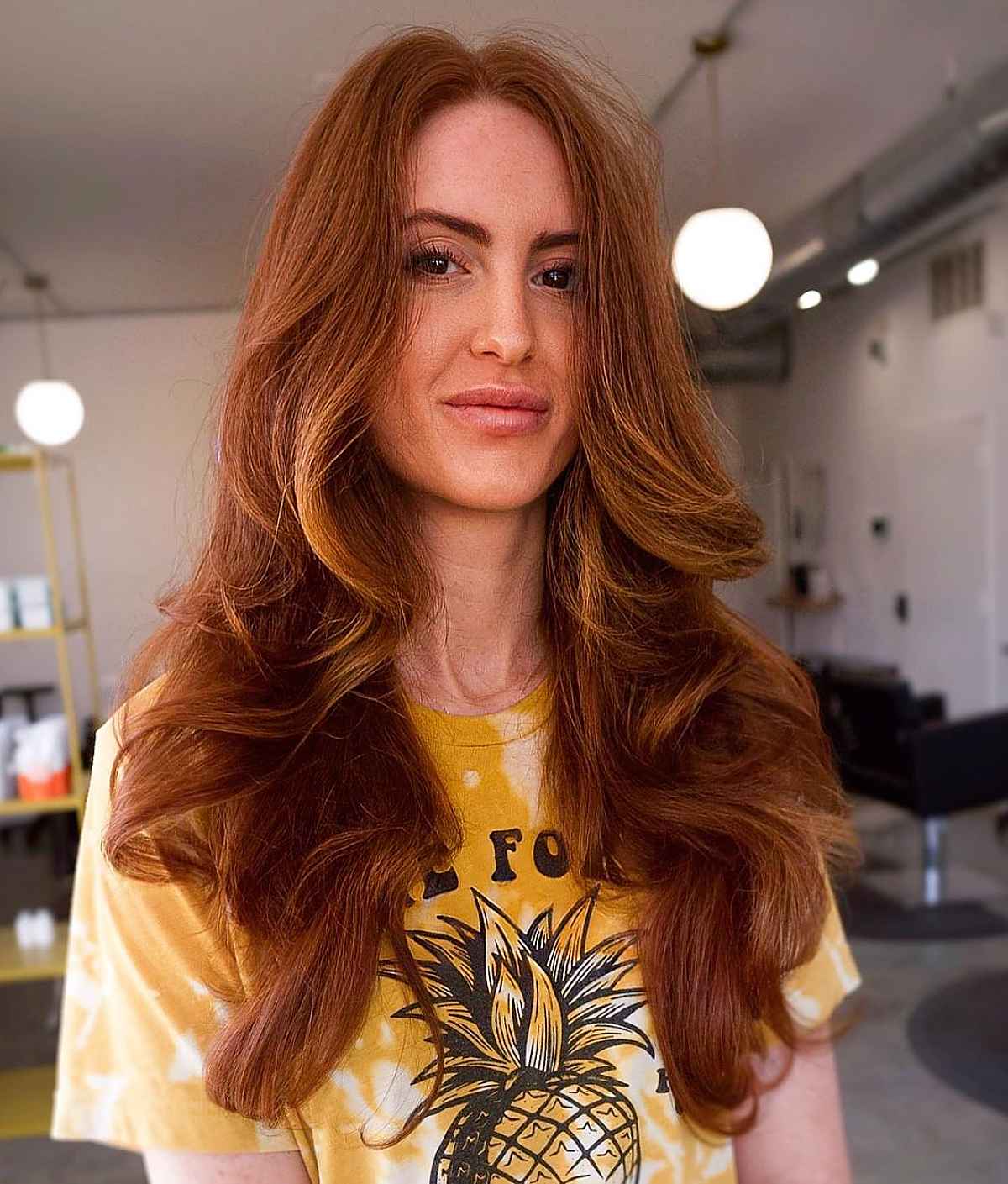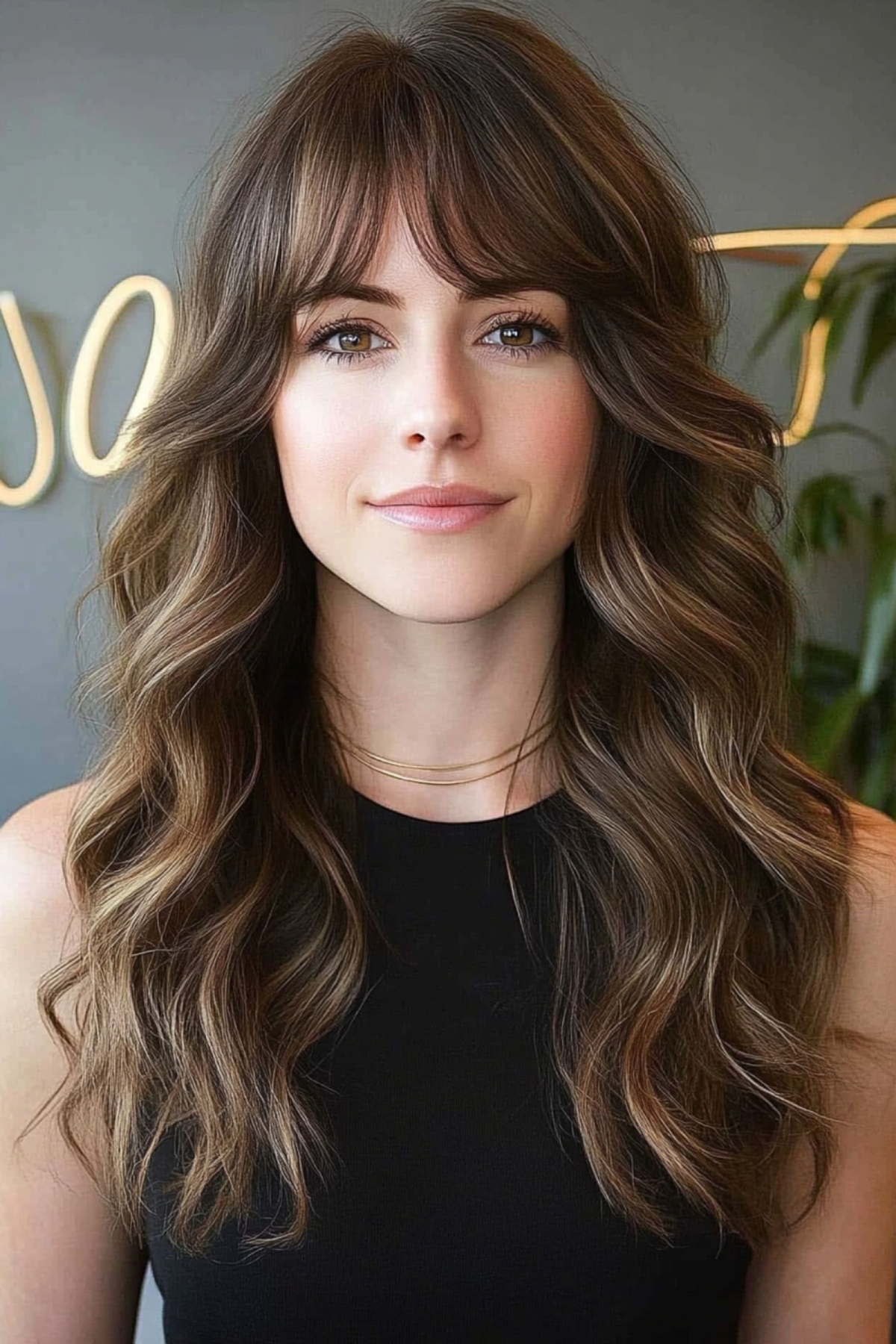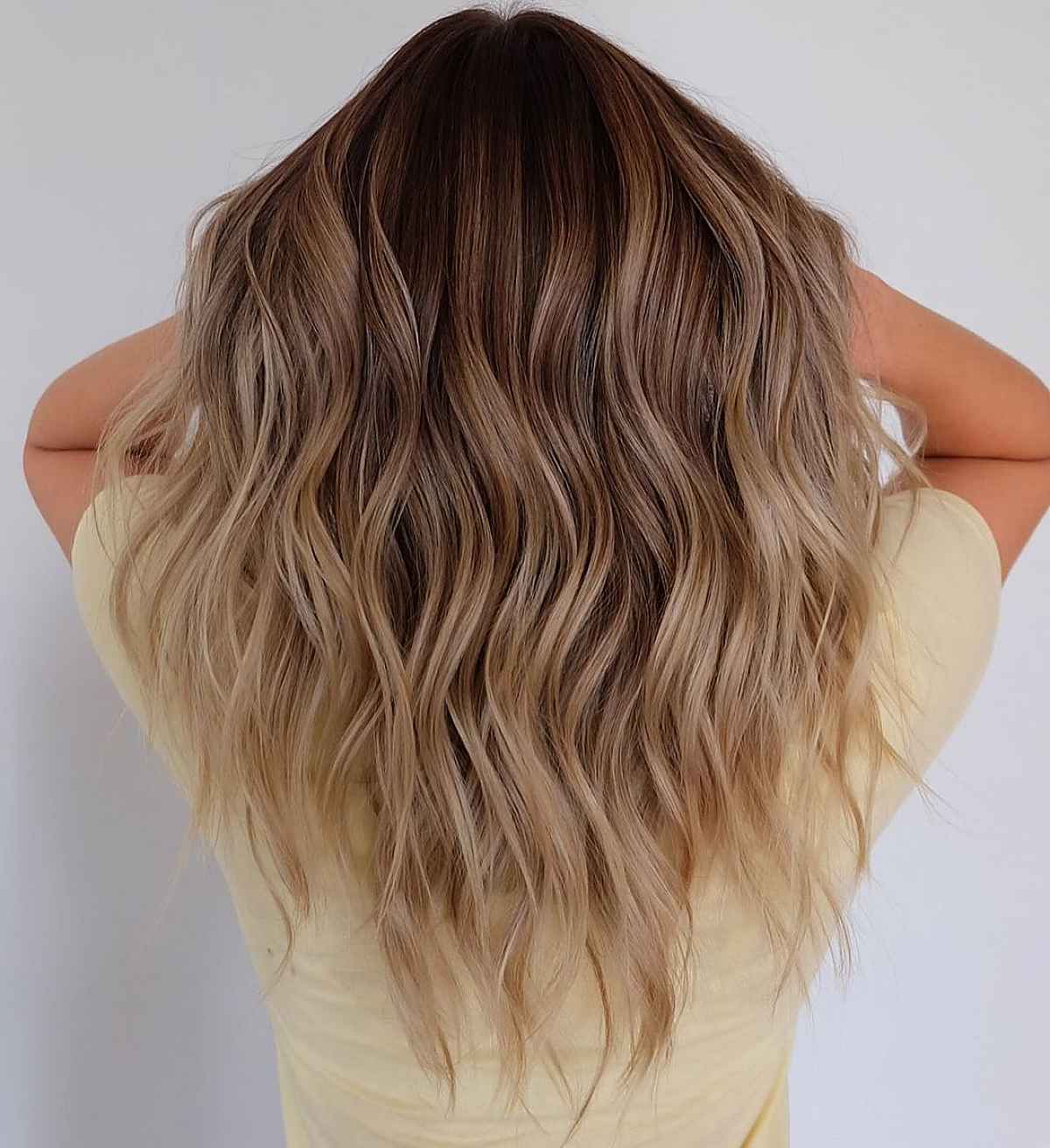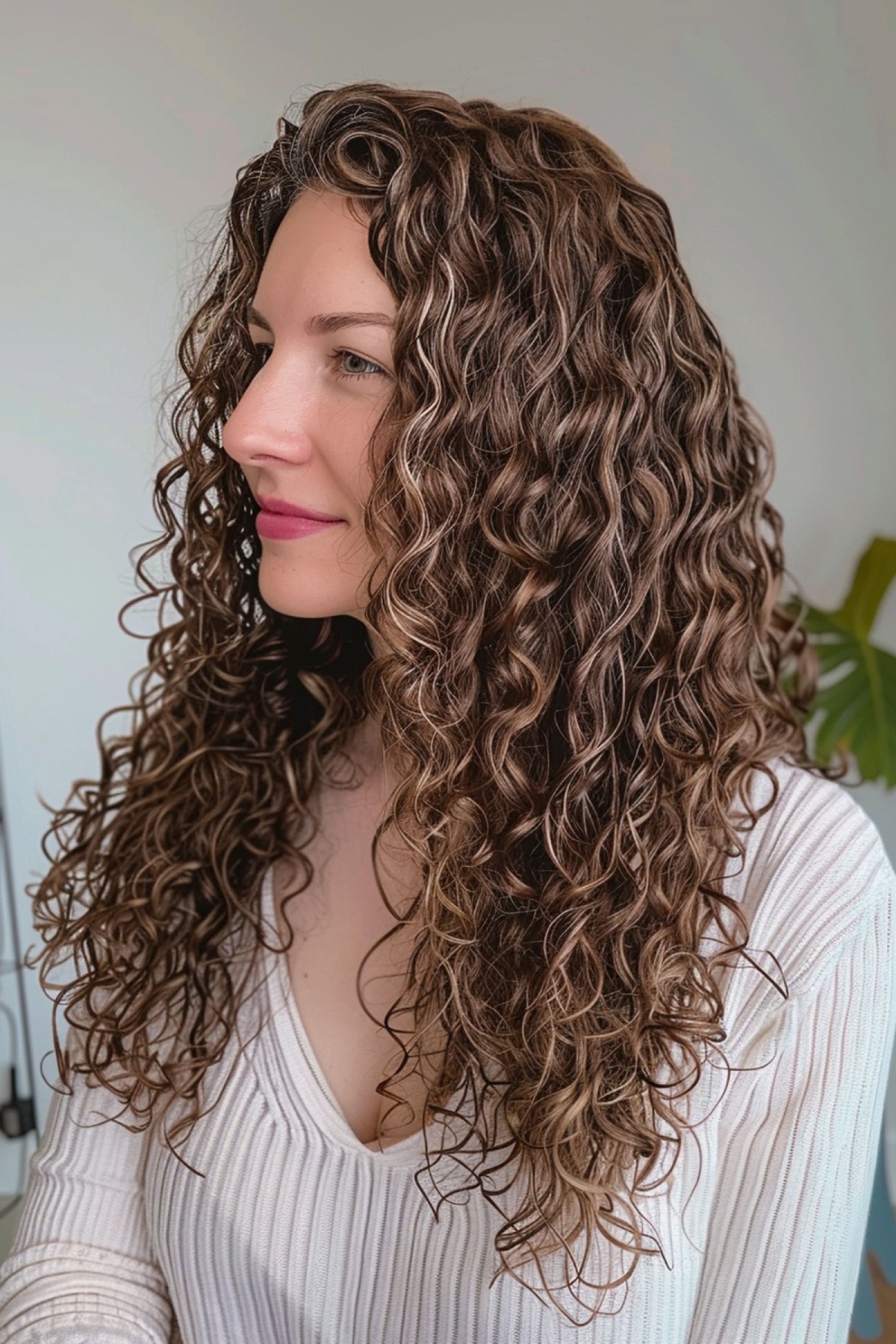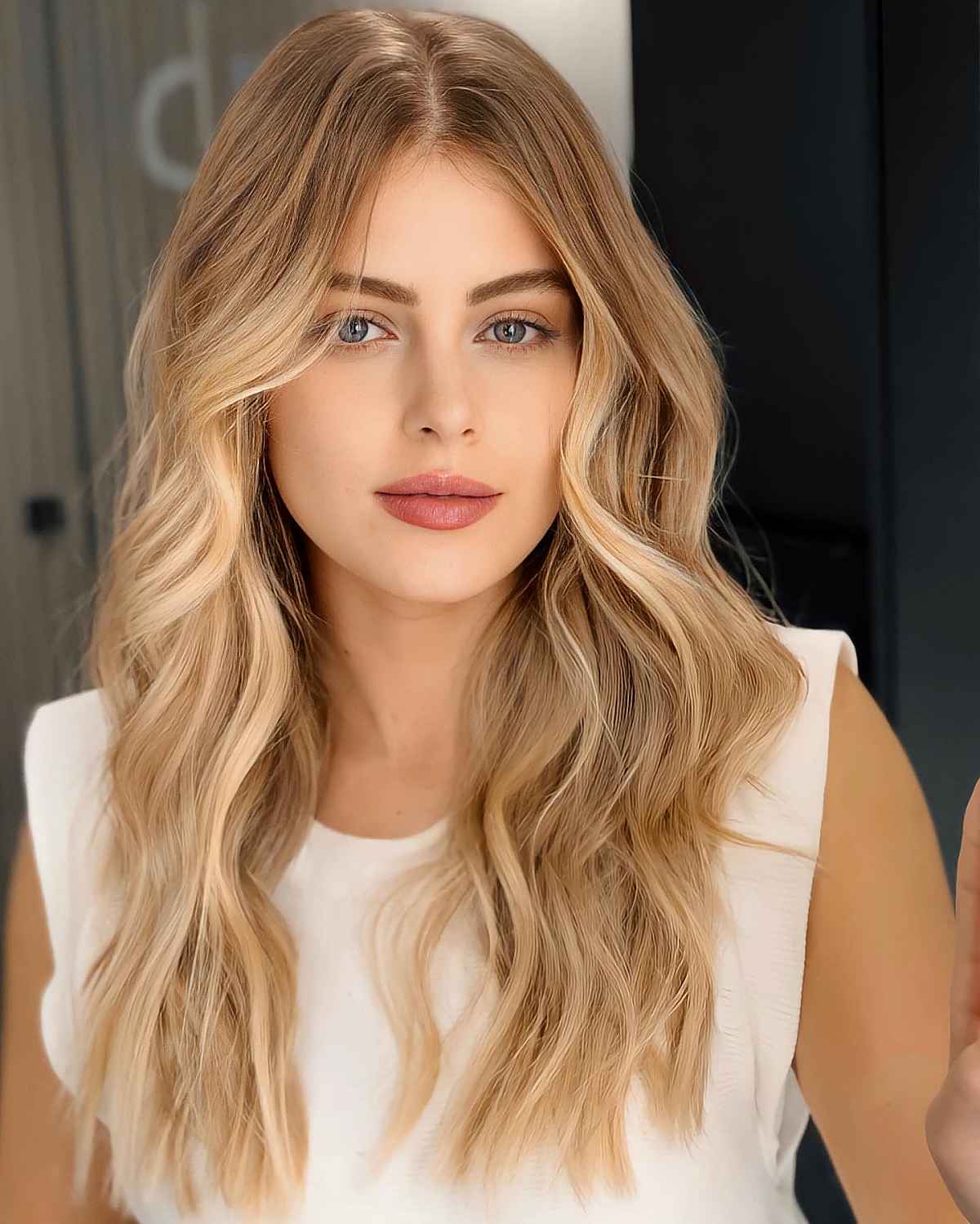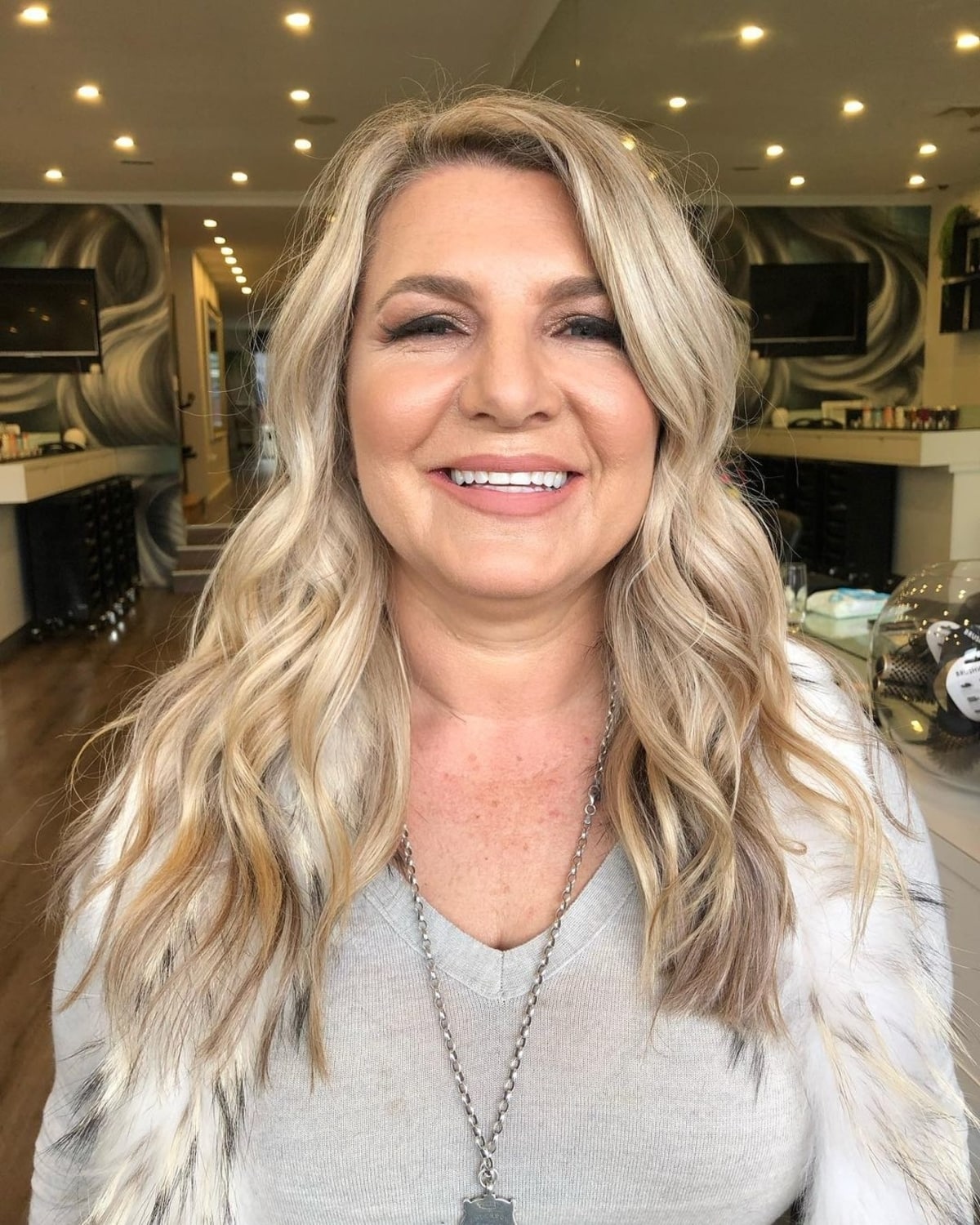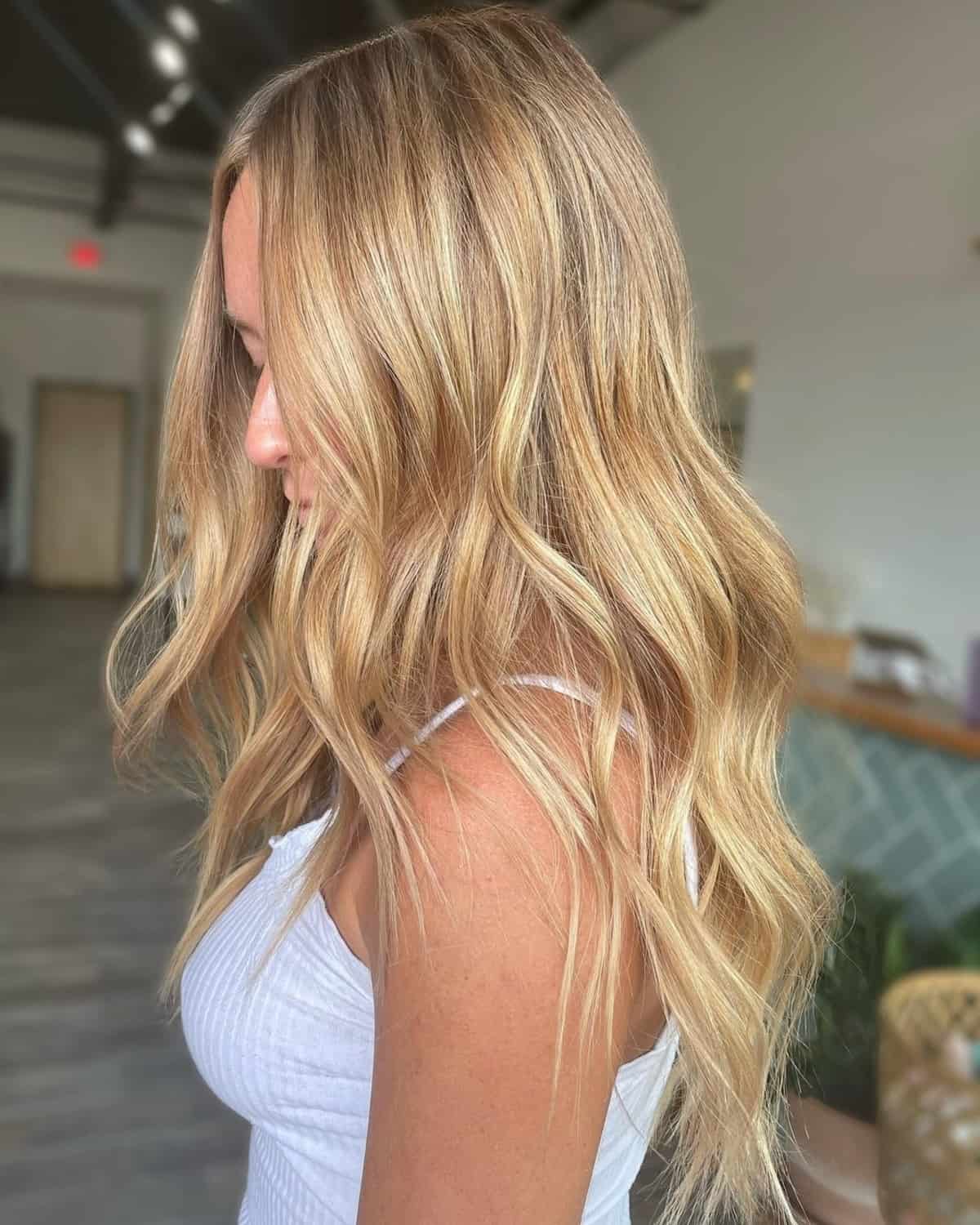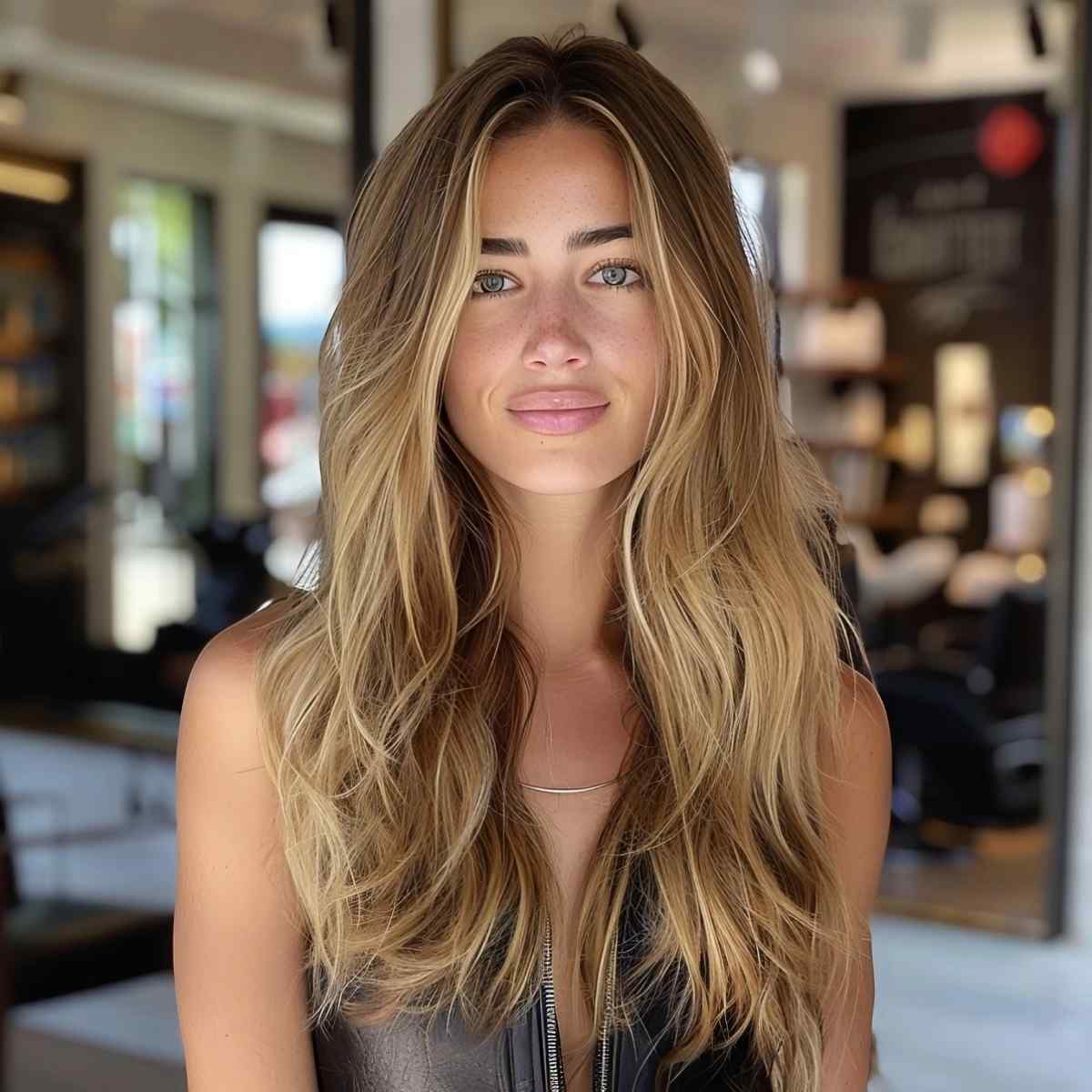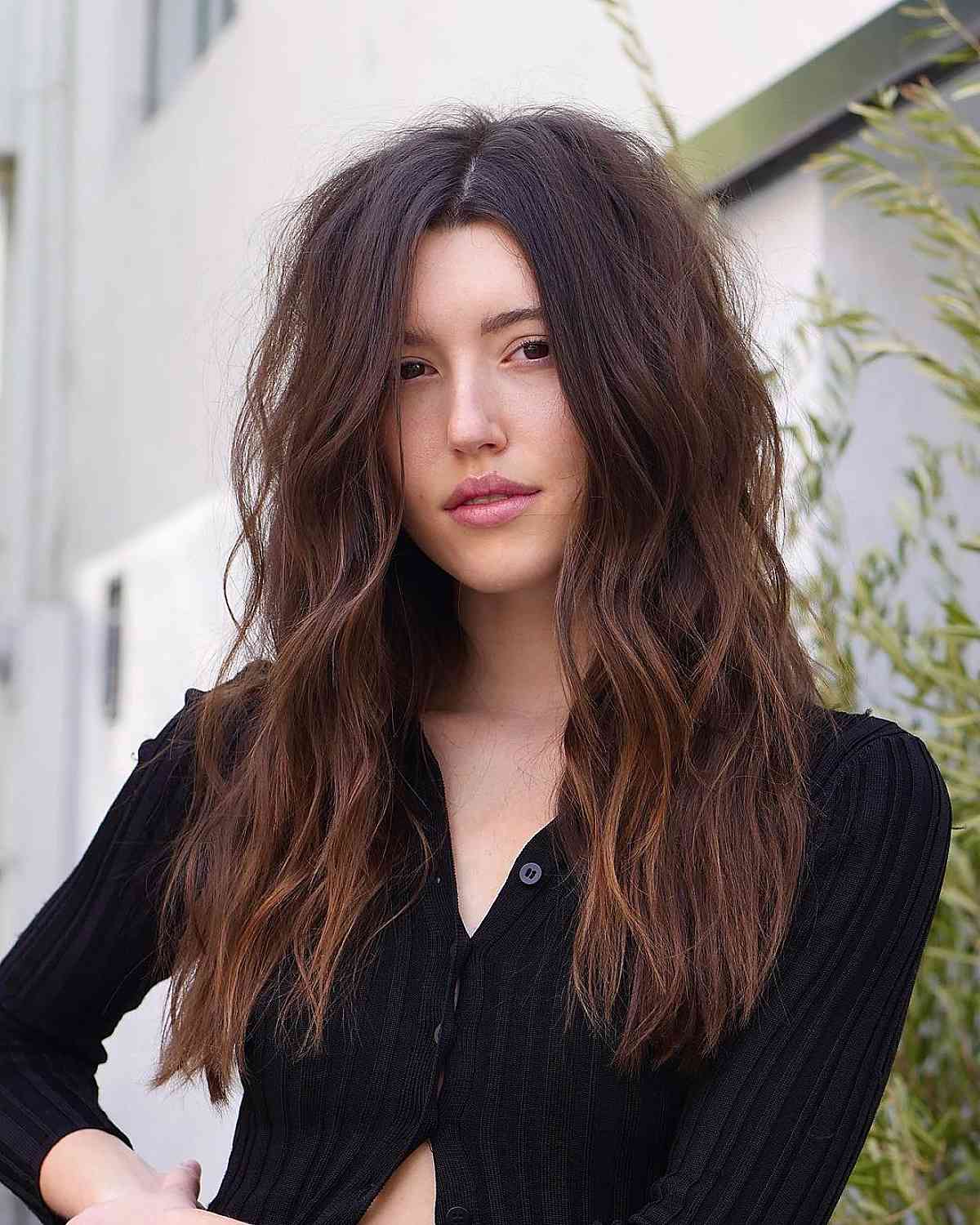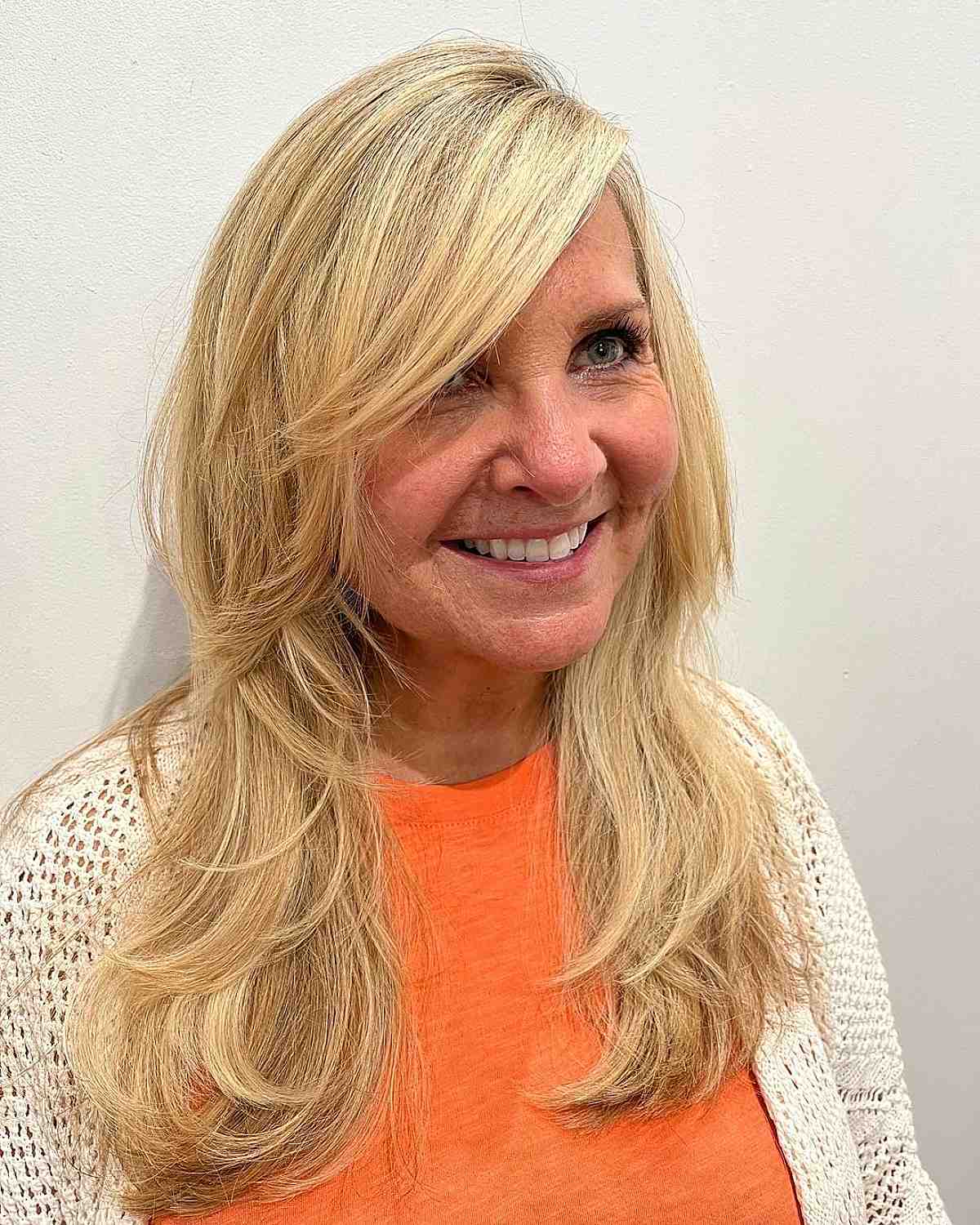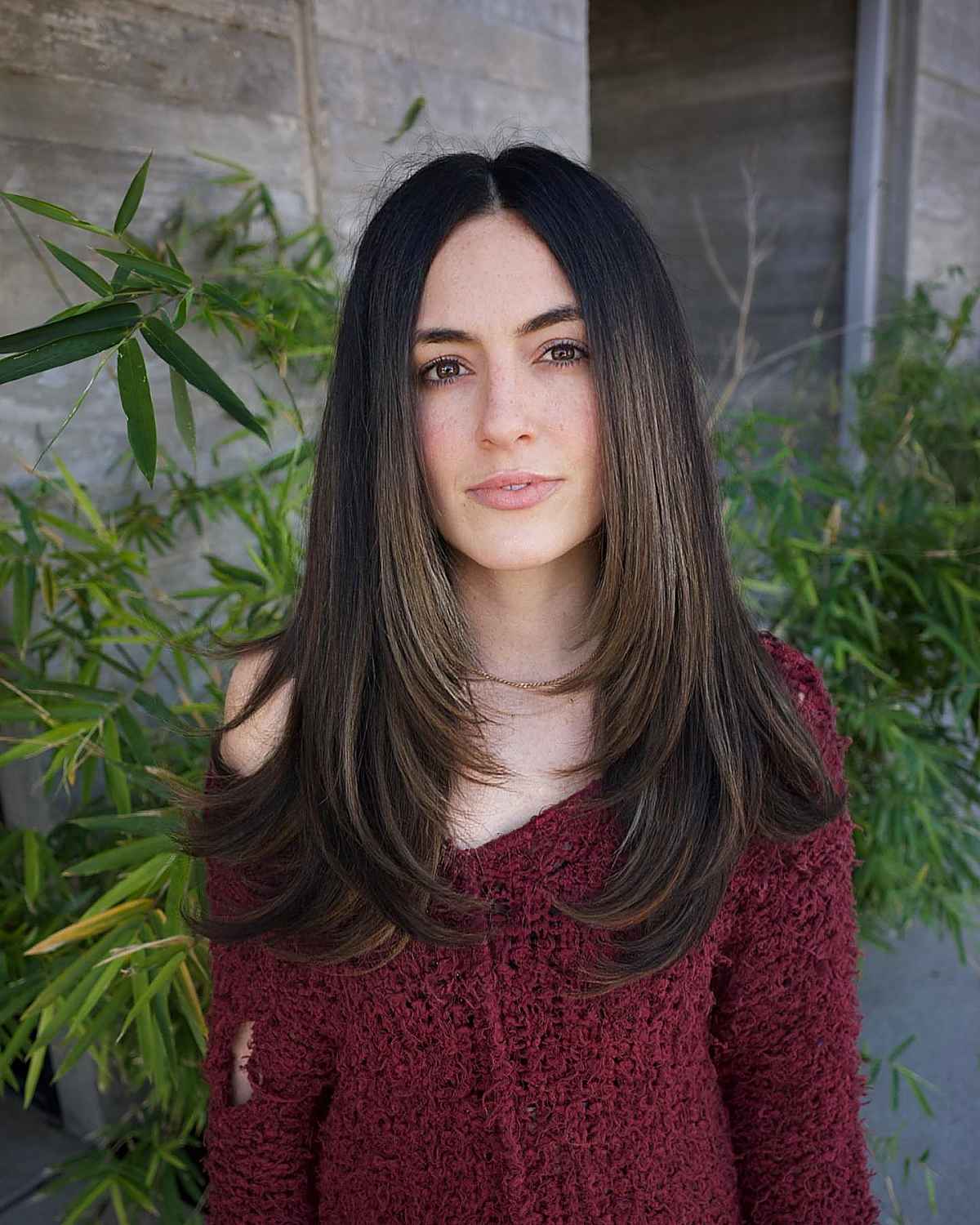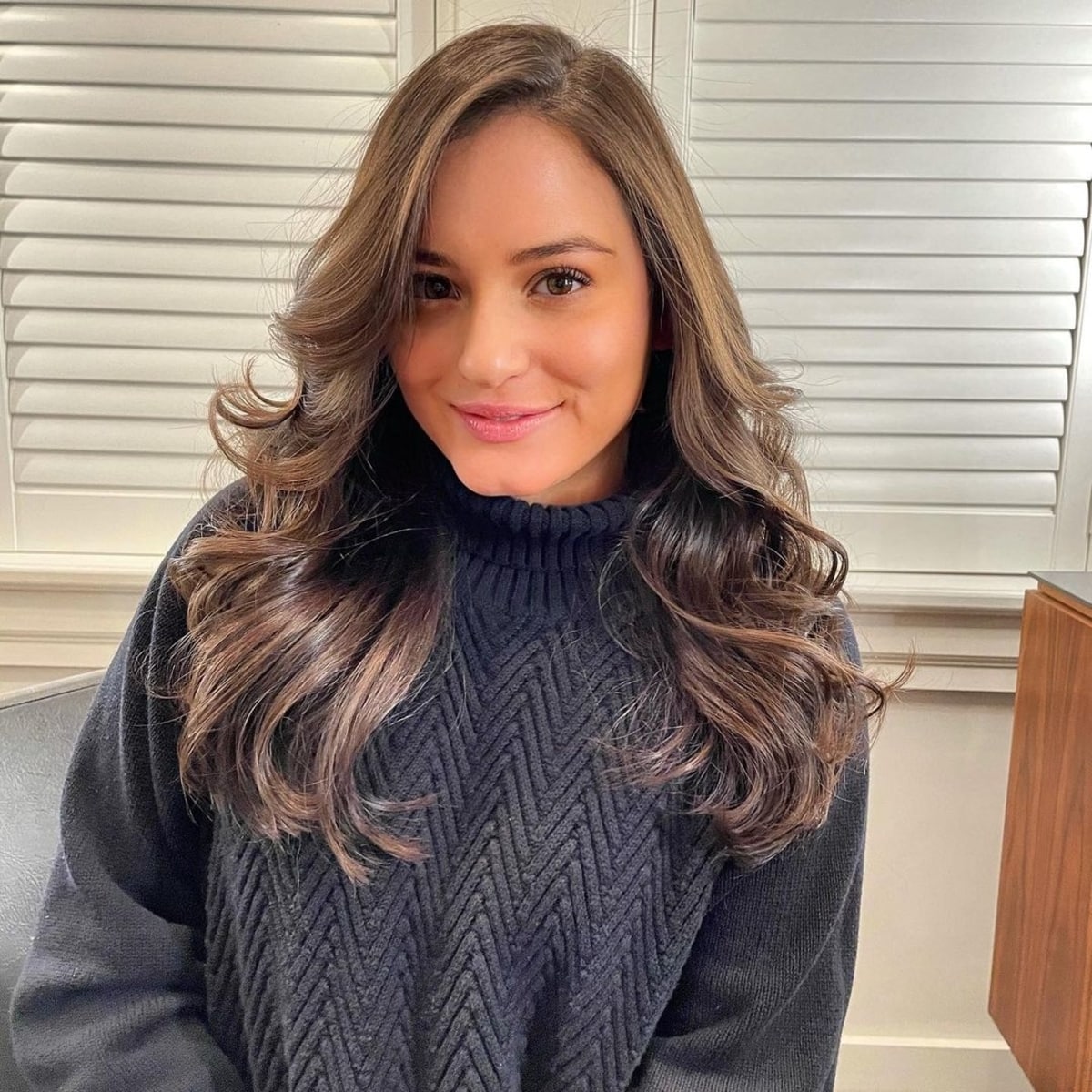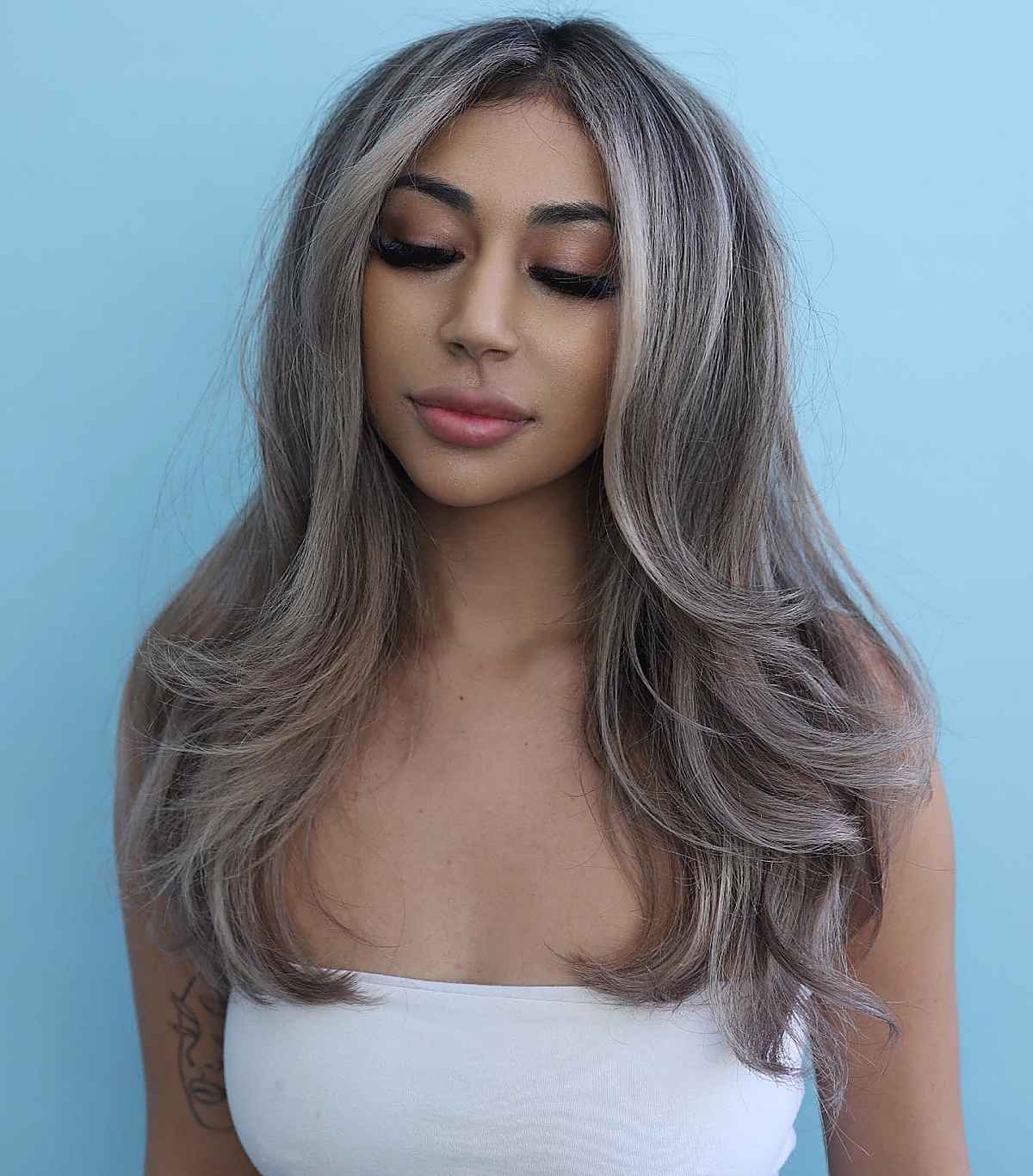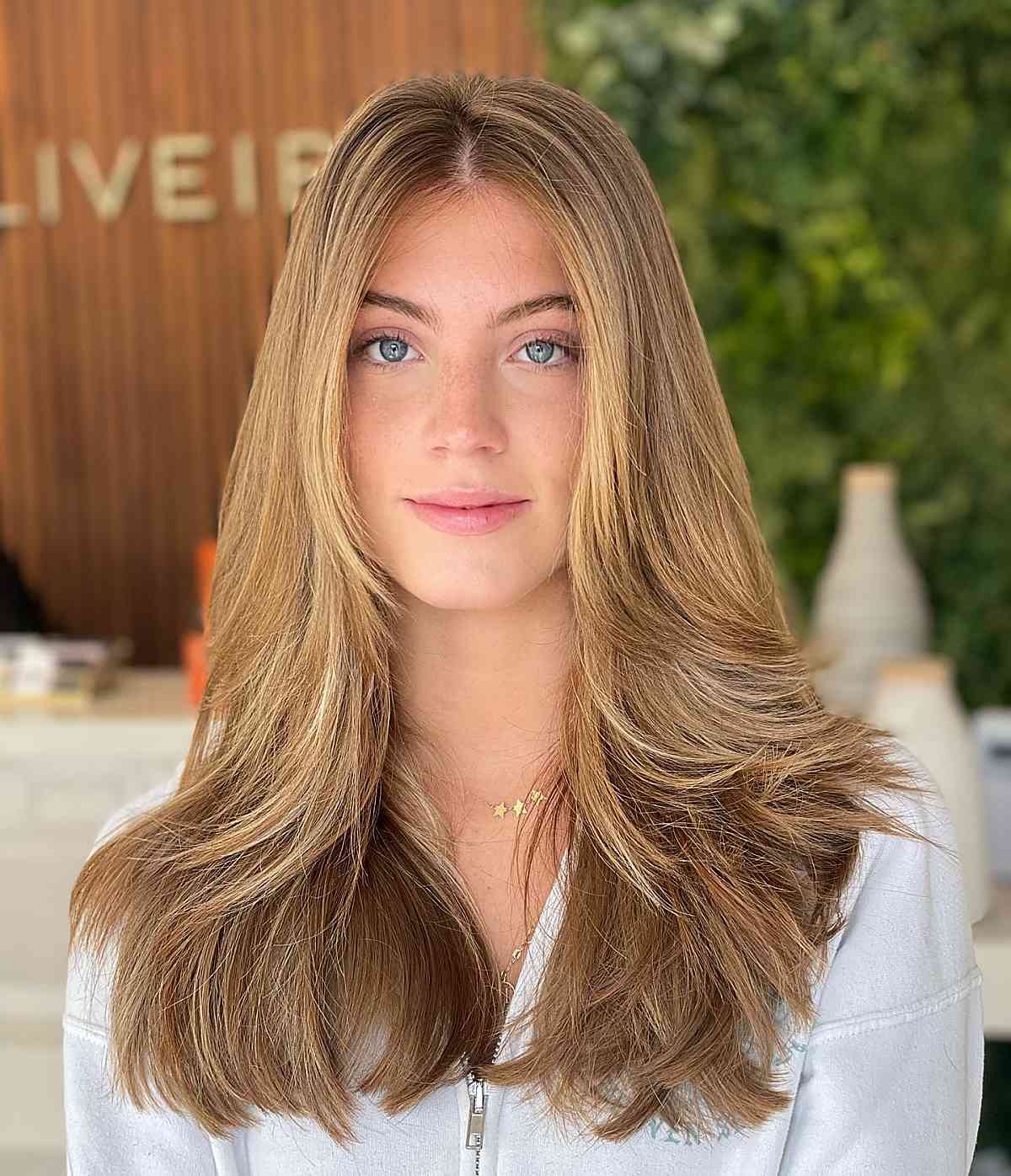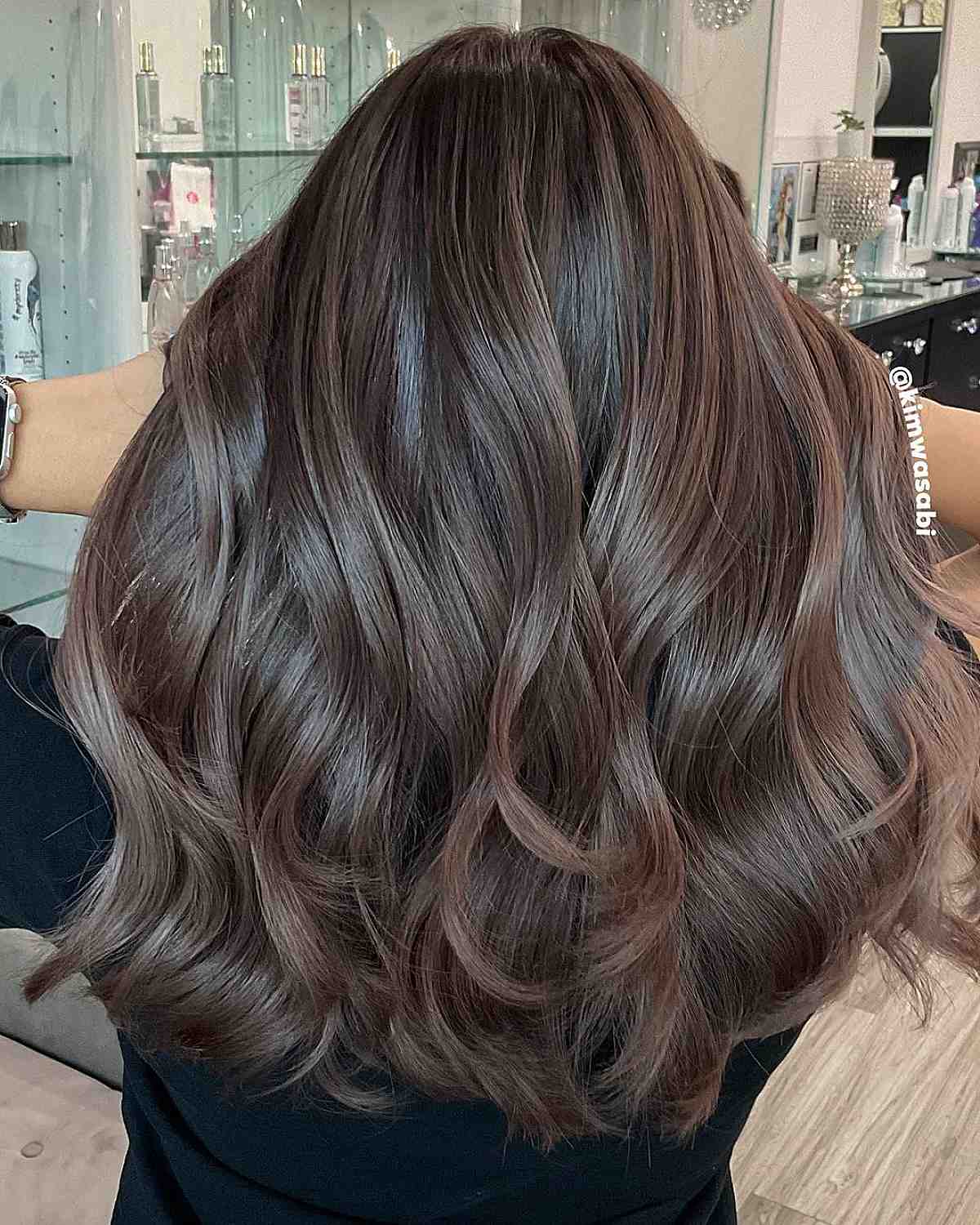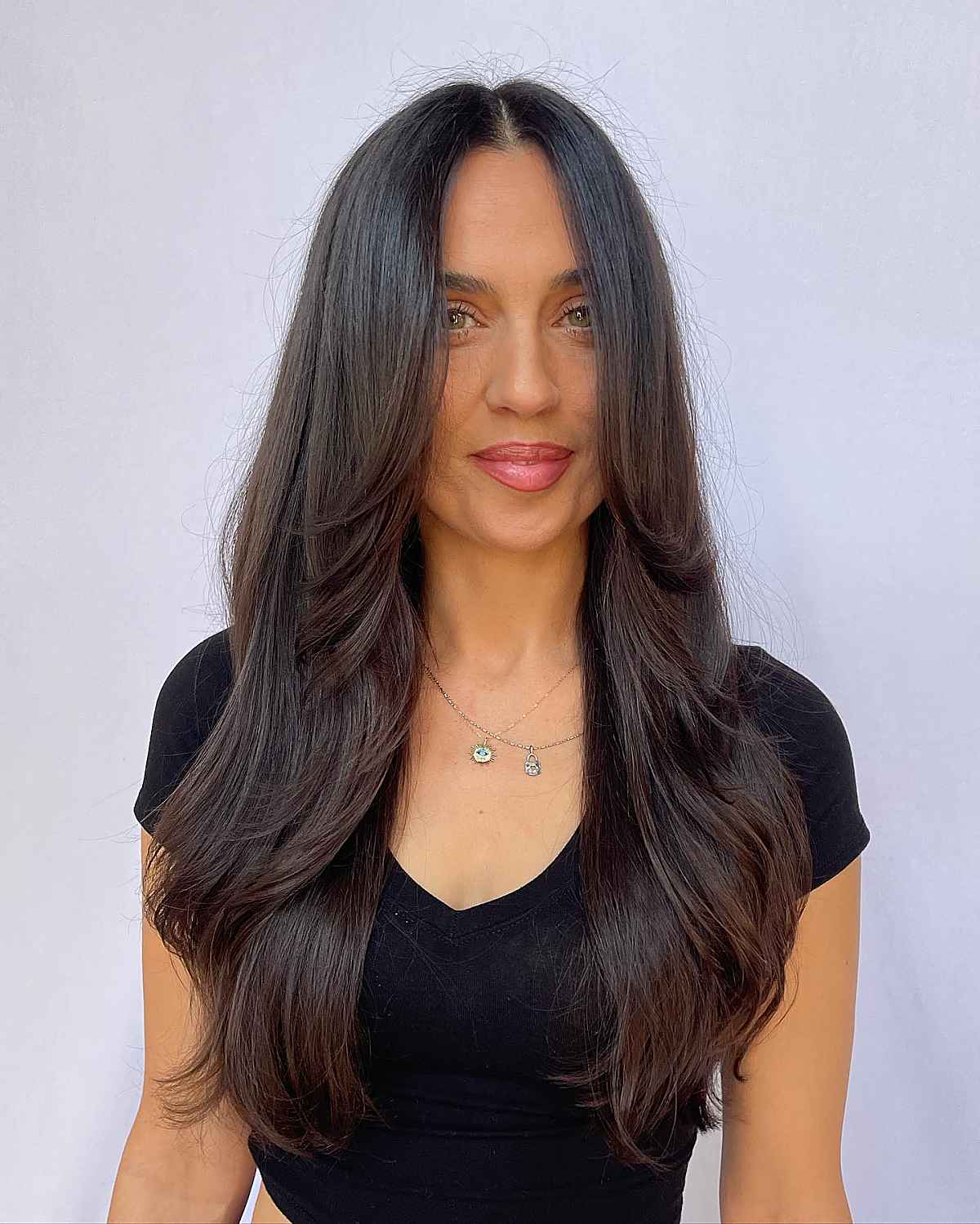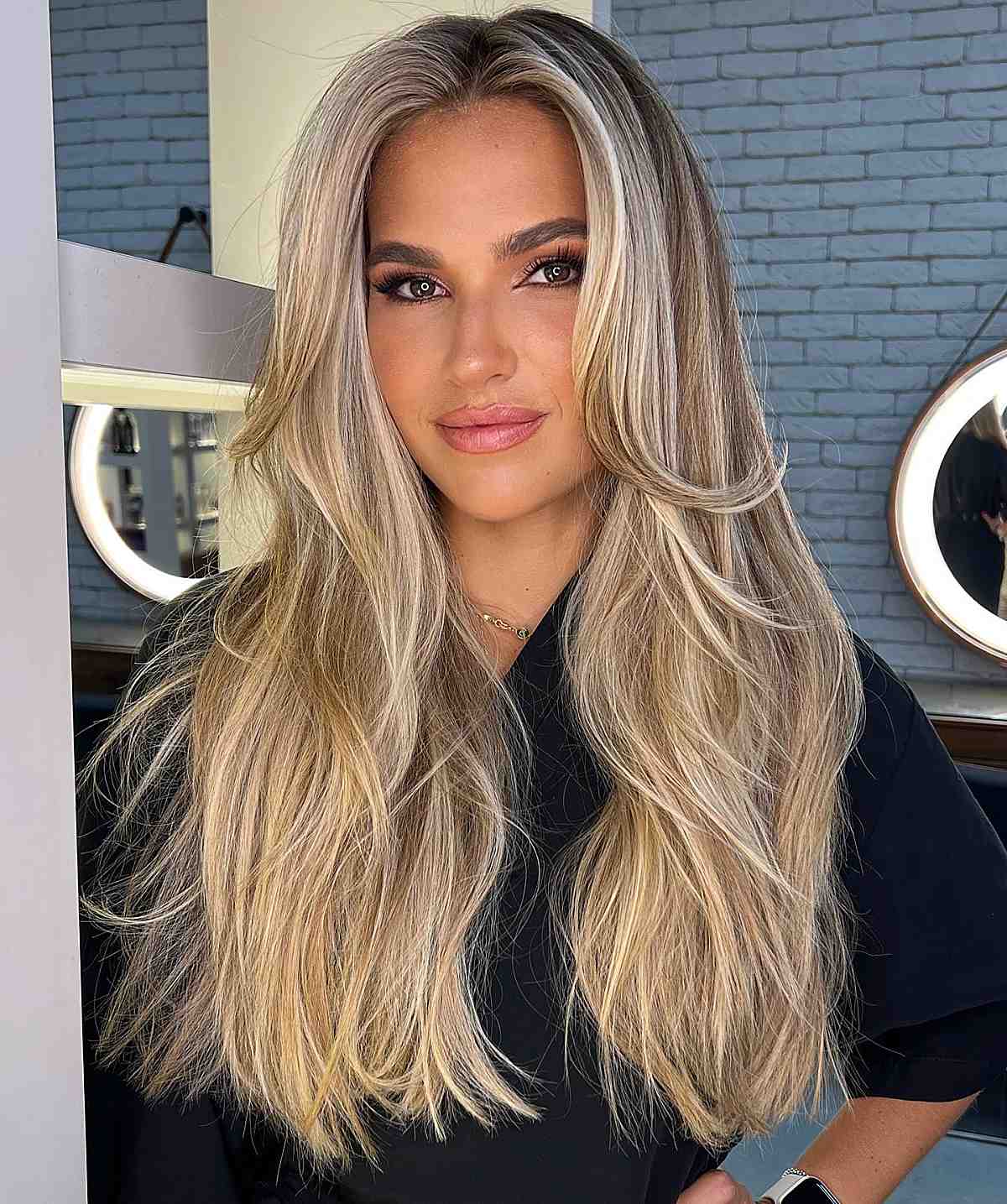We’ve all heard the tale of Rapunzel and her incredibly long hair. But being a woman with long hair is no fairy tale. There are so many challenges that no one seems to talk about! I’m talking about tangles, split ends, frizz, and how heavy your hair gets as it grows longer. We may not have fairy godmothers like some princesses do… but we have hairdressers! As a hairdresser, I’m familiar with long-hair life’s struggles. That’s why I put together this guide and gallery on the best layered haircuts for women with long hair. Keep reading to learn about types of layers, the best hair colors, and styling techniques. At the very end, you’ll find a photo gallery jam-packed with ideas to inspire your next haircut.
What is a Layered Haircut?
Shorter lengths throughout the hairstyle characterize a layered haircut. The layers are blended into your ends, so there isn’t a choppy line between the two. (Source)There are quite a few ways to cut layers, which I’ll get into shortly. The one thing all layers have in common is that they don’t add volume. This is a widespread misconception! Layers reduce weight and bulk from the interior of your hair. Layers also add a lot of versatility to any haircut. A blunt cut looks best when parted and styled one specific way. Layered haircuts, however, can be parted and styled in any way you like. They’re also suitable for any hair type. Whether you have straight hair, thick hair, curls, coils, or waves, the right layered haircut will make your hair look amazing.
Why Do Layers Add Movement to Long Hair?
When your hair is all one length, every strand weighs the same amount. That means your hair will be pulled down by gravity evenly. Even when you tousle your hair, the weight will gradually cause each strand to fall back into place. Layers create many different lengths throughout your hair. The pieces a few inches shorter than your ends weigh less, so they move a little differently. Remember a moment ago when I said layers reduce weight? More movement is the result. This is especially true if you have any kind of waves, curls, or coils in your natural texture. Removing weight allows each strand of hair to lift, bounce, and curl more.
The Types of Layers You Can Get with Long Hair
Every type of layered cut indeed adds movement by reducing weight. But that’s about what all the different types have in common! Here’s a glossary of the various layering methods:
- Long layers gradually increase in length. The shortest layer is at your crown; the longest layer is at your ends. This option adds movement and shape to your long hair without losing length. Long layers tend to be very blended, making them almost invisible to the eye. But your hair will still feel lighter and have more movement. These only need trimming 2-3 times a year. Kim Kardashian is almost always wearing long layers.
- Choppy layers create a textured, uneven, and sometimes jagged look. This cutting technique adds movement, volume, and dimension to your hair. They’re obvious and don’t blend seamlessly with your ends. This layering method requires the most maintenance. The choppy texture will grow out within 8 to 10 weeks. Jennifer Aniston rocks the choppy look now and then.
- Shaggy layers are characterized by their textured and messy appearance. The look is achieved by cutting layers into your hair at different lengths. This creates a naturally uneven or lived-in result. Think of these as a slightly softer version of choppy layers. These tend to need trimming every 10 to 12 weeks. Billie Eilish has worn several varieties in recent years.
- U-shape layers are achieved by cutting your hair, so the layers in the front are shorter than in the back. If you like having long hair but want to lift the appearance of your face, u-shape layers are perfect. You can get away with trimming them up just 2 or 3 times a year. But you may need more frequent trims if you have bangs or face-framing too. Chrissy Teigen often opts for these when she wears her hair long.
- V-shape or inverted layers are essentially the opposite of a u-shape. You’d have longer layers in front and shorter ones in the back. But these layers work best on angled bobs. It’s not possible to pair these layers with long hair.
- Asymmetrical layers aren’t the same length on both sides of your head. Asymmetrical layers paired with a side part create volume in all the right places. But the asymmetry can be anywhere—short layers in your crown and longer layers around your face, for example. Ask your stylist for their recommendation based on your part and bone structure. Upkeep in terms of trims varies a lot since these layers are so customizable. Taylor Swift chooses asymmetrical layers when her hair is long.
- Curtain layers refer to your hair being cut into long layers that fall in a curtain-like fashion. The long, graduated layers frame your face and create a softer, more natural feel. These layers typically start around your chin or collarbone. Then they get longer towards the back of your head. These grow out naturally, so you’ll only need trims a couple of times a year. Nicole Richie looks unbelievably chic with her curtain layers and bangs.
- Concave layers are a complex and effective cutting technique. The layers are cut at an angle. This creates a concave shape that follows the natural curve of your head. The layers are shorter in the crown area and get longer towards the front. Concave layers are excellent for adding shape and definition to curls. But you’ll need these trimmed every 10 to 12 weeks to keep the cut looking good. Zoe Saldana appears to have concave layers when her hair is long.
The Best Hair Color Options to Pair with Long Layers
There are so many hair color options that can pair well with long layers. That’s because the layering adds lots of dimension and movement to your hair. Some of my favorite options include:
- Balayage: This technique involves hand-painting color onto your hair, creating a natural-looking gradient of color. It’s a perfect way to subtly draw attention to your long layers since this method creates a sun-kissed look. You only need to touch it up a couple of times a year.
- Ombre: Like balayage, ombre involves a gradual blend of color from your roots to your ends. If you want a low-maintenance hair color that makes a statement, an ombre might be perfect. You can also pair this with a couple of highlights around your face to brighten your appearance. Touch-ups are only needed for face-framing pieces or anytime you cut off a few inches.
- Sombre: Sombre is similar to the ombre technique but even more soft and subtle. This is the way to go if you want to walk out of the salon looking like you just spent a couple of weeks on the beach. You won’t need to touch it up unless you chop a few inches off your ends.
- Single-process color: This technique involves coloring your entire head of hair in one solid color. Darker shades will make your layers invisible, making your hair look thick. Lighter tones will show off your layers when the light hits them just right. You’ll need a root touch-up every two months or so.
Ultimately, the best hair color option depends on your personal preferences and the look you envision. Think about your sense of style and how much maintenance you’re willing to commit to. The last thing to consider is the actual color/tone of your hair. Your hairstylist can help determine which shades will be most flattering to your skin and facial features.
Choosing the Right Long Layered Haircut
Now that you know all the terminology, I can talk more about you. The most flattering long layered haircut for you will work well with your hair type and suit your face shape.
Your Hair Type
For your hair type, we need to consider three things: density, thickness, and wave pattern. Density refers to how many hairs you have per square inch on your head. Thickness refers to the thickness of each individual hair. Any thickness can be paired with any density and wave pattern! So you’ll pick one from each of the three categories below.
Thickness:
- Fine hair will look flatter the more you layer it. So, long layers (or long choppy layers) will give you the most lift and movement.
- Medium hair will also have less volume when layered. U-shaped layers will be easiest to style if you have this hair type. But you can also try curtain layers or shaggy layers if you want something trendier.
- Coarse hair has a lot of flexibility. It’s easy to create a shaggy or choppy look. Long layers or u-shape layers can work well too. But your stylist will need to spend some time blending it all together. You may need more frequent trims with long or u-shape layers.
Density:
- Thin hair looks thinner the more it’s layered, much like fine hair. Stick with long layers and bangs to give your hair more movement.
- Medium-density hair is very versatile. Any type of layering will add movement to your long hair. Consider how much upkeep you’re willing to commit to, your face shape, and go from there.
- Thick hair has the most versatility because you have so much hair on your head. Long layers will add little movement, though. Asymmetrical, concave, shaggy, or choppy layers best suit your hair type and reduce weight.
Wave pattern:
- Straight hair doesn’t tend to get poofier as it gets longer, unlike waves and curls. Any layered haircut for long hair will look great. If you want choppy or shaggy layers, your stylist will need to spend some extra time creating this effect. But it’ll look good in the end.
- Wavy hair is ideally suited to concave or asymmetrical layers. Your stylist can evaluate your natural waves to determine the best technique. Just avoid long layers, as they’ll grow out very fast.
- Curly hair also plays well with asymmetrical and concave layers. Again, your natural curl pattern will indicate what’ll look best. Shaggy or choppy layers won’t be noticeable in your hair due to the curls.
- Coily hair won’t look good with long or u-shaped layers. The shaping just isn’t beneficial to this curl pattern. But again, asymmetrical and concave layers are your best friend. You can ask your stylist about asymmetrical concave layers if they specialize in coily hair.
Your Face Shape
Your face shape is another significant factor to consider for your layered haircut. The right type of layers can bring attention to all your best features… and the wrong type will do just the opposite. So, here are my customization tips for each face shape:
- Diamond face shapes look fantastic with long or concave layers. This gives you sleekness around your cheekbones and lots of movement around your jawline. These two factors will make your face look balanced and more oval.
- Heart-Shaped faces require bringing your forehead into balance. Curtain layers will frame your face beautifully and create the sought-after oval illusion. Choppy layers can also add texture and create that balance.
- Oval face shapes are considered ideal in modern society. You can wear any types of layers you like. Think about the facial features you want to draw the most attention to or from. Share this info with your stylist, and you’re good to go!
- Round face shapes look best with long layers. The longer your layers are, the longer and slimmer your face will appear. You can also try asymmetrical layers if you part your hair to one side or like to tease your crown area.
- Square faces can be softened with u-shaped layers. The shorter lengths around your face reduce hard angles and corners. Meanwhile, the longer pieces slim your overall face shape.
- Rectangle faces shine with u-shaped or shaggy layers. Ideally, you’ll want a few layers that graze your cheekbones. This will lift your face and make you look more youthful.
Do Bangs and Long Layers Look Good Together?
Yes, bangs and long layers can look great together. That’s because they add more dimension and interest to your hair. You can create various styles, depending on the type of bangs and how your layers are cut. Here are my favorite options to pair with long layered haircuts:
- Side-swept or swoopy fringe can add a soft, feminine touch to long layers. They’re also easy to grow out if you aren’t sure you’ll love them. These are ideal if you have a round or square face shape.
- Micro-fringe or baby bangs give your long layers an edgier, more modern style. Long layers tend to have a classic feel, so they’re an excellent way to change things. This option is best if you have an oval, round, or diamond face shape.
- Blunt bangs create a more dramatic look with long layers. They can also draw attention to your eyes and cheekbones. Blunt fringe looks best if you have a rectangle, heart-shaped, or oval face.
- Curtain bangs or bottleneck bangs are parted in the middle, creating softness. They can make your long layers feel more bohemian and lived-in. This style will look best if you have an oval, rectangle, or round face shape.
- Wispy bangs will make your layered long haircut look light, airy, and carefree. This type of fringe will have just as much movement and texture as your layers. Wispy is the way to go if you have a diamond face shape and want fringe.
Best Products and Styling Tips for Long Layers
A great layered haircut for long hair isn’t worth much unless you can easily style it at home. I’ve had long hair for the past decade, so I’m very familiar with the tricks that work… and the tricks that don’t. In the following sections, I’m sharing all my best advice to get the most out of your haircut.
Blow-drying Techniques
I notice people making the same mistake when it comes to blow-drying layered haircuts for long hair. It’s widespread to focus on your roots instead of your ends. But in reality, you should be doing the opposite. Starting at your roots reduces heat damage to your ends. It also gives you a smoother, more polished result. The easiest thing to do is blow dry your roots all over your head first. Then move on to the mid-shafts and ends. If your hair is fine—or you struggle with getting your blow-out to last all day—consider investing in sectioning clips. When you finish a section, wrap it up and clip it out of the way while it cools. Your volume and body will last all day when your hair cools in this position. You can also use the “cool” setting if your blow-dryer has one to speed up the process.
Curling and Straightening Techniques
While curling and straightening, you’ll use the same mentality as blow-drying. Your roots need the most heat and attention. Your ends need the least. So when you curl, start near your scalp. I know most of us grew up pinching our ends in the barrel and rolling up… but that’s precisely why we had so much frizz and breakage! The same is true for flat ironing. Start at your roots and slowly work your way down. Be sure to check your section size now and then. Whether you’re curling or straightening, your sections should only be a half-inch thick at most. Any thicker, and you won’t get all of your roots, leading to your style falling out later in the day. You’ll also want to be mindful of the temperature. If you have fine hair, keep your hot tolls between 250 and 300 degrees F. I know this might seem too low. If you’re struggling with this, move your iron slowly through your hair. Going slow at 300 degrees is so much better for your hair than going fast at 400 degrees. After all, there’s a reason that so many recipes have you heat the oven to 350 or so. Slow and steady wins the race—and doesn’t burn your hair. You can do between 300 – 350 degrees F if you have medium hair. For coarse hair, you don’t want to crank the iron up to 400. 350 to 375 is the safe zone for you.
Products and Tools to Use for Styling
As a hairdresser with a layered haircut for long hair, I have made tons of trial and error. I find my most significant challenges are tangles, a lack of volume, and getting my curls to stay all day. And I’ve heard these same woes from other ladies with long layered cuts. Tangles come with long hair territory. But I have a holy grail product I’ve sworn by for years: It’s a 10 Haircare Miracle Leave-in Spray. I love this entire brand’s lineup because every product is designed to multi-task in 10 different ways. This one, for example, prevents breakage, controls frizz, protects from heat, cuts down on tangles, and enhances your natural volume. And I have to say, and it does what it says. This brand also makes options for fine hair, coily hair, and heavily damaged hair. Just mist it onto damp hair, comb through, and style as desired. You can expect touchable softness that doesn’t feel greasy, heavy, or sticky. Next up is Amika Brooklyn Bombshell Blowout Spray. This product is somehow insanely lightweight yet infuses tons of flexible-hold volume. No crunchiness or anything like that. Split your hair into sections (I like to clip up the top so I can do my nape first) and apply from roots to ends. You’ll want to blow-dry for the most volume instead of letting your hair air dry. You can also mist a tiny amount on dry hair and then blow-dry your roots to refresh your style. Now you just need one more product to lock in your style. Since beauty school, my winner has been Paul Mitchell Awapuhi Wild Ginger Finishing Spray. I’ve tried many other brands, but this one takes the cake. You can mist it from arm’s length and brush through for a soft, brushable hold. Or if you need to be sure your ‘do won’t move, hold it more like 6 inches from your hair and mist. It smells incredible and it’s humidity resistant! And since I’m a hairdresser, you know I have my favorite tools. The Good Hair Day Platinum Styler is one of my favorites. It takes the guesswork out of styling by automatically calibrating to the best temperature for your hair. 250 times per second, the internal computers check to make sure the temperature is right. And you can use this flat iron for curling or straightening. I’m all about tools that multi-task! It also shuts off after half an hour, which has helped me more times than I can count. It’s an investment, but it’ll pay off for years.
How to Communicate with Your Hairstylist
Even with all this new knowledge, are you nervous about chatting with your hairstylist? As a hairdresser myself, I’ve seen first-hand how anxious the consultation can make clients. The first thing I want to say is that we don’t expect nor require you to know all the lingo. What we really want is to understand what you’re not liking about your hair currently and the benefits you want from your new cut. So don’t worry about remembering the name of the type of layers you want to try. Instead, consider what’s important to you regarding maintenance, current frustrations, and desired benefits.
Maintenance and Upkeep
The great thing about layered haircuts for long hair is how low-maintenance they are. Except for choppy layers, bangs, or root touch-ups, you’ll only need trims every 3 to 6 months. If you plan on adding any of these options, talk with your hairdresser about maintenance. We’re always willing to do what we can with your budget and the time you have. If you can’t make appointments more than twice a year for any reason, just let your stylist know. You may need to compromise on your desired style to find something more low-maintenance.
Talking with your stylist is the best way to find that perfect happy medium. So for long layered cuts, most of the upkeep discussion will center around home care. Do you plan on styling with hot tools every day? Or do you throw it into a bun/ponytail each morning? On that note, do you need to be able to pull everything back? Or would you like some shorter pieces to fall out of your hair elastic and frame your face? Think about the requirements of your job, family, classes, or whatever your routine involves. You want to be able to tell your hairdresser something like, “I need to be able to pull everything back into a high bun quickly for work. But I also like curling my hair and wearing it for certain occasions.” That gives your stylist a great idea of which layers will suit you best.
Your Desired Benefits
Any good haircut should draw attention to your best features and distract you from anything you don’t love. Take some time to look through photos of yourself, or even get in front of a mirror for a few minutes. Are you hoping to make your eyes stand out? Do you feel like your forehead is too wide? Are you hoping to make your face look longer or draw focus to your bone structure? As hairdressers, we speak the language of benefits. When you sit down and say you want choppy layers, our first question will be “Why?” Layers have very different effects on each hair type, you see. And when we know how you picture day-to-day life with your new layered cut, we know how to customize it for you. In addition to the above statement about your routine, be prepared to discuss your desired outcome. Telling your stylist something like, “I want my hair not to be so heavy when I put it up., But I also don’t want to lose much length. I’d also like something to make my eyes stand out,” gives that stylist a lot of great information.
The Best Layered Haircuts for Long Hair to Have More Movement
You’ve learned so much today! You’re now 100% ready to pick out some inspirational photos for your long layered haircut. Best of all, you can have complete confidence you’re picking a flattering style that fits perfectly with your lifestyle. Take a peek at the photos below. And don’t forget, hairdressers can usually combine the features of 2 different cuts if you’re torn.
